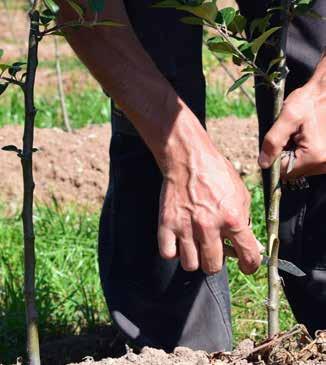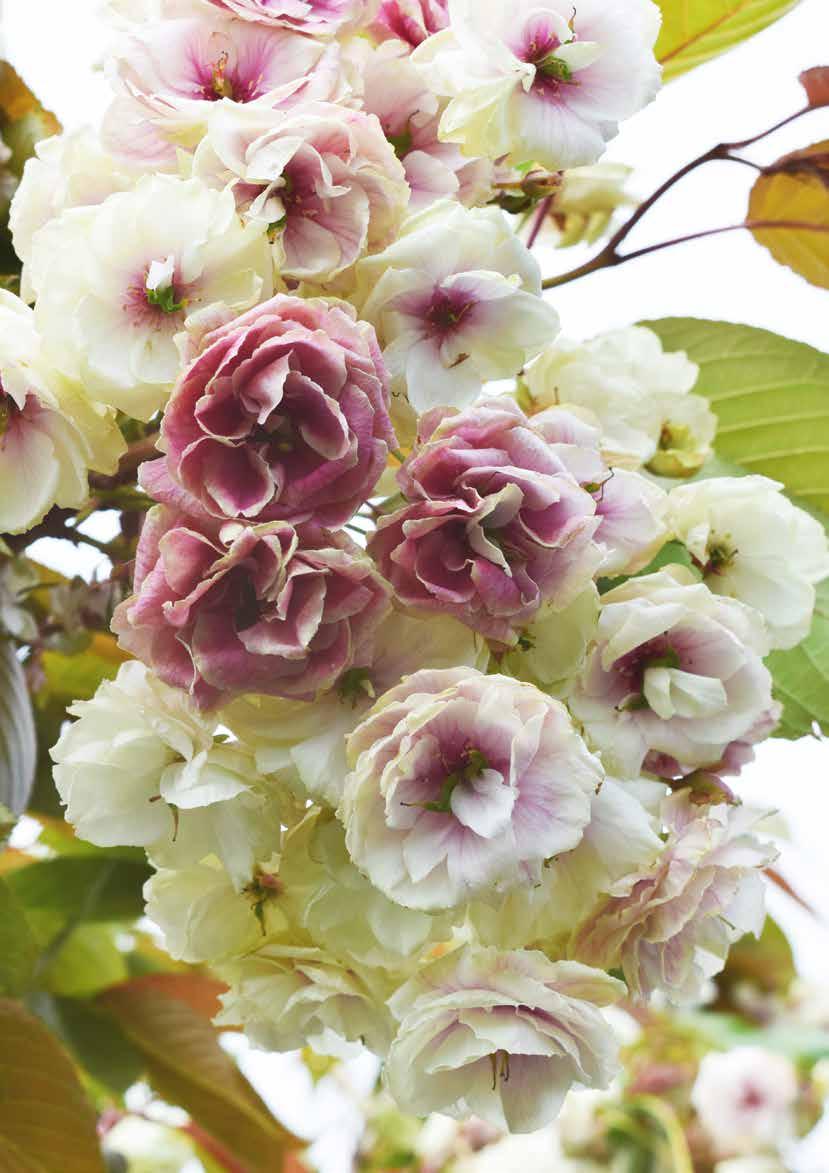
CATALOGUE 2025 - 2026


CATALOGUE 2025 - 2026

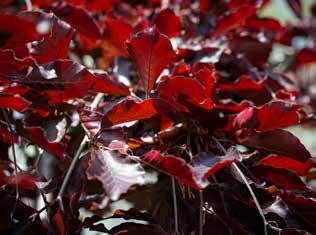
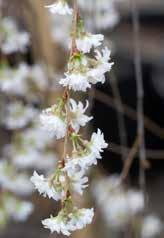
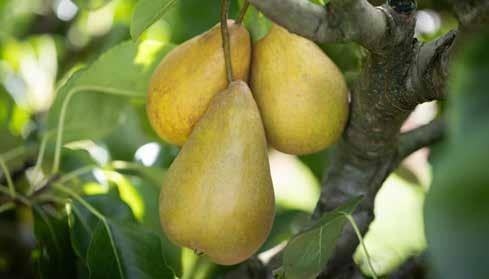

Established in 1901 this family business, now in its fourth generation, has grown to become an assured and reliable supplier to commercial and private customers, offering a diverse range of ornamental and fruit trees.
Frank Matthews Ltd is one of the UK’s leading nurseries renowned for its high quality trees, specialist knowledge and valued customer support
Working with some of the most formidable breeders of woody plants this company regularly introduces spectacular and innovative trees to its range� During its continual growth over many decades the company has always enthusiastically embraced its environmental and sustainability responsibilities�



We were absolutely thrilled to have exhibited at the prestigious RHS Chelsea Flower Show 2025 for the first time this year. We had an incredible debut and are pleased to announce that our display was awarded a Silver-Gilt award!
Simultaneously blossoming over 35 varieties of Malus trees along with examples of formally trained fruit trees was no easy task but what an incredible journey it has been with visitors to the show seeing Malus in a whole new light�
It was also the first time in RHS Chelsea Flower Show history that there has ever been a tree exhibit focusing solely on Malus, all in flower at the same time!
The exhibit highlighted the striking diversity of the Malus species, showcasing their flower colours, unique flower forms and tree shapes Malus (the Latin name for Apple), commonly known as crab
apples, are often overlooked for their beautiful blossom and considered solely for their fruiting habit, yet they offer a fantastic range of colours, flowers, and fruits From small, showy trees, upright forms to larger, majestic specimens, these trees play a vital role in creating vibrant, pollinator-friendly gardens; producing vital food sources over not one but two seasons, acting as natural bird feeders during the Autumn
The team have had some fantastic coverage over the duration of the show featuring on the RHS Chelsea BBC Gardeners World Special on Sunday 18th May
Almond (Prunus) Ingrid page 10
Apple (Malus) Bramley 20 page 11
Apple (Malus) Bramley's Seedling ���������������� page 11
Apple (Malus) Christmas Pippin® page 12
Apple (Malus) Cox Self Fertile ����������������������� page 12
Apple (Malus) Herefordshire Russet® page 14
Apple (Malus) James Grieve page 14
Apple (Malus) Red Falstaff® page 17
Apple (Malus) Red Windsor® page 17
Apple (Malus) Rosette™ page 17
Apple (Malus) Scrumptious® page 17
Cherry (Prunus) Morello �������������������������������� page 23
Cherry (Prunus) Stella page 23
Cherry (Prunus) Sunburst
page 23
Damson (Prunus) Merryweather page 25
Fig (Ficus) Brown Turkey page 26
Gage (Prunus) Old Greengage page 27
Mulberry (Morus) Chelsea (King James I) page 30
Peach (Prunus) Peregrine page 31
Pear (Pyrus) Concorde page 32
Pear (Pyrus) Conference�������������������������������� page 32
Plum (Prunus) Marjorie's Seedling page 36
Plum (Prunus) Opal
page 36
Plum (Prunus) Victoria page 37
Walnut (Juglans) Broadview page 40
Acer rub ‘Brandywine' page 47
Amelanchier lamarckii page 50
Betula pen ‘Fastigiata Joes'® (JOLEP 1) page 51
Betula uti ‘Snow Queen' ��������������������������������� page 52
Betula uti jacquemontii page 52
Cercis can ‘Eternal Flame’® ���������������������������� page 56
Cercis can ‘Forest Pansy' page 57
Cotoneaster fri ‘Cornubia' page 60
Crataegus x med ‘Pauls Scarlet' page 61
Liquidambar sty ‘Worplesdon' page 69
Magnolia ‘Black Tulip'® page 69
Malus ‘Aros'® page 72
Malus x rob ‘Red Sentinel' ������������������������������ page 74
Prunus ‘Beni-yutaka' page 78
Prunus ‘Crystal Falls'® ������������������������������������ page 78
Prunus cer ‘Nigra' page 78
Prunus ‘Kanzan' page 80
Prunus ‘Kiku-shidare-zakura' page 80
Prunus ‘Little Pink Perfection' page 80
Prunus ‘Royal Burgundy' page 81
Prunus x sub ‘Autumnalis Rosea' page 82
Robina ‘Frisia' �������������������������������������������������page 84
Sorbus aria ‘Lutescens' page 86
Sorbus ‘Autumn Spire'® (Flanrock) ���������������� page 87
Sorbus ull ‘Olympic Flame'™ page 89
You’ll find more best selling trees in the main listings - look for the symbol!
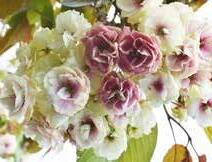
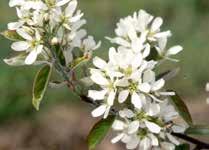
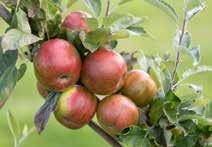



A few of the many new varieties added this year Look for the new symbol throughout the catalogue!
1. Prunus ‘Sumaura Fugenzo Japanese Lantern™'
A very impressive Japanese flowering cherry Stunning, densely double frilled flowers with white, pink and green petals
See page 82
2. Amelanchier canadensis ‘Prince William'
A deciduous shrub to small tree with showy white blooms in spring followed by edible purple-red fruits
See page 49
3. Apple Rainbow (Eric’s Rainbow®)
A unique stripy apple which also has an attractive gold spot to the centre of each leaf and multi-coloured striated bark!
See page 16
4. Betula pendula ‘Golden Obelisk'
A distinctive columnar variety with fresh yellow-green foliage
See page 51
5. Cercidiphyllum japonicum ‘Raspberry'
Very attractive, Japanese deciduous tree Bronze leaves when young, turn rich green, then pink, oranges, and reds in the autumn
See page 56
6. Cercis canadensis ‘Zig Zag'®
Produces unique zig-zag shaped branches which create a striking shape, especially in winter
See page 57
7. Chitalpa tashkentensis ‘Summer Bells'
Small tree covered in dark green, narrow, lance-shaped leaves
See page 57
8. Lagerstroemia indica ‘Eveline'
A compact variety Long summer flowering tree with large, beautiful, pastel pink flowers
See page 68
9. Parrotia persica ‘Cherry Tips'
An upright Persian ironwood with beautiful, cherry red autumn foliage
See page 76
10. Peach Bonanza
A naturally dwarf Peach and one of the first genetically dwarf selections.
See page 31
11. Persimmon Rosseyanka
This hardy variety is prized for its cold tolerance, and deliciously sweet fruit, making it more suitable for the UK.
See page 34
See page 82 2 3 12 9 6
12. Prunus ‘Tiltstone Wildfire'
An upright, columnar flowering cherry, covered in light pink blossoms in early spring
The best time to plant a container grown tree is from mid August to the end of May Summer planting (June and July) is possible but weekly watering would be necessary (a bucket a week!) The best time to plant a bare root tree is from November to March� Below is our step-by-step guide for you to follow

Step 1 – Remove the turf and dig a hole twice the size of the rootball

Step 4 – Add a sachet of Rootgrow® into the soil
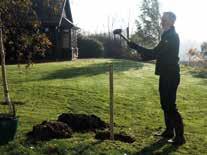
Step 7 – Knock In a tree stake.
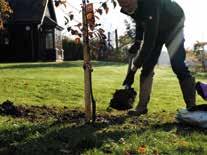
Step 10 – Add mulch of bark chippings
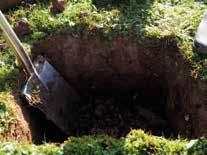
2 – Break up the soil at the bottom of the hole.

Step 5 – Add compost if the soil needs improving

Step 8 – Remove the pot and tease out any roots or prune the roots for bare root

Step 11 – Add the tie and guard and water thoroughly


Step 3 – Soak the roots in water

Step 6 – Water thoroughly

Step 9 – Fill the hole around the tree and firm in well.
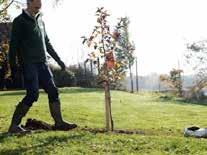
Step 12 – Planted

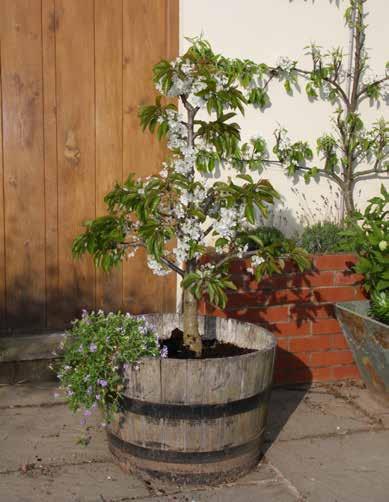
The below trees are just a handful of varieties and groups that work brilliantly for smaller spaces and patio growing. Trees do not have to be big and can offer structure, autumn colour, winter bark, summer foliage, fruit and interest for all year round
• Acer palmatum
• Albizzia
• Amelanchier
Calycantus
• Ceanothus
• Cercis
• Hamamelis (Witch Hazel)
• Bush Magnolia
• Malus (Crab Apples) particularly on M27 rootstock
• Top worked Prunus (Ornamental flowering cherries), weeping and incisa forms�
• Sorbus (Rowan)
• Syringa (Lila)
• Fruit on dwarf rootstocks such as M27 for Apples, Quince Eline for Pears, Gisela 5 for Cherries and naturally dwarf and columnar varieties such as Mirabelle Ruby and Peach Bonanza and Nectarine Necarella
• Trained fruit trees including Fan, Espalier, Cordon and Stepover forms (see page 96) perfect for small spaces, against fences or walls�
Look out for the very small and small symbols throughout the catalogue as well as the upright tree form.
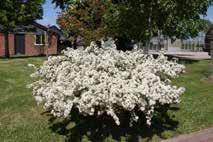
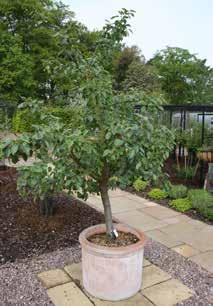

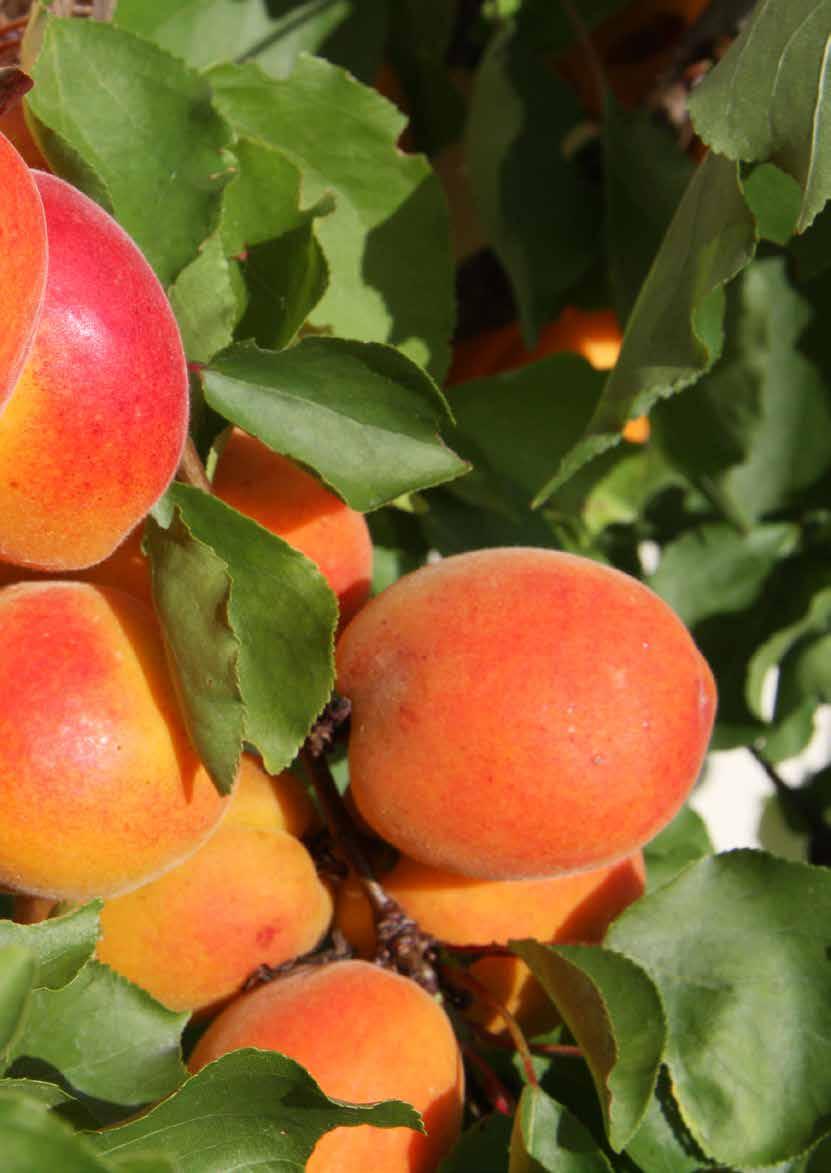
Picking Month: September
The most reliable cropper of the selected Almond varieties Excellent fruiting quality, nuts are pale green with a velvety texture and delicious flavours Striking light pink blossom in the spring and reasonable leaf curl resistance Best planted in a sheltered position
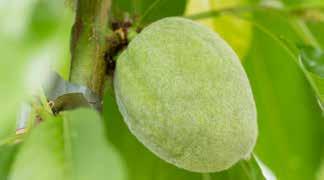
Adam’s Pearmain
Picking Month: Mid October
A distinctive, late high quality dessert apple The fruits have extremely attractive lenticel spots on reddish-brown smooth skin. Rich, aromatic and nutty in flavour with juicy and crisp flesh. An excellent keeper (Norfolk, 19th Century)
Picking Month: Late September
Well flavoured bittersharp, compact growth habit. Yellow-green background with a strong dark red flush Sometimes producing pink juice 5
Annie Elizabeth
Picking Month: Early October
A traditional English apple Large, round-oblong fruit with cream flesh Sweet, light flavour and an excellent cropper Perfect for stewing, needing very little sugar. Resistant to scab, canker and mildew (Leicestershire, 19th Century) 4
Arthur Turner
Picking Month: Mid September

Picking Month: October
3 3
Large yellowish-green, tough skinned fruits Cooks to a delicious golden purée, needing hardly any sugar Good for pies as it can be picked green for early use. Known for it’s exceptional display of attractive light pink blossom in the spring. (Buckinghamshire, 1912)
Ballerina Samba®
Picking Month: October
A much improved Ballerina Apple, more compact and vertical in habit Fruits are yellow flushed bright ruby-red Flesh is crisp, juicy and fresh with a sweet and sharp taste Beautiful clusters of deep pink blossom in spring. (Kent, 1996)
A spectacular, star shaped apple with 5 angular sides, rather than the typical rounded shape. Yellow with orange flush. It tastes delicious eaten or cooked and the apples can be used for decoration purposes Store until Christmas
Ashmead’s Kernel
Picking Month: Early October
4
A traditional English russet and one of the best late dessert apples Pale green fruit with a strong, sweet-sharp, acid drop flavour and a juicy white flesh The sweets known as pear drops is the essence of the flavour Good for juicing (Gloucestershire, 17th Century)
Bardsey
Picking Month: Mid September
The ‘sainted’ apple found on Bardsey Island. This pink over cream skinned apple has an extraordinary lemon scent and a fine refreshing flavour Pleasant for eating fresh, can be juiced and cooks well Also very hardy. (Ynys Enlli, Wales, 1998) 2

Picking Month: Early August
2
Remarkably early, hardy dessert apple Produces a heavy crop of bright red flushed on pale yellow fruits The flesh is often pink under the skin, sweet and very juicy The fruit is best picked early before it drops Delicious eaten straight from the tree (Somerset, 19th Century)
Picking Month: September
Picking Month: October
5 2
An early popular eater Dark maroon flush and red stripes over green background, crisp with a sweet strawberry/raspberry flavour Picks in early September and will store for a couple of weeks (Cornwall, 1830)
Picking Month: Mid September
A very special apple Sweeter than Cox and with an improved aromatic flavour, crunchy, crisp and juicy Can be picked and eaten over a few weeks from mid-September onwards and stores well Named after Bladon Church (Oxfordshire) 3
Picking Month: Mid September
Bloody red fruit in appearance with knobbly skin and stained pink flesh Juicy and sweet in flavour with a crisp texture Good for cooking, eating and making cider An old variety which reputedly grew from a pip on the grave of a ploughman shot by a gamekeeper for stealing
Braeburn
Picking Month: Early November
Crisp, firm, aromatic fruit produces an all round excellent quality apple Performs best planted in a warm climate and a sheltered position An important variety for commercial growing (New Zealand, 1950s)
Bramley 20
Picking Month: Early October
A compact version of Bramley’s Seedling, 20% less vigorous with heavier crops Pale green flushed reddish-orange fruits that have an exceptional sharp flavour Delicious purée when cooked Highly recommended for the garden (Bristol, 1970s)
Bramley ‘Original’
Picking Month: Early October
Propagated from the original tree in Nottingham. Bright green fruits that are delicious cooked into pies, crumbles and sauces Creamy flesh with sharp, acidic flavour The original tree survived for over 200 years! (Nottinghamshire, 1809)
Bramley’s Seedling
Picking Month: Early October
The finest cooker in the world! The apples are greenish-yellow flushed light orange with russet spots A strong acid flavour, crisp and sweet-sharp bite after storing Makes a creamy, brisk-flavoured purée and tasty baked into tarts and pies (Nottinghamshire, 19th Century)
Browns
Picking Month: Mid October
Very vigorous, upright growing habit The waxy apples are dark red and even sometimes red fleshed. Produces a fruity, bittersharp cider Also a nice cooker with sharp taste and chewy texture A healthy tree (Devon, 20th Century)
An old Somerset cider apple, also known as Sweet Sheep's Nose Harvests in late October and is a pure sweet cider apple Was once a common apple in Somerset and Devon
Picking Month: November
5
Late, bittersweet cider apple that is slightly larger than others. A more vigorous sport of Dabinett, picking later. Dark purple flushed apples that make delicious full-bodied cider, without needing to mix with other varieties A healthy, disease resistant tree (Somerset, 19th Century)
Picking Month: Early October
A well known English heritage apple. Yellow-gold with orange flush and broken red stripes. Creamy white flesh, nutty taste and crumbly texture. Keeps its shape, flavour and colour when cooked. An old favourite! (Oxfordshire, 1740) 3
Bountiful
Picking Month: Late September
A classic English cooking apple Soft, juicy fruit with sweet flavour and a crisp texture The apple slices retain their shape when cooked Disease resistant A good garden tree that is easy to grow and very productive. (Kent, 1964) 2
Braeburn Mariri Red®
Picking Month: Mid November
A sport of Braeburn. Attractive, dark red in colour with very firm flesh, and sweet, sharp flavour A typical Braeburn, but more intense The most popular commercial orchard choice (New Zealand, 1990s)

Brownlees Russet
Picking Month: Early October
A late-season dessert russet apple A juicy flavour, sweet-sharp and nutty, just like acid drops. Skin is reddish-brown and very russetted. Known for its very attractive deep pink blossom in the spring and it's late storage into February An excellent garden variety
Picking Month: October
A very vigorous, spreading tree which is commonly used as a stem builder to develop strong trunks The large, yellow-green apples produce a medium, bittersweet cider with hard, bitter tannins.
Charles Ross
Picking Month: Mid September
A well known, easy to grow apple Sweet and juicy in flavour and also bakes well Delicious when picked and eaten straight from the tree or pressed into home-made apple juice A hardy variety for Northern areas (Newbury, 19th Century)
Picking Month: Early October
Golden crisp and juicy fruit, slightly waxy Sweet flesh and honey flavoured A good looking garden apple suitable for all areas Stores well into January (Cambridge, 20th Century)
Claygate Pearmain
Picking Month: October
A high quality dessert apple with a juicy rich, aromatic, nutty taste Orange-red flushed apples over greenish-yellow Showy pinkish-white flowers in the spring Suitable for northern and colder areas as it's very hardy (Surrey, 1921)
Picking Month: October
Attractive red fruits are wonderfully aromatic, juicy and crisp. A highly flavoured Cox type that is more disease resistant Very easy to grow and suitable for any area in the UK. Stores well. (Kent, 2008)
Picking Month: Mid October
High quality dessert apple Dark red flush with red stripes over gold. Knobbly exterior conceals yellow perfumed flesh. Intensely flavoured, rich and aromatic (Cornwall, 1800)
Court of Wick
Picking Month: September
A red flushed eater with russet freckled over gold Flesh is juicy and crisp with intense fruity flavour The medium-sized apples will hold onto the tree for quite a long time Makes a lovely cider and apple juice (Somerset, 1790)
Picking Month: Early October
The original Cox and the finest flavoured apple in the world Orange fruits over greenish-yellow Deep cream flesh that has sweet aromatic flavour and is firm, fine-textured and juicy (Buckinghamshire, 19th Century)
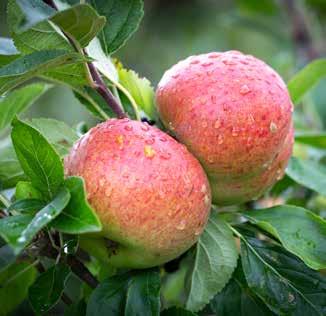
Christmas Pippin®
Picking Month: Early October
An exceptional, high quality eating experience with a beautiful honey flavour One of the very best recently introduced apples that stores well until Christmas Orange flushed, juicy and crisp fruits to make the perfect Christmas crumble (Somerset, 2011)
Cobra
Picking Month: September
The perfect dual purpose apple with a fine dessert flavour Refreshing acidic, tangy quality for a multitude of culinary uses from firm baked apples to pie fillings needing little added sugar. (Kent, 2007)
Picking Month: Mid October
A high quality, late dessert apple Handsome, bright red flushed fruits with russet patches Flesh is white, tinged green Firm and fine-textured with a sweet, sharp pear drop and spice flavour (Cornwall, 1813)
Picking Month: Early September
Fruit is delicately flushed over a golden colour Sweet, soft creamy flesh that’s lightly flavoured. Can be used as a cooker if used early Cooks to a brisk, lemon froth (Scotland, 1827)
Picking Month: Early October
A self fertile form of Cox’s Orange Pippin and the best selling eating apple in the world Orange over green fruits Creamy flesh that has a sweet, aromatic flavour and is juicy and crisp Highly recommended! (Bristol, 1975)
Picking Month: September
A fairly modern dual purpose cooking and cider variety, found in the 1990s near Taunton, Somerset and grown on in Devon Picks in early September A useful early sharp cider that can also be used for cooking. (Somerset, UK)
Picking Month: October
A late keeping dessert apple with an interesting hot, spicy nutmeg flavour A healthy, disease resistant variety Medium sized, bright green fruits. Enjoys the sea air. (Essex, 1780’s)
Picking Month: Early November
The most reliable cider variety. Has a bittersweet, high quality, medium-dry cider on its own Greenish-white, sweet and astringent Beautiful pink blossom that occasionally produces a secondary flower (Martock, Somerset, 19th Century)
Picking Month: October
A mid to late season cider apple that is also used for cooking Large pale yellow fruit with bright pink flush and russet at the base Soft creamy white flesh with a subacid, slightly sweet flavour (Devon)
Picking Month: Mid August
An attractive, well rounded dessert apple. Bright red flush and stripes Crisp and juicy with a hint of strawberry flavour An excellent early variety with good disease resistance Best eaten straight from the tree (Essex, 1949)
Dunkertons Late
Picking Month: November
The fruit is green flushed orange, turning slightly yellow when ripe and sometimes with a touch of red if sunny. A firm and cheesy texture, sweet in taste Makes a light, sweet and fruit cider (Glastonbury 1940s)
Egremont Russet
Picking Month: Early October
A good quality, mid-season apple Creamy-yellow flesh, sweet and firm with a distinctive rich, nutty flavour. One of the few russets available in quantity and an important commercial russet in the UK. (Sussex, 19th Century)
Picking Month: Early October
An excellent garden tree Rich in flavour, aromatic and sweet and crisp in texture Slightly ribbed, reddish-orange fruits Ideal for northern areas and a very heavy cropper. (Kent, 1972)


Picking Month: October
A late season cooking apple with a sharp, rich flavour, that is good for challenging sites in the West Country A reliable cropper producing green to gold fruit with a strong red flush (Devon)
Picking Month: October
A dual-purpose, non-browning apple for fresh eating and cooking Delicious, crisp, sweet and aromatic When cooked, the apples produce a snow white purée requiring no added sugar Also an excellent variety for juicing (Canada, 1970s)
Picking Month: Late September
A traditional English dessert apple Striped, red fruits Aniseed flavour develops after picking, retaining it’s melting juicy flesh. A healthy, disease resistant tree (Lincoln, 1904)
Picking Month: Mid September
Heavy cropping, compact cider apple Fruit is yellow with orangebrown flush. Mild bittersharp, acid slightly sweet taste. A healthy, disease resistant tree (Long Ashton, 1990s)
Picking Month: Early October
Reliable cropper of good, small, crisp and well-flavoured fruit
Golden-yellow, thin skinned One of the most popular eating apples in the world (New Zealand, 1934)
Picking Month: September
Dark red sport commercial clone of Gala A reliable cropper of good, small, crisp and well-flavoured fruit Only available on M9 rootstock
Pippin
Picking Month: Late September
Large and yellow apples with a russet freckle finish Deliciously sharp eater, and keeps its shape well when cooked Firm, juicy and crisp Sharp, slightly perfumed flavour (Wigtown, Galloway, 1871)
Picking Month: Mid September
The red apples produce a mild bitter-sharp juice. Heavy yielding early in life creating a weeping shape Can be planted close together
Golden Delicious
Picking Month: Late October
Well known, handsomely shaped eating apple The slightly ribbed fruit is sweet with a honey flavour making it a distinctive variety Superior to imported when grown in the UK. (USA, 19th Century)
Greensleeves
Picking Month: Mid September
A reliable mid-season variety Pale, greenish-yellow Crunchy, tangy, easy to grow eater A good pollinator for other varieties and easy to grow. (Kent, 1966)
Picking Month: Late October
A traditional English cider apple Greenish-yellow in colour, freckled and slightly striped dark red. Often known as ‘Port Wine’ for it's dark red fruits. Produces a full bitter-sweet tasting juice with a soft astringency A regular, reliable cropper (Somerset, 19th Century) 5
Herefordshire Russet®
Picking Month: Late October
3
A modern variety that is the russet with a Cox-like flavour Deep golden, russeted fruits with exceptional eating quality, rich aromatic flavour Heavy cropping and keeps well Makes one of the best single variety juices. (Kent, 2002)
Honeycrisp
Picking Month: Early October
A very attractive, high quality dessert apple. Impressive large apples, very crisp with a fizzy texture, sweet with pleasant mild flavours Non browning, so good for fruit salad Stores well in natural conditions (America, 1960s) 3
Irish Peach
Picking Month: Mid August
2
Small yellow fruit, flushed dark crimson with faint stripes Flesh is white tinged green, slightly perfumed and juicy Best eaten straight from the tree (Sligo, Ireland, 1819)

Golden Bittersweet
Picking Month: September
An old cider variety, sent to Hogg from Devon around 1884 Has a freckled and russetted appearance, sharp in taste and has very soft juicy flesh so easy to juice Picks in early September and will keep until October (Devon)
Granny Smith
Picking Month: Early November
A well known supermarket variety which is very successful within the commercial orchards Bright greenish-yellow, smooth, greasy skin and greenish-white, juicy, refreshing flesh (Australia, 19th Century)
Picking Month: August
A compact tree ideal for any garden Easy to grow and a good pollinator for Bramley Has excellent cooking qualities, making the perfect baker Very disease resistant (Buckinghamshire, 19th Century)
Picking Month: Mid September
Freckled, bright red fruits One of the best in the grower trials Produces astringent, sweet and acid cider Makes a wonderful shaped tree as it matures Good, regular crops but needs a good pollinator (Circa 1990)
Hidden Rose
Picking Month: October
(Syn: Airlie Red Flesh) Tart with a subtly sweet taste and a flavour that has been likened to strawberry lemonade Vibrant pink-red, juicy flesh. Greenish-yellow skin with a pink blush. Keeps well until January. (Oregon, USA, 2021) 2
Picking Month: Early October
3
One of the largest cooking apples in cultivation today! Yellow striped red apples which keeps its shape when cooked Sweet and juicy A good exhibition and garden variety (Isle of Wight, 1915)
James Grieve
Picking Month: Early September
Deservedly popular Red flush stripes over pale green fruit Creamy white, crisp and juicy flesh with a refreshing flavour Reliable cropper One of the best apples to accompany a cheese board (Edinburgh, 1893) 3
Picking Month: Late September
3
Dual purpose, mid-season apple Large, flushed and striped red on green and attractive red flecks. Golden cream flesh, acidic and aromatic Good for baking, retains colour and needs no sugar (Kent, 2000)
Picking Month: Mid October
3
A strikingly attractive large conical golden apple with a good sweet and acid balance. Keeps well into the new year. The tree is strong growing, healthy and predominantly tip bearing (Sussex 2022)
Jupiter
Picking Month: Early October
3
A popular garden variety Large Cox-flavoured apple, but a more robust variety Marbled red-yellow fruits with a sweet and juicy flesh. A strong growing tree. (Kent, 1966)
Katy
Picking Month: Early September
An attractive, early dessert apple. Heavy crops of bright red, sweet, juicy, acid and firm fruit Makes excellent juice, palatable cider and good for baking Also a good pollinator (Sweden, 1947) 3
Picking Month: Mid October
3
High quality, good Cox-alternative Bright, deep orange-scarlet apples with a sweet, crisp and aromatic flavour, with a good balance of sugar and acidity (New Zealand, 1924)
Picking Month: Mid October
Picking Month: Mid August
A heavy cropping, pale greenish-yellow apple Cooks to a cream purée, hardly needing sugar Soft flesh and acid-like flavour
Excellent cooker for tarts and pies, and even jelly and butter. Heavy crops (Lancashire, 18th Century)
Picking Month: Early October
Also known as Princess Pippin or Reine des Reinettes. An attractive, orange-red flushed green apple Firm, juicy and an aromatic flavour Keeps shape and colour when cooked. (France, 19th Century) 3
3 Kingston Black
Large fruit, green with brownish red flush and russet patches Very rich flavour with a crisp, juicy texture An excellent, late keeping garden apple Lovely eaten fresh (Hereford, 1899)
Laxton's Fortune
Picking Month: Early September
3
(Syn: Fortune) High quality, mid-season dessert apple, similar to Cox Pale green-yellow with bright red stripes and russet patches Creamy white flesh and sweet, aromatic flavour (Bedford, 1904)
Picking Month: Mid September
3
An improved Greensleeves type Clean, smooth, glowing greenishyellow, occasional pink blushed apples Crisp, refreshing and rich in flavour. Heavy cropping and disease resistant. (Kent, 2000)
Picking Month: Late September
4
Quality cooker for pies. Large, firm, attractive green fruit with a distinctive, ribbed angular shape Flesh is rather coarse-textured, sharp tasting Disease resistant (Cheshire, 19th Century)
Lucombes Pine
Picking Month: October
4
A good eating apple that is also great for juice, ripening to a golden yellow with russet dots The tender flesh is yellowish white with a rich, aromatic, pineapple like flavour. (Exeter, 1800’s)
Picking Month: Late September
Picking Month: November
A distinctive cider of excellent, single variety quality Small yellow-green fruit flushed dark red, almost black Dry, rich and fruity flesh. Named after the village of Kingston. (Somerset)
Picking Month: Early October
Sweet and aromatic Can be biennial bearing and also hardy Purple flush and red stripes gives this apple an old fashioned appearance (Bedford, 1897) 4
Little Pax®
Picking Month: October
3
A late season English apple. Very attractive ‘pearmain’ shaped, bright red fruit with attractive yellow lenticels. A superb sweet aromatic flavour Stores throughout winter (Isle of Wight, 2000)
Picking Month: Mid September
An old favourite! Reliable crops of medium sized and high quality, deep red striped fruits Sweet and aromatic with a hint of strawberry flavour (Bedford, 1907)
Picking Month: September
5
A typical Somerset apple Fruit is yellowish-green flushed with red stripes. Flesh is white, rather soft. Full bittersweet, fruity, vintage cider that's best blended (Somerset, 1880s)
3 Michelin
All of the great qualities we expect from a modern apple Attractive striped orange-red on pale green fruits. Juicy, delicious and consistent A heavy cropper and disease resistant (HRI East Malling, Kent, 2000)
Picking Month: September
Large greenish-yellow fruits with freckled russet Flesh is white, rather soft and juicy Produces a light, fruity good quality cider Although bred as a cider variety, it can be eaten fresh with a sweet tangy taste. (Somerset, 1700’s)
Picking Month: October
An old dessert and cooking variety, particularly disease resistant. Light green apples are sweet to taste. Very suited to a wetter climate and has good resistance to scab. Stores well through the winter (Devon)
Picking Month: Late October
A traditional French cider variety One of the most reliable and heavy cropping varieties. Yellowish-green flushed pink fruits with a white, sweet flesh. Produces bittersweet cider. Upright tree habit (France, 1884)
Picking Month: Mid October
Large, bright scarlet apples striped and light russet dotted. Nutty and sweet Cooks to a juicy, mild purée Excellent ingredient for salads and stuffing. (Derbyshire, 19th Century)
Picking Month: October
A lovely looking, high quality dessert apple The russet finish also has a bright red cheek giving it an old fashioned look A russet sport of Norfolk Royal but with a richer and superb intense aromatic flavour (Norfolk, 1983)
Oaken Pin
Picking Month: September
An unusual ‘egg shaped’ apple, or like a ‘pin’ used to fasten doors. Pretty red/orange flushed over yellow, it is sweet, crisp and juicy Good acidic balance to the sweetness Will store through November (Devon, 1920s)
Orleans Reinette
Picking Month: Mid October
Primarily a garden variety Large, golden-yellow fruit flushed red Nutty, sweet and aromatic in taste. Early fruit can be cooked and their slices keep their shape (Europe, 17th Century)
Paradice Gold™
Picking Month: October
Chosen by the London Paralympic Legacy for the Olympic Park Superb flavour, sweet and crisp texture. Attractive, red skins. A great all round apple of some distinction (Hugh Ermen, Kent)
Peasgood’s Nonsuch
Picking Month: Mid September
The largest culinary apple Fruit is pale green, broken red striped Moderately juicy when eaten fresh, and a little sweet. Makes a delicious sweet purée when cooked Excellent exhibition variety (Lincolnshire, 1850s) 3
Pinova
Picking Month: October
A high quality eater with good scab resistance. Yellow skin with a late pinkish blush The crisp, firm flesh has a sweet taste with slight acidity Will store until March/April (Dresden, Germany 1986) 4
Pixie
Picking Month: Mid October
Excellent crops of small apples, an ideal snack for children. Yellow skin with attractive red stripes. Crisp, finely textured and fairly juicy Rich flavour with plenty of sugar (RHS Wisley, 1947)
Porters Perfection
Picking Month: November
5
A vintage, bittersharp cider apple. Dark red skin and creamy flesh Vigorous grower with a spreading, drooping habit Disease resistant (Somerset, 19th Century)

Peter’s Gold™
Picking Month: October
Round, golden apples with occasional pink flush It picks late and stores excellently through the winter Flesh is firm, sweet and dense with a good crunch Delicious and aromatic A new release in honour of the late Peter Seabrook (Essex)
Pitmaston Pine Apple
Picking Month: Early October
Distinctly, small conical apple Golden with a pale brown russet, which can be seen in mature trees Distinctive flavours of pineapple, honey and musk - a taste to live for! (Hereford, 1785)
Picking Month: October
A vigorous tree producing large, green apples with a flattish base and a sharp flavour Originating from the Tamar Valley, Cornwall/Devon
Queen of the Realm™
Picking Month: Mid September
A new introduction for the Queen's Platinum Jubilee 2022. Pretty purple and white skinned slightly spotted apple is crunchy, juicy and sweet with a lovely balance of sugar and acidity (Worcestershire 2022)
Picking Month: October
A unique stripy apple which also has an attractive gold spot to the centre of each leaf and multi-coloured striated bark This late picking apple has a red skin with green and pink stripes and snow white non-browning flesh With a long shelf life this apple starts off tart when picked in November and mellows to become sweeter and lightly flavoured from January to April making it a perfect addition to salads (Milan and Marijan Prepelic, Croatia)

Red Devil
Picking Month: Late September
Deep scarlet, striking skin Strong, strawberry flavour The red stained flesh makes a wonderful pink juice Highly decorative garden variety. Name inspired by the ‘Red Devil’ parachute team. (Kent, 1979)
Picking Month: Early November
Quite a special apple. Firstly for it’s high alcohol content as a cider and for its pretty pink coloured juice. Medium sized, striped red fruits A fine cider! 5
Red Topaz®
Picking Month: Early October
A red sport version of Topaz A disease resistant variety, good crops Juicy sweet and firm A deep orange-red striped colour Store until December
Reverend W. Wilks
Picking Month: Late August
2
Compact growing tree, very handsome The large, pale orange fruit cooks to a light sweet, pale lemon purée, hardly needing any sugar The best early cooker (Buckinghamshire, 1904)
Rosemary Russet
Picking Month: Mid October
Reddish-orange flushed apples over greenish-yellow Flesh is cream, fine-textured, rather acid and juicy with an excellent sharp but sweet flavour A great garden variety!
Picking Month: Late September
Heavy crops of attractive, red-blushed, conical fruit. Cream, crunchy flesh; sweet, honeyed and rich Very easy to grow, suitable for organic production. (HRI, East Malling, Kent, 1980) 3
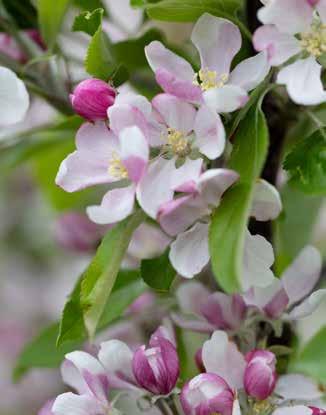
Red Falstaff®
Picking Month: Early October
Red sport of Falstaff. Fruity, well balanced flavour, crisp and very juicy The red flushed skin over green apples are great for home juicing One of the heaviest yielding and best garden varieties (Norfolk, 1983)
Picking Month: Early October
A red sport of Jonagold Dark block red apple, colouring in the shade Good flavour and crunchy texture Vigorous, heavy yielder and cropper Benefits from storage before eating (Netherlands, 1994)
Picking Month: Mid September
One of the easiest and most reliable varieties Delicious red fruits, with a good balance of sweet and sharp flavour An ideal garden variety that has compact growth Disease resistant and frost hardy (Worcestershire, 1985)
Picking Month: Early October
A popular, high quality triploid dessert apple Firm and sweet, aromatic in flavour, crisp fruit with yellow-red flush Described as ‘like a good dessert wine’. (North Yorkshire, 18th Century)
™
Picking Month: Early August
2
A lovely, unusual pink speckled ‘rosette’ pattern sinks deep into the flesh Sweet flavour with a hint of summer berries Makes a tasty, attractive juice. Compact in habit which makes an ideal tree for small gardens (Worcestershire, 2005)
Scotch Bridget
Picking Month: Early October
3
A popular Scottish cooking apple. Medium-sized, ribbed fruits have a cream, crisp flesh A favourite in the Hereford and Worcester area. Suitable for difficult growing situations. (Scotland, 1851)
Picking Month: Late August
1
An early ripening culinary variety. It’s large apples cook to a brisk, well flavoured frothy purée. Very attractive pink flowers. Makes an excellent apple sauce (Scotland, 1949)
Picking Month: Early September
3
A very special apple Wonderful complexity of fragrant, honeyed, liquorice berry flavours Soft, delicate and crisp The fruit holds well on the tree without falling. A children’s favourite and truly scrumptious. (Kent, 2000)
Somerset Redstreak
Picking Month: October
5
A traditional English variety. Produces a bittersweet juice, making one of the best quality ciders. Attractive shiny red apples, flushed greenish yellow and slightly ribbed (Somerset, 20th Century)
Picking Month: Early October
3
Heavy cropping, very popular dessert variety Fruit is maroon, sweet and juicy At best, perfumed with flavour like a cross between strawberry and melon A very good pollinator (Canada, 1926)
Picking Month: October
A rare, naturally small tree which produces a bittersweet cider. The fruit are yellow and green with spotty lenticel markings giving it it’s name. (Devon)
Picking Month: September
Distinctly regular somewhat flattened cooker. Bright green becoming very pale yellow Flesh white, very soft, rather coarsetextured and juicy Good for Apple Foam and Apple Cream (Stirling, 1820)
Picking Month: September
An exceptional recently introduced apple that is quite unlike any before Brilliantly glossy, orange skin with a beautiful pink flesh Crisp juicy and delicious. A quirky, tasty variety. (Kent, 2017)
Picking Month: Late September
Golden flushed fruit with crimson flecks and pale lenticels Robust astringency, sweet and low acid Good tree shape, vigorous with a good leader Regular crops (Long Ashton, 1990s)
Picking Month: September
Sweet, richly flavoured apples that are yellow in colour cover with an orange blush and distinctive lenticels Disease resistant and a heavy cropper (Arlington, North Devon)
Picking Month: September
A traditional, early-season, dessert apple historically sold at Totnes market. Yellow-green flesh with a pink flush and sweet taste Originating from Dartington, South Devon
Picking Month: Late August
2
This red fleshed apple is an extremely healthy variety Makes a dark pink purée needing little sugar, great for pies. The red skins dissolve when cooked. Pretty pink blossom and attractive leaves. Bred by a Polish war veteran (Twickenham, 1980)
St Edmund’s Russet
Picking Month: Mid September
One of the earliest varieties to ripen. Attractive golden-red russet and silvery sheen Sweet, juicy, densely textured pale cream flesh
A good variety for cider and juice. (Suffolk, 1875)
Picking Month: Late September
Red striped apples, orange flushed over gold Sharp intense flavour. Flesh is creamy white, firm, crisp and a little juicy. A reliable cropper and excellent garden apple. (Kent, 1918)
Picking Month: October
A well known cider Commonly planted in larger cider orchards Fruit is yellow, smooth and waxy Flesh is cream, sweet and soft, makes a lovely cider on its own (Devon 19th Century)
Picking Month: Late September
A dynamic, full red fleshed apple with an amazing display of pink spring flowers Delicious apples for eating straight from the tree, cooking or for a bright pink juice Pleasantly flavoured (Germany, 2011)
Tom Putt
Picking Month: Early September
Very handsome, large cooking apple Bright red-crimson streaks and shiny skin Firm, crisp and sharp Light flavour and melting sweet texture when cooked Disease resistant (Devon, 18th Century)
Picking Month: Mid October
A popular Devon cider variety White fleshed, sweet astringent producing a tasty juice, high in tannin. Full, bitter sweet cider ideal for mixing with other varieties Crops well (Devon, 19th Century) 5
Picking Month: October
A late keeping dessert apple Purplish-red fruit with darker broken stripes and some grey russet Flesh is cream, almost yellow Very firm, crisp, sweet and fairly juicy As rich and aromatic as Cox when it’s eaten before Christmas. (Kent, 1930)

Upton Pyne
Picking Month: October
Upright growing and moderate vigour. Oblong, yellow with pink striped fruits Has a slight pineapple-like flavour and cooks to a smooth purée (Devon, 20th Century)
Picking Month: Late September
A very large, old cooking variety Pale green fruit turning pale yellow with slight brown-pink flush Juicy and acidic flesh cooks to a sharp purée, strongly flavoured and mellows with keeping (Kent, 18th Century) 2
Winter Gem
Picking Month: Early October
One of the very best flavoured apples. Attractive pink and red striped fruit Rich and aromatic flavour with the perfect mix of sweetness and juiciness Strong grower, can be shy cropping in some years. (Kent, circa 1984)
Yarlington Mill
Picking Month: Mid October
An all-round cider of good aroma and flavour Greenish-yellow fruits have a smooth, slightly waxy skin White flesh, sometimes reddened is slightly crisp and sweet (Somerset, 1970s) 5
Bergeron
Picking Month: Early September
Famous for the French ‘Bergeron’ jam preserve. Large, attractive yellowish-orange fruit with red blush Aromatic and sweet, slightly juicy Delicious eaten fresh (France 1920s)
Bergeval®
Picking Month: Late June
A modern, French apricot. Produces a heavy crop of attractive, large orange-red fruits An excellent aromatic, sweet taste without bitter skin. Firm and juicy. High regular productivity. (France, 1950s)
Compacta®
Picking Month: Late July
A naturally dwarf Apricot perfect for growing in small spaces Heavy, large crops of freestone, tasty, orange fruit Makes a delicious jam A very popular variety Frost hardy
Golden Glow
Picking Month: Early August
Crops and performs well as a free standing tree or trained against walls Medium sized golden coloured fruits that have an intense, pleasant flavour (Worcestershire, 1985)
Helena du Roussillon® Aviera
Picking Month: Early August
Firm white fruits with pretty speckled light red colouring. Orange flesh that holds well with delicious taste The late spring blossom avoids frost damage An excellent late variety (France)
Picking Month: Mid September
Flattened fruits, pale yellow with bright red flush and stripes. Strong growing, upright habit The juice is low acid and sweet, slightly astringent Heavy cropping (Long Ashton, 1990s)
Crump
Picking Month: Mid October
A well coloured, high quality dessert apple Greenish-yellow fruit striped reddish-orange Almost yellow flesh, rich and sweet to taste, very similar to Cox (Worcester, 1910)
Picking Month: Mid September
Produces a reliable crop of delicious orange red fruit Firm, cream flesh is very sweet with strong strawberry flavour At its best when ripened on the tree and just before it falls (Worcester, 19th Century)
Picking Month: September
Pale orange-yellow fruit, highly decorative in table displays Sharp, fruity and firm flesh A charming lawn tree due to its drooping growing habit Best eaten straight from the tree (Shropshire, 1800s)

Picking Month: Early August
Golden yellow fruit with thick skin Vigorous and healthy with regular crops of good sized fruit Suitable for cold and wet climates. Good for freezing and bottling. Freestone. (USA)
Picking Month: Early July
Regular high productivity of medium-sized red fruits Flesh is sweet and freestone, juicy and aromatic with attractive red colouring Beautiful spring blossom (Canada, 1979)
Kioto®
Picking Month: Late July
Bright orange, round fruit with an attractive blush. Succulent and a charming taste An easy garden variety, crops heavily every year Slightly more compact than a standard apricot and frost resistant (France)

Viking
Picking Month: September
Hardy shrub suitable for a wide range of soils Small, black fruits Makes tasty jams, compotes and juice Very high in Vitamin C and anthocyanins. Attractive autumn colours and white flowers.
Pink Marry®
Picking Month: Mid June
Very attractive red blushed apricot. High productivity of medium sized fruit with good firmness and less cracking sensitivity Luscious, orange flesh giving a refreshing taste
Robada®
Picking Month: Mid July
Large, high quality variety with attractive red blush and orange flesh Pleasant flavour, aromatic and freestone A reliable robust variety for the UK climate. Amazing spring blossom. (USA)
Tomcot®
Picking Month: Late July
By far the most reliable of all Apricots Crops heavily with large, orange fruits blushed red An intense flavour Masses of stunning pinkish-white flowers Best for cooking into jams or eating fresh from the tree. (USA)

Picking Month: September
Beautiful, golden russet finish makes this ‘Nashi/Chinese’ pear also an attractive ornamental tree. Bright white flesh, firm and crisp with a very sweet flavour Excellent for desserts or a salad fruit (Asia)
Olympic
Picking Month: Mid October
An Asian Pear which produces huge, round, russet-covered pears which are exceptionally crunchy, succulent and sweet Can be enjoyed fresh or in salads. Keeps well. (Asia)

Arapaho
Picking Month: July
This new selection quickly establishes a full fruiting plant of firm, thornless and high quality blackberries Delicious eaten fresh, for jams and syrups
Navaho Summerlong®
Picking Month: Late July
An upright growing floricane blackberry of very high quality
Large, juicy and sweet thornless fruit Delicious if eaten fresh or cooked into jams and pies Very easy to grow
Oregon Thornless
Picking Month: Early August
A reliable thornless form, perfect for the smaller garden Well flavoured, dark black fruits Excellent autumn colours Great for growing over an arch or trellis
Ben Connan®
Picking Month: Early July
Large black, glossy berries on short trusses Superb rich flavour!
A heavy cropper, compact in habit and easy to grow Good frost, pest and disease resistance (Scotland, 1993)
Ben Sarek®
Picking Month: Mid July
Early season variety Large, acid flavour berries on short strigs
Small, compact and heavy cropper Suitable for a small space
Perfect for eating fresh or in jams and jellies (Scotland, 1980)
Black ‘n’ Red®
Picking Month: July
A super sweet, aromatic flavour with medium-sized fruit Green foliage in the spring which turns an attractive burgundy in late autumn Resistant to mildew and leaf spot
Blackbells
Picking Month: July
A major breakthrough in blackcurrant breeding! Blackbells has sweeter berries and larger fruit that can be picked in bunches of 10-15 per strig. Upright growing.
Lowberry® Little Black Sugar
Picking Month: July
A compact variety with excellent, resistance to downy mildew
Medium-large fruits are produced in small clusters with the typical cassis flavour superimposed with sugar
Titania
Picking Month: Early July
Mid-season variety Produces very large fruits of superb quality with high juice content and delicious flavours Vigorous, upright in habit and resistant to mildew and rust (Sweden, 1980)
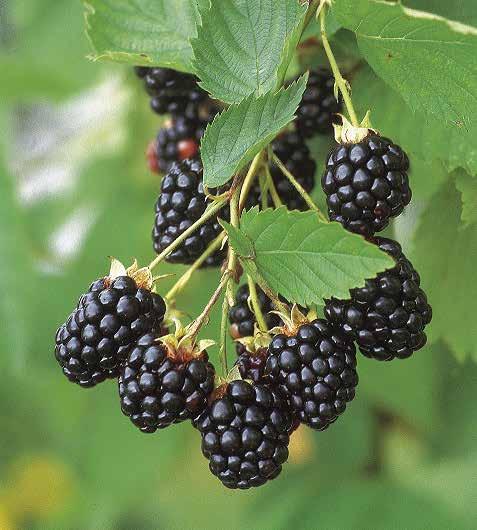

Picking Month: Early August
One of the main high yielding commercial varieties A vigorous upright grower The large, light blue fruits have excellent flavours and a long shelf life
Chandler
Picking Month: Early August
Enormous, firm juicy berries are produced on this stout blueberry bush. Attractive autumn colour. A superb choice for large blueberries and good for patio growing
Liberty®
Picking Month: September
Late fruiting blueberry producing sky-blue berries with an outstanding flavour An upright habit and consistent high yields Great for fresh eating and freezing
Picking Month: Mid July
A heavy cropping variety of medium sized, highly flavoured berries Sweet and juicy Very hardy and suitable for all parts of the UK.
Pink Lemonade
Picking Month: Late August
Lovely green fruits that gradually turn to a rich pink as they mature for picking Sweet in taste, delicious when eaten fresh or for cooking into puddings and pies
Amber Heart
Picking Month: Early July
The ‘Kent Bigarreau’. Pinkish-red skinned eating cherries. Pale yellow flesh that has a sweet and distinctive flavour. Upright and compact growing. Pollinated by any self-fertile variety. (Kent)
Black Oliver
Picking Month: Early August
A traditional English cherry Medium-large rounded black fruits Dark red flesh, soft and juicy Vigorous, upright spreading tree A healthy tree with good disease resistance (West Midlands)
Burcombe
Picking Month: Late July
The soft and juicy black cherries are suited to either eating or cooking The fruits are full of luscious flavours Suitable for growing in the South-West (Tamar Valley, Cornwall)
Celeste®
Picking Month: Early July
Excellent eating quality, one of the very best Dark red, large fruits; sweet, quite mild with a pleasant cherry aftertaste Perfect for patio growing due to its naturally dwarf compact habit (Canada, 1990)

Picking Month: Early July
A vigorous variety, highly productive bearing medium, slightly flat berries of excellent flavour. Easy for picking and suits any UK climate Lovely red and golden autumn colours
Sunshine Blue
Picking Month: Mid July
A compact growing, almost evergreen variety with large, succulent excellent flavoured fruits Beautiful, bright pink bellshaped flowers in the spring Heavy cropping
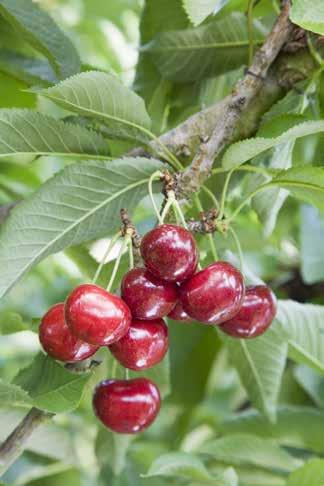
Picking Month: Early July
A new self-fertile cherry Ripening midseason in early July, this cherry is very large and produces high yields from an early age Dark red, firm, and juicy with a sweet, aromatic, true cherry taste
Very disease resistant and no pollinating partner is necessary (Czech Republic)
Picking Month: Mid August
Picking Month: Early July
Masses of old, traditional black heart-shaped fruits with dark red juice, hanging on long strigs Richly fruit, sweet and aromatic A healthy tree. (Kent, 1946)
Picking Month: Late July
Heart-shaped, glossy, dark carmine-red cherries Red flesh, excellent balance of acidic and sweet taste Good quality
Pollinated by any self-fertile variety (Czech Republic, 1963) 4
Picking Month: Late June
One of the best early to ripen varieties A sweet cherry and black in colour Best eaten fresh Stunning white flowers in the spring and good disease resistance (Norwich, 1970) 3
Picking Month: Late July
The most popular cooking cherry Very hardy and reliable Fruits can be picked at the very sour, dark red stage for stewing or left until almost black and bitter-sweet. Ideal for north facing walls. 4
Picking Month: Late August
Large black fruits, sweet and full of juice Will shed its fruit readily when green but there is always plenty left to ripen later. Upright, strong growing habit (Canada, 1984) 2
Picking Month: Early July
Very sweet, heart-shaped fruits Outstanding fruit early in the season Shapely, compact tree Handle carefully to avoid bruising (Surrey, 1931)
Picking Month: Mid July
An old fashioned firm, heart shaped dessert variety Excellent cherry with a shiny, marble red finish Golden flesh and sweetsharp, tangy taste (Germany)
An outstanding quality black cherry Firm, large and very late in the season Sweet with lovely juicy flesh Pollinated by any selffertile variety. (Kent, 1998) 3 Regina
Picking Month: Mid July
Black fruit, highly productive, sweet and aromatic flavours Very popular with commercial growers and gardeners A hardy variety, can cope in most UK climates. (Germany)
Picking Month: Late July
Roundel Heart is one of the oldest varieties of excellent quality Produces heavy crops of large, heart-shaped fruits that are shiny dark red. Soft, sweet flesh and very good flavour. (Kent)
Picking Month: Late July
A white fleshed cherry that has a regular crop Good firmness The sweetest flesh of any cherries and this one is no exception Strong vigour and good branching (Canada, 2002)
Summer Sun
Picking Month: Late July
Very hardy variety and crops in most areas Fruits are dark red, firm and crunchy and have an exquisite flavour Easy to manage (John Innes Institute, Norwich, 1970)
Picking Month: Late August
One of the later picking varieties but well worth the wait Very precocious, firm with a delicious flavour A good pollinator for other cherry varieties (Canada, 1990)
Month: Early August
A high quality, dark red skinned fruit with a ruby red coloured flesh, well-balanced, sweet-sharp flavour Heavy cropping (Canada)
Month: Late July
The first of many self-fertile varieties tried at Summerland R S A large, dark red, reliable, sweet and juicy cherry with good flavour Heavy cropper and an excellent pollinator for other varieties (Canada, 1968)
Picking Month: Late July
Heavy crops of decent sized fruit Dark red in colour, sweet to taste with great flavour and texture High quality fruit Easy to grow and has good storage (Canada, 1975)
Month: Late July
A traditional eating cherry Heavy crops of good quality, glossy black fruits. Fairly soft with a small stone. Named after the Battle of Waterloo
We offer a range of commercial cherry varieties which are specifically developed for growing under tunnels on dwarf Gisela 5 rootstock. Many of these have minimum order numbers. Varieties offered in order of picking are Nimba®, Bellise®, Early Red®, Fertile®, Samba®, Vanda®, Pacific Red®, Walter®, Tamara®, Papillon®, Starblush®, Kordia, Areko®, Henriette®, Regina, Kir Vulcano®, Sweetheart®, Kir Lamour®, Kir Rosso® and the Cerasina varieties. Please contact us for further details.
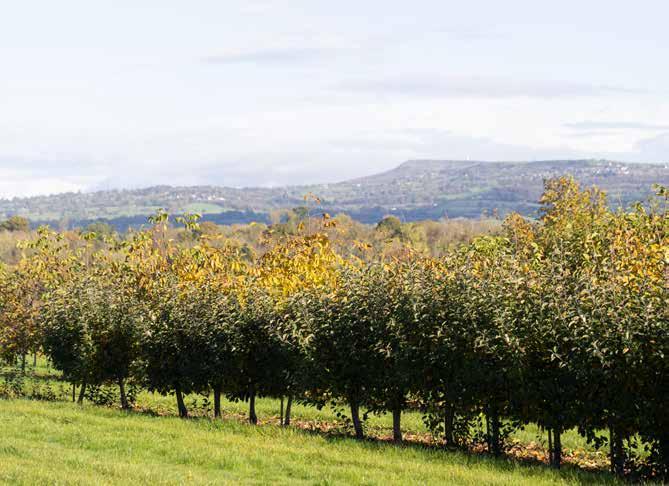
Picking Month: Early October
Mid-season hybrid variety, upright with moderate vigorous growth Shiny, dark mahogany-red nuts in the early autumn
Marhlac
Picking Month: Mid September
An early mid-season hybrid Vigorous with large mahogany-red nuts that store well As with all varieties harvest the nuts daily
Maridonne
Picking Month: Late October
Maridonne is a late season variety Produces shiny, dark mahogany large nuts in early autumn which are very good in quality The tree itself is very handsome with glossy serrated foliage that are golden in the autumn
Marigoule
Picking Month: Late September
This is an early variety with large dark brown nuts Pick in Late September The best variety to plant on its own, as partially self-fertile
Marsol
Picking Month: September
Marsol is an early mid-season variety Produces a good crop of large, high quality brown nuts that have good storage life Delicious either roasted and in sauces
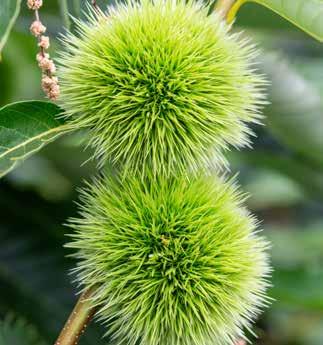
Marron de Lyon
Picking Month: September
A good mid-season fruiting clone bearing at a very early age Dark brown, high quality nuts arrive in September. Upright and compact growth habit
Picking Month: October
Chestnut Regal is an attractive tree, more compact than other Sweet Chestnuts, growing to 5m in 10 years Shiny green leaves and fragrant blossom in summer, followed by delicious brown nuts in October
Picking Month: Mid September
Round, sweet fruits can be eaten fresh or used for cooking Dark blue in colour with a small stone Very productive and beautiful spring flowers (Buckinghamshire, 1997)
Picking Month: Mid September
One of the heaviest cropping varieties Very small with a blueblack bloom and of excellent quality Sweet, juicy and very hardy (Kent, 1820)
Picking Month: Mid September
Large, dark blue fruits that have a delicious sweet flesh, refreshing and sugary Great for preserves or puddings Reliable cropper (Nottinghamshire, 1880)
Picking Month: Late September
An extraordinary large damson for both dessert and culinary use Reliable heavy crops of blue-black fruits. Yellow, firm flesh and relatively sweet. (Nottingham, 1907)
Picking Month: Mid September
The ‘Greengage of Damsons’. Very reliable cropper with intense flavours and dark blue in colour Firm sugary flesh Suitable for hedgerows (Shropshire, 17th Century)
Picking Month: Late August
Exceptionally large flowers and berries The flowers can be used for Elderflower juices and cordial, or the dark red/black berries for juicing, pies and dye The fruit is very high in anthocyanin content

Picking Month: Late September
(Syn: Shepherd’s White) A traditional English variety that produces large yellow bullace, round to oblong fruits Golden yellow, sharp and sweet flesh
Picking Month: Mid September
The classic German ‘Hauszwetsche’ sweet prune for traditional ‘plum cake’ and fresh eating. Dark purple fruits with a spicy flavoured flesh (Germany)


Picking Month: Mid August
A classic British fig Large brown, pear-shaped fruit with a sugary, rich and red flesh Reliable, compact habit and easy to grow Large glossy palmate leaves
Picking Month: August
A large, deciduous shrub that has ‘hand' shaped dark green leaves Produces large pear-shaped fruits with green-yellow skin Flesh is yellow with a red centre; delicious and sweet in flavour
Picking Month: August
Very well suited to the British climate Produces heavy crops of very large, green fruits Deep red flesh, juicy and sweet Very long lobed leaves Excellent for small spaces
Picking Month: August
An unusual variety that has unique, deeply divided leaves which appear in the shape of ice crystals Small, sweet, edible fruits Requires plenty of growing space
Picking Month: Mid August
Naturally dwarf mini Fig Perfect for smaller spaces and patio growing Produces small purple sweet fruits in the autumn Good compact habit and easy to grow
Picking Month: September
A very popular variety Slightly larger than the Cobnut with a long husk and excellent flavour. Attractive, thin shelled nuts. A very good pollinator for other varieties
Red Filbert
Picking Month: September
This worthy selection has striking long claret-red catkins and rich purple, heart shaped foliage Very edible, dark purple skinned fruits of excellent flavour
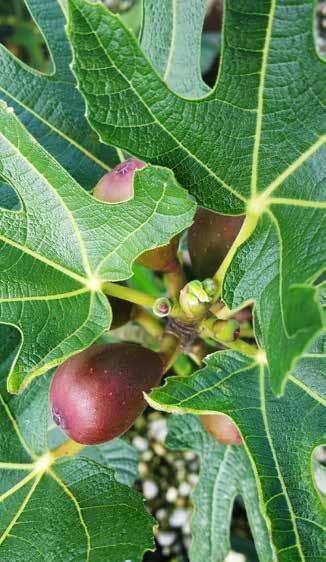

Picking Month: Late August
A classic English variety An excellent, heavy crop of small, yellowish-green fruits Juicy and fresh, honey flavoured Prefers a warm, sheltered position (Cambridgeshire)
Picking Month: Late September
Large, yellow fruits of oval shape and with a long neck Golden yellow flesh, juicy rich and sweet in flavour Great quality for fresh eating or preserving. (Suffolk, 18th Century)
Picking Month: Late August
The most reliable cropping, pale green flushed red gage Large, rounded fruits that have a transparent sweet flesh Reliable and high yields. (USA, 19th Century)
Picking Month: Early August
An unusual gage with attractive, melting and juicy, red cheek fruits A regular and heavy cropper Good for desserts and jams (Hertfordshire, 19th Century)
Picking Month: Late August
The sweetest and tastiest of gages Less prone to cracking Round, small to medium sized fruit Wonderful clusters of white flowers in the spring
Oullins Golden
Picking Month: Mid August
Golden yellow fruit, dual-purpose Heavy crops of gages that are great for cooking and bottling. Pleasant flavour, fairly juicy. (France, 1860)
Picking Month: Late August
(Syn: Reine Claude Violette) This is an unusual ‘purple’ gage of excellent dessert flavour Round, medium fruits, clingstone Very juicy and tasty Grows well against a warm wall 2
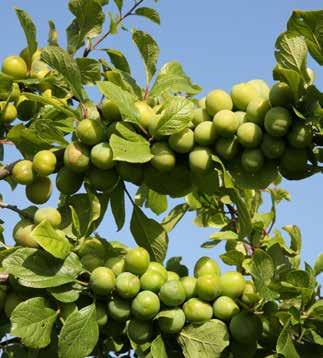
Picking Month: Early August
One of the very best varieties for dessert use. Yellow fruits with a bright golden yellow flesh, juicy and sweet Hardy, suitable for northern districts. (USA, 19th Century)
Picking Month: Mid August
Selected for its excellent old fashioned, sweet and delicious flavours Heavy crops of green flushed red fruit A melting flesh and pleasant scent, a joy to eat. (UK, 17th Century)
Stella’s Star®
Picking Month: Mid August
Very productive and reliable crops from an early age Turns slightly yellow when ripening Mildly flavoured fruits can be eaten fresh or cooked Great for pies 3
Picking Month: Mid August
As with Old Green Gage, selected for good cropping and excellent quality dessert fruit Succulent flesh reminiscent of melons (Cambridge, 19th Century)
Lubera® Super Success
Picking Month: August
A selection that is particularly productive Harvest the bright orange fruits from the end of August Pleasantly sweet tasting with only a slight bitterness.

Picking Month: Late July
A reliable bush variety Large, burgundy berries of excellent quality Sweet in taste Healthy and disease resistant Delicious eaten fresh
Hinnonmaki Red
Picking Month: Late July
Very hardy, good for both eating and cooking Ruby red berries, slightly tangy and sweet. The red sister to Hinnonmaki Yellow.
Hinnonmaki Yellow
Picking Month: Late July
Heavy cropper with greenish-yellow berries The yellow sister to Hinnonmaki Red A unique flavour, delicious and aromatic with a hint of apricot
Invicta®
Picking Month: Late July
The most popular gooseberry Large, pale green and smooth skinned berries Delicious, sweet flavours Makes a tasty jam! Vigorous growth and high yields. (Kent, 1967)
Hall's Giant
Picking Month: September
A traditional variety. Attractive nuts, glossy rust brown shell. Resistant to nut gall mite Excellent quality and tasty flavour Very easy to grow, great for beginners
Kent Cob
Picking Month: September
A traditional cob, planted extensively in Kent. Clusters of two to five flavoured nuts and pale yellow catkins
Nottingham
Picking Month: September
A reliable, upright, deciduous shrub or small tree very similar to Webbs Prize Cob Fruit are elongated like other cobs, with good eating quality
Tonda Gentile de le Romana
Picking Month: September
(Confectionery nut)Italian small round nut. Buttery and intensely flavoured, easily ‘blanched’ for a more pure eating experience. Best pollinator for Trilobata
Tonda Gentile Trilobata
Picking Month: September
(Confectionery nut) A well regarded Italian small round nut that is the mainstay of the hazel confectionery industry Buttery and intensely flavoured, easily ‘blanched’ for a more pure eating experience
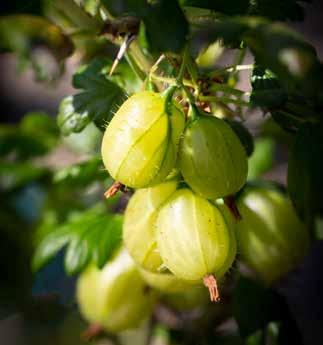
Rokula®
Picking Month: June
An early dark red dessert fruit with excellent flavour, mildew resistant Moderate vigour also grown in a standard form Delicious berries, juicy in flavour that can be eaten fresh or used for cooking (Germany)
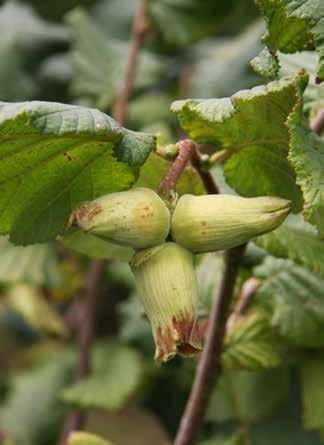
Webbs Prize Cob
Picking Month: September
The Lambert Filbert Very large, rich flavoured nut Tree is an abundant bearer. Kernel remains edible for several years.
dulcis
Picking Month: Autumn/Winter
(Japanese Raisin Tree) A small tree from China and Mongolia Clusters of small cream flowers in July followed by fruits The enlarged fruit stalks are edible, being sweet, succulent and with a raisin-like flavour This tree has climate change potential (Asia)
Picking Month: September
An improvement on the variety ‘Solo’. Fruits are round, rich in vitamins, deliciously sweet and makes a lovely addition to desserts Beautiful creamy white flowers appear in early summer
A very hardy variety
Super Issai
Picking Month: September
A self fertile and precocious cropping climber. Crops from mid September producing small, lime green, smooth fruits which are very sweet and juicy. These mini Kiwi are sweeter than normal kiwis and can be eaten like grapes
Thornfree
Picking Month: August
Raspberry x Blackberry Long red fruits with an excellent aromatic, juicy and sharp flavour Bushy, vigorous growth and high yields
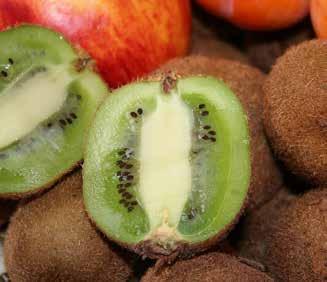
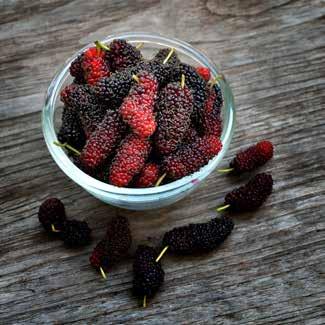
Nottingham
Picking Month: October
semi-weeping,
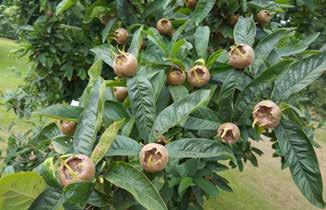
Countess
Picking Month: August
Superb round, dark reddish purple plummy fruit. Yellow flesh with a wonderful melting texture, juicy and sweet Excellent eating quality but can also be used in cooking Semi freestone (Ukraine, 1950)
Picking Month: Early September
A yellow-orange variety with green tinges Very small, ovate fruits Golden flesh, rich in flavour Frost resistant and freestone Good for bottling and preserves (France, 16th Century)
Picking Month: Late August
Yellow almost translucent fruits with golden flesh and a sweet plummy flavour Beautiful blossom in the spring Very hardy variety. (Ukraine, 1995)
Gypsy
Picking Month: Late August
Produces a heavy crop of large, bright red Mirabelle’s. Sweet, orange flesh The flavour is sugary and rich One of the best for fresh eating. (Ukraine, 1995)
Carman
Picking Month: August
An unusual fruiting mulberry, very unique Produces a heavy crop of large, creamy-white fruits; delicious sweet flavours Hardy and very productive from an early age Makes a tasty summer pudding (Canada)
Picking Month: August
From a 17th Century tree, during the time of King James I. Large, black and succulent fruits with an intensely rich flavour Harvest the ripest fruit each day
Giant Fruit
Picking Month: August
(Mulberry Pakistan) Fruit is 2-3 times the size of regular mulberries and just as juicy and delicious Sweet, tart flavour A hardy tree with a neat dome shaped head
Illinois Everbearing
Picking Month: August
(Morus alba x rubra) Tasty, small black fruits are produced from an early age A similar taste to blackcurrants Large, heart shaped foliage. Hardy and vigorous. (USA)
Mojo Berry®
Picking Month: July
(Syn: Charlotte Russe)A unique mulberry that fruits on young plants Dark black berries, sweet and juicy Perfect for baking Suitable for growing in containers

Picking Month: Early September
The largest fruit of Mirabelle’s recorded. Exceptionally sweet in taste, peach-like flavours and dark red flesh. Upright in habit. (Ukraine, 1995)

Picking Month: August
Lord Napier
Picking Month: Early August
One of the earliest, largest and most popular varieties for home growing Regular crops of yellow fruits and melting juicy flesh Freestone (Sawbridgeworth, 1860)
Mesembrine
Picking Month: August
The sweetest flat nectarine Smooth, yellowish red blushed fruit with juicy, melting, yellow flesh in late summer. Pretty, pink flowers in the spring
Picking Month: Mid August
A genetic dwarf nectarine of very excellent quality Sweet reddish-orange flesh and a freestone Perfect for patio growing or planting in a small garden space
Avalon Pride®
Picking Month: Late June
Large, reddish-orange fruits that are red fleshed, juicy and have mouth watering flavours. The most resistant variety to ‘leaf curl’.
Picking Month: August
A naturally dwarf peach was one of the first genetically dwarf selections. Pretty pink flowers in early spring are followed in late summer by large, juicy, yellow-fleshed, red- and yellowskinned fruit
Duke of York
Picking Month: July
One of the finest early white fleshed peaches. The flavour is intense and aromatic, also the flesh is very soft and juicy (Rivers of Sawbridgeworth, 1902)
Picking Month: Early August
The most revered of white fleshed peaches The finest flavour, intense and rich The flesh peels away from the stone easily, freestone (Sawbridgeworth, 1906)
Rochester
Picking Month: Mid August
The largest and most suitable of yellow flesh types for outdoor cultivation Soft orange flushed red fruits Clusters of dark pink flowers late in the spring. (USA, 1900s)

Picking Month: Early September
A clean, pale skinned variety with yellow flesh and rich aromatic flavour; slightly reminiscent of a sprightly pineapple Delicious eaten straight from the tree (Rivers of Sawbridgeworth)
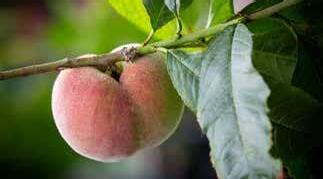

Picking Month: Early September
Attractive purple-red striped skin. Delicious, juicy fresh flavours which make this the perfect eating variety This peach really lives up to its name. (Kent)
Picking Month: Mid August
A popular, mid-season variety Flavoursome, rosy pink fruits that have firm flesh, freestone Best eaten fresh from the tree Very easy to grow. (USA, 1940s)
Picking Month: Early August
An unusual variety that crops small, flat shaped peaches that are very sweet and succulent Ideal for children especially with its nickname Sat-on!
Barnet
Picking Month: October
(Syn: Hedgehog Pear) A heavy cropping perry pear variety Crops from an early age Brown russeted, small fruits have a juicy flesh Fruits are easily shaken off the tree when ripe. A pleasant light perry.
Picking Month: Early September
An excellent garden variety Pale green to pale yellow fruit with smooth skin Small clean pears with sweet and succulent flesh Neat and compact growing habit. (Kent, 1938)
Picking Month: Late September
Rough skinned fruit is light green covered with bronze russet Tender and juicy with a rose water flavour Vigorous and good for poor soils Highly recommended for the garden (France, 1820)
Black Worcester
Picking Month: Late October
Large, heavy crop of dull green pears with brown russet and sometimes a purplish flush Crisp, coarse, fairly juicy, green flesh An excellent stewing pear, best cooked for 1-2 hours to soften (16th Century)
Picking Month: October
An old perry variety Small and pale greenish-yellow with bright red flush A small tree, perfect for the smaller garden Disease resistant Makes a delicious drink on its own (Gloucestershire)
Picking
Known as Nuvar Celebration, a large ‘pyriform’ fruit of excellent dessert quality Produces light green fruits on a yellow background. The tree is strong growing and healthy. (Kent, 1972)
Picking Month: Late September
Recognised as one of the best varieties for gardens Pale green, large fruits with patches of gold russet Sweet and juicy, melting and buttery flesh with a pleasant mild flavour. A compact growing tree. (Kent, 1977)
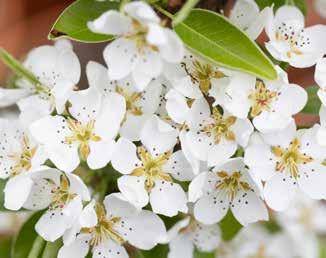
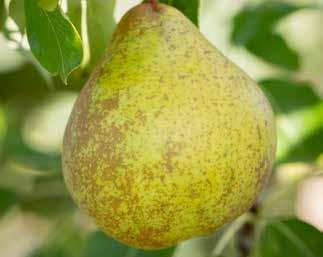
Picking Month: Late September
Medium size pears, mid-green turning yellow with light brown russet patches. Yellow, melting flesh has a delicious scented taste A high quality variety suitable for warm, sheltered sites (Angers, France, 1837)
Picking Month: October
Very reliable, heavy cropping variety Fruit yellow with heavy flush, sometimes streaked with light russet Makes a medium acid/tannin tasting perry (Gloucestershire)
Picking Month: October
Large, full green fruit, slight russet Suitable for slow poaching or cooking and turns pink in the process Also a superb exhibition fruit Store until February and beyond (France, 1665)
Picking Month: September
Well known amongst Scottish fruit enthusiasts. The green skinned fruits blush red as they ripen Sweet and mellow in flavour Wonderful displays of white blossom in the spring (Pre-1900s)
Picking Month: Late September
One of the most popular and reliable varieties. Yellowish-green pears with brown russet, occasionally a pink flush Sweet and juicy with a pleasant pear flavour (Hertfordshire, 1885)
Conference Moors Giant®
Picking Month: September
A super sport of Conference pear. Up to 40% bigger and slightly rounder. Yellowish-green fruit with brown russet areas. Succulent and tasty (Conference Moors® EU pending 4057222)
™
Picking Month: September
An incredible juicing variety, the firm fruits are perfect for cooking, canning and other culinary delights and store well Self fertile and will crop reliably in even the most exposed sites (Launceston, Cornwall)
Picking Month: Early October
Superb quality eating pear The green fruits have a red flush, and a pale yellow flesh with rich juicy flavouring Needs to have good pollination (France, 19th Century)
Gin
Picking Month: Mid October
A rare but excellent perry variety Medium sized fruits, green in colour with a slight orange flush Acid and tannin to taste and good keeping quality (Gloucestershire, 19th Century)
Gorham
Picking Month: Mid September
Pale green turning yellow, some are heavily russeted Creamy, fine and juicy flesh with a sweet musky flavour. Upright growing and a good pollinator for other varieties. (USA, 1910)
Picking Month: Mid September
One of the best early perry pear varieties Strong growing tree with heavy crops of small, rounded green fruits Low to medium tannin (Gloucestershire, 18th Century) 3
Humbug
Picking Month: October
(Syn: Swiss Trousers) An unusual pear which offers something very special for the garden Green, yellow and pink striped fruits Sweet and juicy texture with a thick skin. Known as the ‘Easter Pear'. (Ukraine)
Invincible delwinor
Picking Month: Mid September
Named for being tough and hardy, setting heavy crops each year. Green in colour with yellow flush and sweet, soft and juicy flesh Will often produce a second flowering (France, 19th Century) 2
Picking Month: October
Greenish-yellow fruits with a dark red flush Sweet and moderately juicy, rich buttery and perfumed white flesh. Keeps well into the New Year. (Belgium, 1830) 4
Louise Bonne of Jersey
Picking Month: Mid September
An attractive, reliable and good quality variety. Small-medium, pale green fruit with a white, succulent, melting flesh The tree itself is moderately vigorous (France, 1780) 2
Picking Month: Late August
A high quality, mid-season variety that produces bright lemon skinned fruits when ripe Flesh is soft, juicy and sweet in flavour; slightly perfumed. (USA, 1960)
Old Home
Picking Month: October
An American Pear variety which creates a light mellow perry Very useful for its natural resistance to fireblight and use as a stem builder for other varieties. (USA)
Picking Month: September
High quality and reliable, a good garden variety Green fruit with pinkish flush and mottled brown russet. Melting juicy texture. Pick just before they’re ready and leave to ripen in a bowl. (France, 1825)
Picking Month: Early October
Pea green coloured fruit with a little russet. Fine, melting and juicy texture, classic flavour A very good pollinator for other varieties (Belgium, 1750)
Picking Month: October
Attractive, olive green perry pear with an orange flush. Makes a high acid/low tannin perry of excellent quality Can be stewed or pickled (Gloucestershire, 1886)
Picking Month: Early October
A very rare, large tree with upright branches Fruit is elliptical and irregular Medium acid, low tannin for a pleasant, vintage quality perry (Gloucestershire, 1960s) 4
Picking Month: Mid September
An improved, self fertile form of the variety ‘Fertility' Reliable crops of medium sized fruits that are pale green flushed yellow with variable amounts of russet Flesh is very sweet and juicy and can also be used for cooking Good disease resistance 3
Picking Month: Late August
1
One of the hardiest and longest lived pears, making a majestic tree Pale yellow with brownish-red flush on some fruits Tender and juicy flesh with a musky flavour (1629)
Picking Month: September
1
A medium sized tree with a narrow crown in the early years Fruit is greenish-yellow with a russet cheek Pleasant, low tannin light perry (Worcestershire, 20th Century)
Picking Month: Early September
A wonderful garden variety producing heavy crops of large, green fruit White flesh is soft One of the juiciest pears of its season (Surrey, 1941) 3
Picking Month: Early October
Dwarf pear with upright, columnar growing habit making it ideal for small spaces and patio growing Green with a slight flush, crunchy with a delicate taste Stores well into winter (Slovakia) 3
Picking Month: Early September
Excellent quality, medium sized fruit Light green in colour with a pinkish flush and some heavy russeting Creamy white flesh has a sweet and rich flavour (Surrey, 1947) 4
Packham’s Triumph
Picking Month: Early October
3
A reliable pear grown on a large commercial scale in South Africa Small, bright green fruit with unusual bumpy appearance Fine, juicy and musky flavour (Australia, 19th Century)
Red Pear
Picking Month: October
An old, popular variety Heavy crops of low acid and low tanning perry pears of good quality. Keeps well after harvest. Grown on a wide commercial scale for over 400 years (Malvern, 16th Century)
Picking Month: Mid August
A sport of Williams' Bon Chrétien, with red skin, striking red foliage and white blossom in spring. Fine texture, melting juicy. Upright and narrow growth habit (Australia, 1940s)
Picking Month: Late September
Small tree with upright habit and multi spur systems Abundant crops of small yellow fruits with some russet Medium acid and low tannin (Gloucestershire, 1670) 4
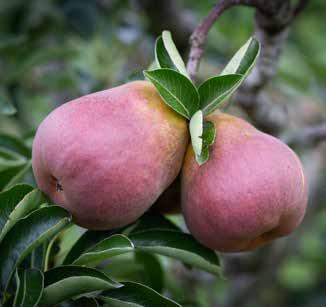
Pitmaston Dutchess
Picking Month: Mid September
One of the finest eating pears Very large, long, golden-yellow russeted fruit. Yellowish white flesh juicy and melting, slightly gritty around the core. (Worcestershire, 1841) 4
Santa Claus
Picking Month: December
Rich, highly perfumed with finely textured melting pale cream flesh; juicy and sweet Named for its late ripening in December Beautiful white spring blossom (Belgium/France, 1875) 4
Tettenhall Dick
Picking Month: September
A very small multi-purpose pear for fresh eating, bottling or stewing, can also be used for perry This self fertile pear fruits in abundance Historically important to the Black Country
Williams’ Bon Chrétien
Picking Month: Late August
The most popular, old English pear A great garden tree that has regular crops of oval-shaped, smooth skinned fruits Refreshing flesh, perfect for eating fresh, poaching and preserving (Berkshire, 1770)
Picking Month: October
Heavy crops of small greenish-yellow fruits that have a slight red flush and light russet Makes a medium to high acid low tannin perry (Hereford, 1790)
Winter Nelis
Picking Month: Early November
A fine, late pear variety that produces small fruits of pale green almost covered in russet The richest flavoured pears last well into the New Year. (Belgium, 1818)
Picking Month: October
An excellent variety noted for its strength Produces heavy crops of greenish-yellow fruits with some russet Makes a medium to high acid, low tannin fruity perry. Fruits should be shaken off before it's ripe (Gloucestershire)
Nikitas Gift
Picking Month: October
A delightful small-to-medium tree known for its ornamental beauty and delicious, sweet, orange fruit Glossy green foliage turns vibrant shades of red and orange in autumn Ideal for fresh eating, baking, or drying Best planted in a sheltered position
Picking Month: October
This hardy variety is prized for its cold tolerance, and deliciously sweet fruit, making it more suitable for planting in the UK. Glossy green leaves turn to stunning shades of gold and orange in autumn Best planted in a sheltered position
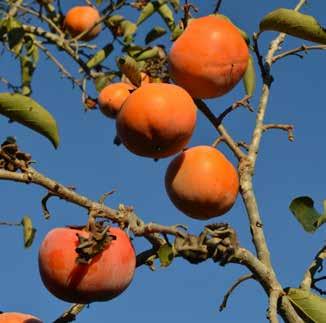
Avalon
Picking Month: Mid August
One of the finest quality dessert plums Golden flushed, freestone red fruits, moderately juicy and fairly sweet A strong growing tree (Bristol, 1980)
Belle de Louvain
Picking Month: Mid August
Purplish-red fruit, flesh is firm in texture and sweet A delicious variety for cooking into pastries or cakes, and also tasty eaten fresh from the tree (Belgium, 1845)
Blaisdon Red
Picking Month: Early August
Vibrant purple-red skinned fruit which turns the flesh bright red when cooked. Upright in habit, perfect for the smaller space. Lovely white blossoms in spring (Blaisdon, Gloucester)
Blue Tit
Picking Month: August
An old Laxtons variety of excellent quality Regular crops of dark blue plums with blue-black bloom. Yellow flesh with pleasant sweet-sharp flavour (Bedford, 1938)
Picking Month: August
Large, red, oval/oblong fruits crop in early to mid August Mainly used for cooking but can sometimes be eaten Particularly suited to growing in the West of the country as it was originally found in Devon. (Devon, UK)
Picking Month: Early August
Pale yellow fruits, mostly covered with reddish-orange flush Transparent flesh, moderately juicy and sweet A vigorous tree Shy cropping but the excellent quality fruit compensates well (Bristol, 1970)
Giant Prune
Picking Month: September
A heavy cropping plum producing very large, dark red ovalshaped fruits that have medium blue bloom and some golden brown dots and patches The flesh is yellow, juicy, slightly sweet Tough and reliable for exposed areas
Groves Late Victoria
Picking Month: September
Produces large reddish-purple plums that are juicy, sweet and have excellent flavour Delicious when eaten straight from the tree or can be cooked into puddings, cakes or jams The flesh falls clean from the stone, freestone
Haganta®
Picking Month: September
Strong scented, blue plums that are great for cooking into cakes, puddings and jams. Sweet, yellow flesh, freestone. Keeps well into October (Germany, 2005)
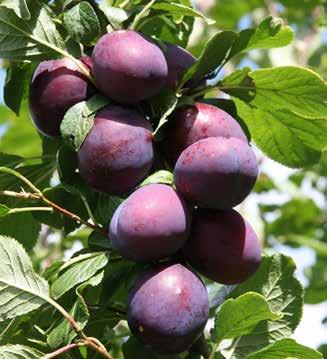
Picking Month: Early August
A culinary plum variety that crops heavily and reliably Medium sized dark purple fruits have a light blue bloom and fine dots on the skin Green flesh is of excellent flavours (Hertfordshire, 19th Century)
Picking Month: Late August
An excellent dessert plum Reliable crop of blue skinned fruits and yellow flesh with a fine, rich flavour Very hardy, grows well in difficult conditions. (Norway, 1950s)
Picking Month: August
Reine Claude Verte x California Blue Selected from a French breeding programme A blue plum of the most delicious flavours, very high sugar content (France)
Gordon Castle
Picking Month: Early September
A native hardy variety suitable for northern districts Greenishyellow plum and sweet with an excellent flavour Best when eaten straight from the tree (Scotland, 1864)
Picking Month: Late September
Healthy, well shaped and manageable tree Black, sweet plums Excellent eating quality and an extended shelf life when stored in the fridge. (Kent, 2000)
Picking Month: Mid July
Reliable, dual-purpose variety that has dark blue, very early fruits Golden flesh, juicy and freestone Best eaten straight from the tree (Sweden, 1970)
Jubilee
Picking Month: Mid August
Superb eating quality Large fruit with dark red skin and yellow flesh that has a good balance of sweetness and sharpness Freestone, strong growing tree (Sweden, 1985)
Kea
Picking Month: Mid August
A very special culinary plum, easy to grow and suitable for damp climates The dark red fruit makes incredible jam, preserves and liqueur (Fal Valley, Cornwall)
Malling Elizabeth®
Picking Month: Early July
Bred at NIAB EMR and released to celebrate the Queen’s Platinum Jubilee This plum is Victoria-like in appearance but appearing much earlier in July Red-purple skin colour, sweet, juicy and delicious plums. (Kent, 2022)
Manns No 1
Picking Month: August
Large, oval-shaped bright red fruits have darker red dots and are covered in medium, light blue bloom The flesh is dark yellow with some streaks of red, moderately juicy and sweet A Victoria selection ripening slightly earlier
Meritare
Picking Month: Late July
A dessert plum, similar quality to Victoria with larger fruit and earlier to crop Red in colour with yellow, succulent flesh Suitable for colder areas in the UK. (Sweden, 1985)
Picking Month: Late August
Known as the Purple Egg Plum. A very robust plum with good, regular crops Reddish-purple with thick, blue bloom Firm flesh, juicy and sweet (Worcester, 1877)
Reeves
Picking Month: Late August
Flavoursome plum, round attractive red skinned fruits that are freestone A high quality dessert variety Tastiest when eaten from the tree (Canada, 1940)
Picking Month: Late July
A popular dessert variety, heavy cropping and early season
Attractive, small bluish-purple fruits that have a lavender bloom. Rather firm, golden flesh (Hertfordshire, 1820)
Sanctus Hubertus
Picking Month: Late July
Oval-shaped, dark red with thick, blue bloom and small brown russet One of the best croppers of early varieties Rich flavours, ensure the fruit is fully ripe (Belgium, 1966)
Katinka
Picking Month: Mid July
Very early dark purple-blue fruits with good firmness and freestone A productive variety with huge crops of delicious plums A vigorous tree, quite upright (Germany)
Laxtons Delicious
Picking Month: September
A high quality, reliable late plum Produces heavy crops of beautiful pink-red fruits that have lavender blue blooms and russet dots Flesh is golden yellow, very juicy and has a rich sugary flavour (Bedford, 1902)
Picking Month: Late August
An old, traditional Cornish variety. Yellow skinned plums with an orange blush Traditionally used for jam making but is often sweet enough for fresh eating (Cornwall) 3
Marjorie’s Seedling
Picking Month: Early September
One of the later picking plums for early September Large and good quality purple fruit with thick blue bloom. Yellow flesh, suitable for cooking and fresh eating (Berkshire, 1912) 5
Opal
Picking Month: Late July
One of the most reliable garden plums A medium, reddish-purple fruit with superb flavour. Known as the early Victoria. Freestone. (Sweden, 1925)
Queen’s Crown
Picking Month: Late August
(Syn: Denbigh or Cox's Emperor) Quite possibly the finest variety the plum family has to offer. Pink-red oval fruits. Delicious flavours, heavy cropping Clingstone
Picking Month: Early September
A perfect late season plum for any garden Reddish-purple fruits best eaten fresh from the tree when fully ripe Wonderful, white blossom in the spring. (USA, 1937)
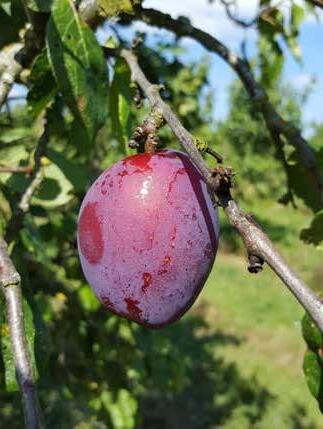
Swan
Picking Month: Late August
Produces round red-purplish fruits that have a heavy purple bloom Flesh is juicy, sweet and has the most pleasant flavour A good dessert plum but better for cooking into cakes, crumbles and jams A favourite of the Evesham plum growing area
Picking Month: Mid August
A good dessert plum The fruit are ovate to oblong 35-40mm and dark blue in colour with greenish-yellow firm and juice flesh Can be kept in the fridge for up to 2 weeks Freestone and good resistance to plum pox virus
Toptaste® Kulinaria
Picking Month: Early September
One of several ‘Top’ bred varieties, highly regarded for quality and cropping Medium sized, firm, juicy and very aromatic sweet yellow flesh Good disease resistance (Germany)

Picking Month: July
Apricot x Cherry Dark reddish-purple, rounded fruits with a wonderful cherry aroma Smaller than an apricot but bigger than a cherry Good resistance to frost and highly productive
Miracot Aprimira®
Picking Month: Early August
Mirabelle x Apricot A wonderfully mandarin flavoured sweet and juicy, egg shaped fruit. Freestone and firm. Yellow with a pretty red blush Superb eating quality (Germany)
Picking Month: August
Plum x Apricot (Pluot) Red-purple round fruits with red flesh Spicy, juicy and delicious tasting Will cross pollinate with Plums and Gages
Picking Month: Mid September
The latest ripening fruit in the season Can be picked over a long period The fruit are oval to oblong and usually over 60g each Dark blue skin with greenish-yellow, firm and juicy aromatic fruit Freestone and good resistance to plum pox virus
Picking Month: Early September
The steel blue fruits can weigh up to 100g! Green, aromatic flesh A late cropper but can be harvested over a long period of time and stores well in the fridge (Germany, 1987)
Picking Month: Late August
The most popular plum variety Bright red fruits have dark yellow, freestone flesh, moderately juicy and fair flavour Perfect for eating and cooking into desserts and jams (Sussex, 1840)
Picking Month: August
Produces very attractive dark blue fruits that are similar in shape to Plum Victoria The flesh is yellow, sweetly flavoured; delicious baked into desserts A compact grower, very productive and excellent quality (Sweden, 1990)
Picking Month: Mid August
Large yellow dessert fruit, juicy and good for eating and cooking Crops well and regular The tree itself has a drooping habit, hence the name (West Midlands, pre 1920s)
Picking Month: Mid August
A reliable cropper for dessert as well as the ideal bottling plum. Large, yellow fruits with juicy flesh; sharp and delicious An easy grower, good for beginners (Worcestershire, 19th Century)

Aromatnaya
Picking Month: September
(Syn: Krymsk) A smooth rounded fruit, not knobbly like most others. One of the few that have claims of fresh eating qualities Tropical flavours Perfect for making into jellies Heavy cropping (Russia)
Bereczki
Picking Month: September
An old traditional variety Pear shaped fruit that are big, juicy and nicely acidic The yellow flesh turns reddish when cooked Makes a tasty jam and quince cheese (Hungary, 19th Century)
Isfahan
Picking Month: October
Isfahan produces an excellent crop of large, high quality fruits Can be eaten fresh when properly ripe or used in cooking, to make jams, jellies, membrillo or to flavour gins and vodkas Ornamental blossom adds to its appeal
Serbian Gold
Picking Month: Early October
Highly productive variety for culinary use The apple shaped fruits have an aromatic flavour. Good resistance to leaf blight. Unique, silver coloured foliage (Serbia, 1900s)
Glen Ample®
Picking Month: July
High yielding, spine free variety with large, quality fruit Bright red, tasty berries that can weigh up to 30 grams Fruit picking over a long period (Scotland, 1978)
Golden Everest
Picking Month: August
The original mid-season yellow raspberry The deliciously sweet golden berries are packed full of vitamins and antioxidants Perfect for cooking and eating fresh
Lowberry® Goodasgold
Picking Month: August
Excellent quality yellow raspberry Perfect for growing in small spaces or in a pot Has a combined sweet and sour flavour

Meech’s Prolific
Picking Month: October
Popular, reliable cropper with pear-shaped fruits that are yellow when fully ripe The fruits also have a distinctive scent Interesting twisted branches and dark green curled leaves. (USA, 1880)
Vranja
Picking Month: October
Large pale greenish-yellow fruit. Bitter to taste so mostly used for cooking Strong fragrance to the fruit Beautiful clusters of light pink flowers in the spring (Serbia, 1800) 2
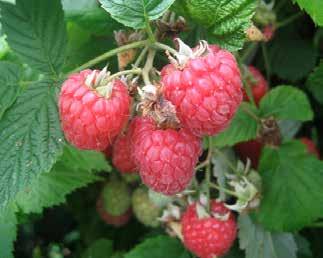
® Little Sweet Sister
Picking Month: August
A compact dwarf autumn fruiting raspberry Medium sized dark red with a sweet mild flavour Excellent for balconies and patio growing like all the Lowberry® series
Autumn First
Picking Month: September
An improved alternative to Autumn Bliss and the earliest of the classic autumn raspberries Large bright red fruits can be harvested from late September The berries have a fruityaromatic taste, backed by a fine acidity

Picking Month: July
A high yielding summer raspberry, ripening in July The large fruits are highly aromatic with extraordinary fruitiness due to an optimal sweet-acid ratio
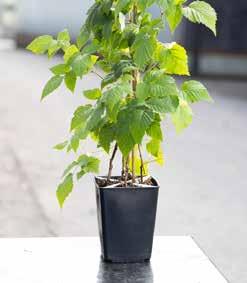
Junifer
Picking Month: July

Introducing our new 3L (pack of 4) potted raspberries – with a convenient four-way divider to keep roots separated for healthier, easier planting These upgraded plants replace our previous rootwrapped 5-pack, offering improved establishment and reduced transplant stress The following varieties will be available in this new form: Glen Ample®, Golden Everest, Autumn First and Summer Chef
Early season variety Easy to pick and one of the highest yielding redcurrants Very reliable with good disease resistance The red fruits are preceded by a show of attractive flowers.
Picking Month: July
Now the most popular variety for its high yields of superb quality fruit Long strigs of luscious redcurrants with vibrant, delicious flavours Makes a tasty summer pudding
Picking Month: April
Strong, vigorous variety producing vivid red stems with a wellbalanced acidity Voted the best flavoured rhubarb in the RHS Wisley trials Good for growing in borders or patio containers
Victoria
Picking Month: Mid March
A long established, popular rhubarb variety producing an abundant yield of large thick red stalks The best cooking variety, recommended for its sweet, juicy and mild flavours

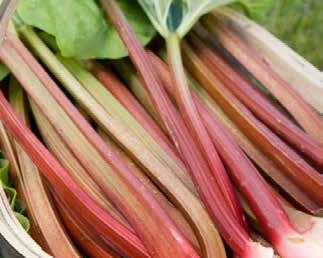
Buckingham
Picking Month: Mid July
Raspberry x Blackberry The thornfree Tayberry that produces large and succulent fruits with delicious sweet, aromatic taste Easy to grow and quick to establish
Bacchus
Picking Month: September
This is recommended as the best, outdoor white wine variety for the UK. The branches are filled with flavoursome fruits that juice into a lovely wine
Dornfelder
Picking Month: Mid September
A good hardy red, outdoor grape combining heavy crops of very edible fruits with stunning autumn leaf colour Rich to taste, best flavours for desserts and wine
Flame
Picking Month: September
A seedless, outdoor dessert variety that produces small to medium red-amber grapes which have a lovely, crunchy texture and are full of juice Perfect for baking into desserts or for juicing
Muscat Bleu
Picking Month: September
This is the modern mildew resistant, outdoor blue-black eating grape The red fleshed fruits have a Muscat flavour, with a hint of nutmeg Crops well
Picking Month: September
Blue/Black, outdoor variety Large grapes mature to a true black in good summers with a sweet refreshing flavour The red leaves add value as a climbing shrub
Broadview
Picking Month: September
The most popular walnut Precocious from an early age Small compact tree and fruits earlier than others Can be harvested green and pickled, or left until fully ripe to be dried (Canada)
Buccaneer
Picking Month: September
A healthy, robust tree that’s very heavy cropping. A round nut carried in abundance, particularly suited for pickling The tree will start to carry nuts 3-4 years after planting
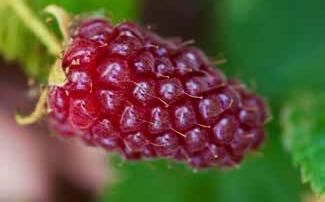
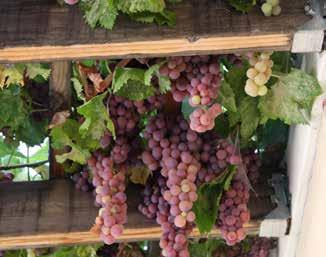
Lakemont
Picking Month: September
Big bunches of seedless, white, outdoor grapes with Muscat taste Sweet, almost honey flavours Good resistance to downy mildew
Phoenix
Picking Month: September
Large, outdoor fruit produces a fine Muscat aroma Heavy yielding, white grapes turn yellow when they need picking Perfect for dessert and wine-making
Strawberry
Picking Month: September
A very productive, outdoor variety. Also known as ‘Fragola’, this red grape has intense and rich flavours with a strong hint of strawberry Fiery autumn foliage
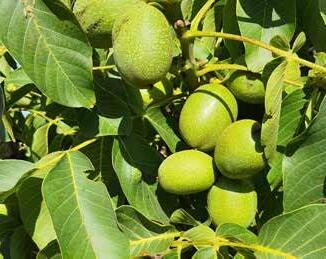
Chandler
Picking Month: September
A high quality large rounded nut, thin shelled Experimental in the UK. Accounts for much of California and Turkish commercial production
Fernette
Picking Month: September
Large, excellent quality globular nut, thin shelled for kernel extraction Best when eaten fresh when fully ripe A good pollinator for other varieties. Suited to the UK climate.
Fernor
Picking Month: September
Thin shelled nut, easy for kernel extraction Late leafing, precocious flowering and late ripening Best eaten ripe and fresh A good pollinator
Franquette
Picking Month: September
Superb late season quality, large oval shaped with a thin shell
Strong growing but late into leaf so avoiding frosts Reliable (France)
Lara
Picking Month: September
Heavy cropping large nut, rough-textured Excellent quality and a magnificent feature for the larger garden A unique creamy flavour. Franquette would be the best pollinator.
Blanka
Picking Month: September
A heavy cropping, late season cultivar Transparent, ivory coloured fruits The currants can be frozen, cooked into pies and jams Can be planted in bushes, or trained against a wall
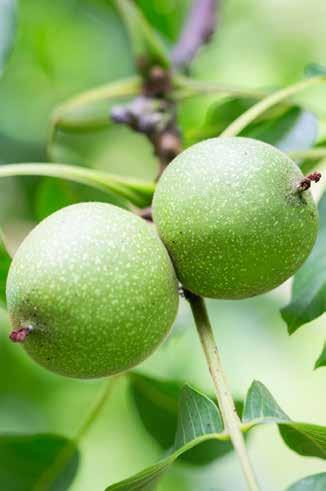

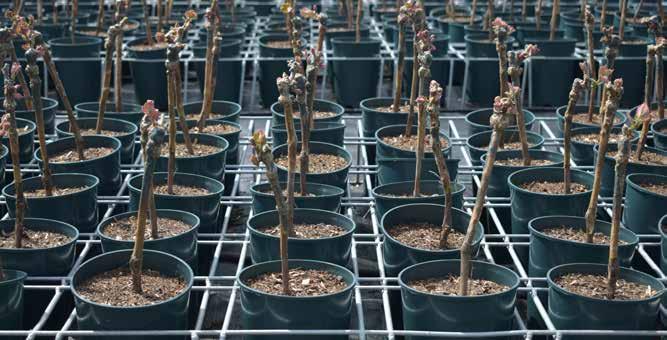


Abies concolor ‘Violacea’
Tree Shape: Conical
(The White/Colorado Fir) One of the bluest firs with very silveryblue needles and large, greyish-blue cones with brown tips A naturally smallish, slow growing, hardy, conical tree, forming layers of irregular branches
Acer campestre
Tree Shape: Standard
(Field Maple) A round-headed, very hardy tree with corky light brown stems Five lobed dark green leaves sometimes pinkish-red at first turn a yellowish-golden russet, or even dark purple in autumn
Acer campestre ‘Elegant’
Tree Shape: Upright
A compact vigorous clone of field maple. The small, bright green leaves in spring turn a range of colours in autumn, orange, yellow and brown The name comes from the ‘Elegant' ascending structure of branches (Netherlands, 1990)
Acer campestre ‘Street Pillar’
Tree Shape: Upright
A narrow, upright ascending Acer that is suitable for planting in streets Resistant to salt, drought and extreme conditions
Acer cappadocicum ‘Aureum’
Tree Shape: Standard
(Golden Maple) A medium sized tree with a tidy, dome shaped canopy of narrow branches and stunning autumn tints. Young emerging leaves are red, turning to golden yellow for many weeks until they fall (1914)
Acer conspicuum ‘Esk Flamingo’
Tree Shape: Standard
(Snakebark Maple) Attractive small tree with lobed leaves variegated in pink, green and white. Young stems are a vivid red, and the eye-catching bark is red with white markings along its length (Napier, New Zealand)
Acer x freemanii ‘Autumn Blaze’®
Tree Shape: Standard
A vigorous hybrid with deeply cut leaves and a dense oval head Yellow-green summer foliage turns red, orange and yellow in autumn In winter, the bare branches boast silvery-grey bark adding all year round interest. (USA)
Acer ginnala ‘Merlot Magic’® (2047447)
Tree Shape: Upright
(Tartarian maple) Excellent upright symmetrical habit, perfect for smaller spaces and street trees. Attractive purple/red emerging leaves remain a deep purple-bronze-green in summer Small, scented flowers in May Orange-red seed keys in autumn (UK, 2023)
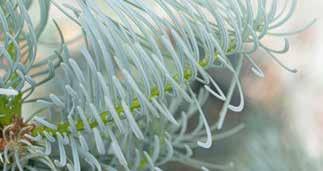
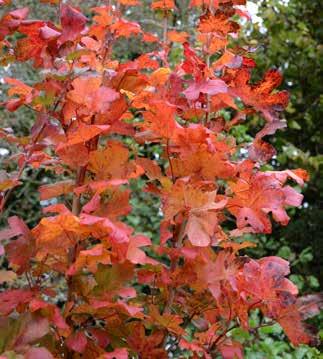
Acer cappadocicum ‘Rubrum’
Tree Shape: Standard
Fiery blood-red young leaves turn green in the summer and later assume stunning golden yellow autumn tints. Its attractive rounded canopy makes this variety perfect for smaller gardens or small spaces (1838)
Acer davidii ‘Viper’® (mindavi)
Tree Shape: Standard
(Snakebark Maple) A deciduous, upright form with white and green striated bark Dark green foliage turns orange in autumn Clusters of flowers in spring, followed by winged fruits that ripen to red-brown
Acer x freemanii ‘Morgan’
Tree Shape: Standard
Also known as Morgan Freeman Maple A fast growing tree with an open pyramid shape An outstanding new hybrid of the red and silver maple combining the best of both with excellent, vivid autumn colour
Acer griseum
Tree Shape: Standard
(Paper Bark Maple) Curly brown, flaking old bark shows cinnamon-coloured new bark beneath. Yellowish-green leaves turn red and scarlet in autumn Small pale greenish-yellow flowers in late spring (China, 1901) 4 5
Acer negundo ‘Flamingo’
Tree Shape: Standard
A fast growing Acer with attractive grey-white stems in winter. Young leaves emerge with a broad, soft pink salmon margin later changing to white Prune hard in spring to enhance the exotic foliage (Netherlands, 1970s)
Acer negundo ‘Winter Lightning’
Tree Shape: Standard
(Boxelder Maple) A medium sized, bushy-headed tree with green summer leaves turning to gold in the autumn Bright gold and yellow stems for winter interest Small, golden, tassel-like flowers in spring
Acer palmatum ‘Bloodgood’
Tree Shape: Bushy
(Japanese Maple) Regarded as one of the best purple-leaved Japanese Maples Bloodgood is a large bushy shrub or small tree with deep red-purple leaves, turning crimson or bloodred in autumn
Acer palmatum ‘Crimson Queen’
Tree Shape: Bushy
(Japanese Maple) Beautiful palmatum with finely cut reddish purple leaves. Under sunny conditions, the feathery leaves turn into a fiery red colour Perfect for planting in small spaces or even a large container (1965)
Acer palmatum ‘Enkan’
Tree Shape: Bushy
(Japanese Maple) A small, upright, strap-leaved cultivar Winered, deeply lobed foliage in spring turns bright shades of red in autumn Perfect for small gardens or planting in a large container (Netherlands, 1991)
Acer palmatum ‘Karasu gawa’
Tree Shape: Upright
(Japanese Maple) A lovely variegated form with varying amounts of cream, white and pink variegations, often with an attractive curling of the leaves as well
Acer negundo ‘Kelly’s Gold’
Tree Shape: Standard
A medium, bushy-headed tree, with bright yellow new leaves, golden-green as they mature, then yellow again in autumn Drooping racemes of golden tassel-like flowers in June, followed by winged fruits (New Zealand, 1989)
Acer palmatum ‘Ariadne’
Tree Shape: Bushy
(Japanese Maple) Semi-dwarf deciduous tree with deeply lobed leaves which are marbled with cream & pink Springtime colour is predominantly orange with bright green veins, turning purple-red with red veins in the summer and orange with red veins in the autumn
Acer palmatum ‘Brown Sugar’
Tree Shape: Bushy
(Japanese Maple) Low-growing Acer with dramatic, colourchanging foliage: from dark green to a caramel brown in summer, then going on to turn a vibrant red in autumn
Acer palmatum ‘Dissectum’
Tree Shape: Bushy
(Japanese Maple) A low growing, small tree with fine, deeply cut lobed leaves, emerging green in the spring before turning gorgeous shades of yellow, orange and red in the autumn (1784)
Acer palmatum ‘Garnet’
Tree Shape: Bushy
(Japanese Maple) Dissectum Garnet A strong growing maple developing finely dissected, purple leaves that resemble the colour of a garnet Holds its colour well, before turning shades of rich red in autumn (Netherlands, 1950)
Acer palmatum ‘Katsura’
Tree Shape: Bushy
(Japanese Maple) A delightful form with striking, spring growth Five lobed leaves unfold a pale yellow with margins of brighter orange, turn yellowish-green in summer, then bright yellow and orange in autumn
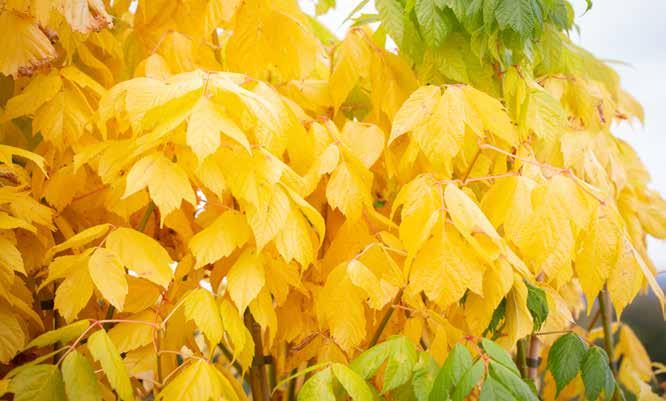
Acer palmatum ‘Kinshi’
Tree Shape: Bushy
(Japanese Maple) A slow growing, small, strap-leaved tree with finely narrowed, filigree leaves, starting dark green, turning bronze in autumn A gentle weeping growing habit, forms a tidy, compact shape (Japan, 1984)
Acer palmatum ‘Okagami’
Tree Shape: Bushy
(Japanese Maple) A small, upright, deciduous Japanese Maple tree It has deeply divided palmately lobed leaves that are purple/ red in spring turning to scarlet red in the autumn
Acer palmatum ‘Oridono-nishiki’
Tree Shape: Upright
(Japanese Maple) Regarded as one of the best varieties for leaf variegation Foliage is predominantly green with white variegated margins, new growth is pink
Acer palmatum ‘Pixie’
Tree Shape: Bushy
(Japanese Maple) Leaves emerge bright pink in spring, darkening to deep reddish-bronze in summer, lasting well into the autumn before they turn fiery, bright scarlet Perfect for small gardens or planting in a large container
Acer palmatum ‘Sango kaku’
Tree Shape: Bushy
(Japanese Maple) Small palmate, pale green leaves in spring with a strong, red tinge Foliage becomes light green in summer followed by yellow-gold in autumn Bright coral-red stems emerge in winter (1882)
Acer palmatum ‘Summer Gold’
Tree Shape: Bushy
(Japanese Maple) The spectacular palmate leaves emerge salmon-pink in spring then turn to golden lime green in summer followed in autumn with an array of colours - coral pink, salmon, scarlet and red before falling

Acer palmatum ‘Linearilobum’
Tree Shape: Bushy
(Japanese Maple) A unique variety with long, narrow divided leaves The light green, bamboo-like foliage turns stunning, bright yellow colours in the autumn Perfect for small gardens or planting in a large container (1867)
Acer palmatum ‘Orange Dream’
Tree Shape: Bushy
(Japanese Maple) Seven lobed leaves emerge orange, becoming yellowish-green in summer, often with red tints edging the leaves Autumn colours are bright yellow-gold turning crimson (Italy, 1990)
Acer palmatum ‘Osakazuki’
Tree Shape: Bushy
(Japanese Maple) A classic green leaved variety, which produces stunning, long lasting, fiery scarlet foliage in autumn It has a slow growing, open habit which can look dramatic against a tall hedge or building (1882)
Acer palmatum ‘Red Emperor’
Tree Shape: Bushy
(Japanese Maple) An improved version of Acer Bloodgood, retaining good leaf colour through the summer The deeply lobed foliage emerges reddish-purple in spring, turning dark crimson in the autumn
Acer palmatum ‘Seiryu’
Tree Shape: Bushy
(Japanese Maple) An unusual form of upright, bushy habit Bright green leaves tipped slightly red in spring A spectacular display of orange and yellow splashed crimson autumn colours (1882)
Acer palmatum ‘Suminagashi’
Tree Shape: Bushy
(Japanese Maple) One of the best of the red Matsumurae group with a strong growth habit Seven-lobed, rich, dark purple, leaves darken to deep maroon, almost black in summer, turning crimson red in autumn (1930)
Acer palmatum ‘Tamukeyama’
Tree Shape: Bushy
(Japanese Maple) (Syn: ‘Dissectum Tamuke yama') Crimson red dissected leaves unfold to dark purple, turning scarlet in autumn One of the best and most robust purple dissected forms (1710)
Acer palmatum ‘Trompenburg’
Tree Shape: Bushy
(Japanese Maple) Deep purple-red narrow lobed leaves in spring, turning green in the summer and crimson red in autumn A graceful form and a favourite for small gardens or planting in a large container (Netherlands)
Acer palmatum ‘Villa Taranto’
Tree Shape: Bushy
(Japanese Maple) A dome-shaped bush and foliage with five slender leaflets Leaves emerge orange crimson, then green with reddish overtone, turning yellowish-gold in autumn Perfect for small gardens (1967)
Acer platanoides
Tree Shape: Standard
4
(Norway Maple) A robust, large, round-headed, fast growing tree The five lobed leaves are pale, then bright green and mellow yellow in autumn Clusters of lime green flowers in spring
Tolerant of pollution and very hardy
Acer platanoides ‘Crimson King’
Tree Shape: Standard
4
A very popular, handsome, round-headed, fast growing Acer Lime green flowers tinged red appear in April followed by large intense purple foliage which turns bright orange-brown during the autumn (Belgium, 1937)
Acer platanoides ‘Crimson Sentry’
Tree Shape: Standard
An upright but less vigorous form of Crimson King. Very compact in growth ideal for smaller gardens The purple foliage emerges a fresh red in spring, darkening to red-purple in summer, then bright red again in autumn
Acer platanoides ‘Drummondii’
Tree Shape: Standard
A popular, medium, globe-headed tree with green variegated leaves and a white marginal band Foliage turns yellowish-orange in autumn. Produces attractive yellow flowers in spring before the leaves emerge (1903)
Acer platanoides ‘Princeton Gold’®
Tree Shape: Standard
(PRIGO) A beautiful golden leafed Norway Maple retaining its colour throughout the season. Resistant to scorch in the hottest of summers A fast growing and worthy tree for any situation
Acer pseudoplatanus ‘Prinz Handjery’
Tree Shape: Standard
5
A small variety, similar to ‘Brilliantissimum’ but more vigorous and open in habit Foliage emerges shrimp pink, turning yellowishgreen tinted purple beneath in summer Long yellow flowers in late spring and red fruits in autumn
Acer x pseudosieboldianum ‘Arctic Jade’
Tree Shape: Weeping
A frost hardy hybrid Japanese Maple Tolerates colder temperatures than regular Japanese Maples Elegantly shaped tree with deeply lobed leaves that open red then turn green through summer. Lovely autumn colours. (USA)
Acer x pseudosieboldianum ‘North Wind’
Tree Shape: Bushy
A frost hardy hybrid Japanese Maple Tolerates colder temperatures than regular Japanese Maples Deeply lobed leaves open red and turn green through the summer and has lovely autumn colour. (Iseli Nursery, USA)
Acer rubrum ‘Autumn Flame’
Tree Shape: Standard
A more tightly branched and compact headed tree than most rubrums The green leaves with a blue green underside turn orange and scarlet in autumn Delicate greenish yellow flowers are produced in spring

Acer platanoides ‘Royal Red’
Tree Shape: Standard
A good alternative to Crimson King but with a slightly more upright habit An upright, medium-sized fast growing tree Lime green flowers tinged red appear in April followed by large intense purple foliage which turn bright orange-brown during the autumn
Acer pseudoplatanus ‘Brilliantissimum’
Tree Shape: Standard
5
A small mop-headed, slow growing tree Spring foliage opens salmon pink, turning greenish-yellow in summer Greenishyellow flowers in spring and winged red fruits in autumn Suitable for small gardens
Acer pseudoplatanus var ‘Esk Sunset’
Tree Shape: Standard
(Sycamore Maple) A compact small tree with exotic foliage Bronzegreen emerging leaves opening to show pink and green splashes with stripes and starting pink undersides (Napier, New Zealand)
Acer x pseudosieboldianum ‘Ice Dragon’
Tree Shape: Weeping
A delicate looking, cold hardy tree with a gentle weeping habit The finely divided, delicate appearing leaves unfurl blushed orangered, quickly maturing to green, then turning a kaleidoscope of orange yellow and red in autumn. (Iseli Nursery, USA)
Acer rubrum
Tree Shape: Standard
5
(Red Canadian Maple) A fast growing, ultimately large, roundheaded tree The dark green leaves turn rich red-scarlet in the autumn Dense clusters of small red flowers appear in the spring adding stunning all year round interest
Acer rubrum ‘Brandywine’
Tree Shape: Standard
4
Upright and oval in shape, ideal for restricted spaces. Leaves emerge pale yellow, darkening to green in summer, then reddishpurple in autumn Small flowers in spring add all year round interest (Washington DC, 1994)
Acer rubrum ‘October Glory’®
Tree Shape: Standard
A dense, round-headed form with glossy dark green leaves, whitish beneath, turning scarlet red, orange and yellow in autumn Small crimson flowers appear during the spring followed by winged green fruits. (USA, 1964) 4
Acer rubrum ‘Scanlon’
Tree Shape: Standard
A medium-sized tree with a neat, compact, upright growth habit The lobed dark green foliage turns deep reddish-orange in autumn Clusters of small, red flowers on the bare branches in spring. (USA, 1948)
Acer rubrum ‘Sun Valley’
Tree Shape: Standard
A medium sized tree favoured for its bright, colourful foliage that bursts into fiery shades of red and orange in autumn A vigorous grower when young with a symmetrical ovate crown in later life
Acer rufinerve
Tree Shape: Standard
(Snakebark Maple) A medium, broadly columnar tree Older stems and trunk are green with white striated bark The 3-lobed, dark green leaves produce bright red and yellow autumn colours Small upright clusters of yellow-green flowers in spring (Japan, 1879)
Acer saccharum
Tree Shape: Standard
(Sugar Maple) A majestic tree, famous for its Maple Syrup production Autumn colours of orange, gold, scarlet and crimson with delicate leaves down beneath Green-yellow flowers in spring in short, upright sprays. (USA, 1735)
Albizia julibrissin ‘Chocolate Fountain’™
Tree Shape: Bushy
A stunning purple weeping form of the Silk Tree Delicate purple foliage and fluffy pink flowers, followed by flat bean-like seed pods Quite a small variety, making it the perfect tree for smaller spaces or patio growing
Albizia julibrissin ‘Ombrella’®
Tree Shape: Bushy
(BOUBRI) An exotic, hardy, small, shrubby tree with delicate feathered foliage, that looks especially attractive during spring. Stunning, dense-headed, deep pink flowers appear from July to September (France)
Albizia julibrissin ‘Summer Chocolate’®
Tree Shape: Standard
An unusual purple variety that’s very intense in spring and early summer Burgundy-brown feathered foliage is complimented by pink powder puff blooms of flowers. Pleasant sweet melon scent. A spectacular small tree
Albizia julibrissin ‘Tropical Dream’
Tree Shape: Bushy
Delicate, fine, feathery foliage. Large fluffy pink flowers from July to September The fern like foliage closes each night and opens during the day Flowers from an early age and frost hardy
Acer rubrum ‘Red Sunset’
Tree Shape: Standard
(Syn: Franksred) Similar to other rubrums but with more of an upright habit The three lobed leaves turn brilliant orange-red in autumn Small, red flowers appear in spring adding an extra feature. (USA, 1968)


Alnus cordata
Tree Shape: Standard
(Italian Alder) A fast growing tree of neat conical shape Glossy, deep green, heart-shaped leaves Showy, long greenish-yellow catkins Suitable for all soil types (Italy)
Alnus glutinosa
Tree Shape: Standard
A deciduous conical tree with dark fissured bark The dark green leaves are, racquet-shaped and leathery with serrated edges Catkins appear between February and April adding some winter interest
Alnus glutinosa ‘Imperialis’
Tree Shape: Standard
(Cut Leaved Alder) Deep, fine cut leaves gives a slightly oriental appearance Purple male catkins appear in spring followed by false cones, which are very popular with the birds! Stunning yellow autumn colours (1859)
Amelanchier alnifolia ‘Obelisk’®
Tree Shape: Bushy
A fastigiate form with a dense branch structure Single, white, star-shaped flowers with green centres in April. Young leaves emerge bronze, maturing to green, turning orange-yellow in autumn Perfect for smaller gardens
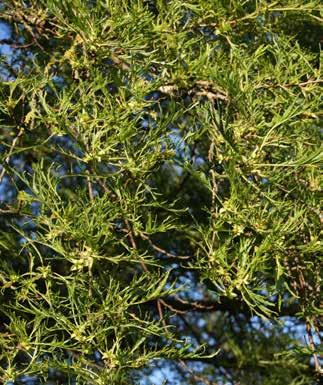
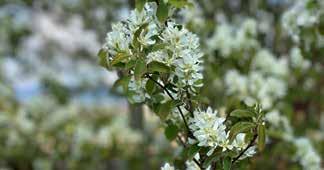
Amelanchier canadensis
‘Prince William’
Tree Shape: Bushy
A deciduous shrub to small tree with showy white blooms in spring followed by edible purple-red fruits in late summer Brilliant orange-red autumn foliage
Amelanchier canadensis ‘Rainbow Pillar’® (Glenn Form)
Tree Shape: Bushy
A neat compact tree with upright habit. Upright sprays of white, scented flowers in spring followed by green foliage. Yellow, red and orange foliage in autumn and an abundance of purplish-red fruits, perfect for birds. (Ohio, USA)
Amelanchier x grandiflora ‘Robin Hill’
Tree Shape: Bushy
Pink emerging flowers turn to clusters of white star-shaped blossoms followed by bronze, finely serrated leaves Summery green foliage turns red-purple in autumn Small red berries in autumn are often eaten by birds

Amelanchier x grandiflora ‘Ballerina’
Tree Shape: Bushy
Small tree with an upright habit Finely toothed leaves are bronze when young, green in summer and reddish-purple in autumn
Large, pure white flowers in April, followed by small red fruits that turn deep purple (Netherlands)
Amelanchier laevis ‘R J Hilton’
Tree Shape: Bushy
Distinctively pink when in bud opening to large, white flowers, contrasting with the deep copper-coloured emerging leaves
Excellent tints of red and yellow autumn leaf colours, followed by blue-black berries (Canada)
Amelanchier laevis ‘Snowflakes’
Tree Shape: Bushy
(Smooth Serviceberry) Small tree or large bush of ascending habit Large, hanging, single white flowers in April, contrast with the emerging copper foliage Edible blackish fruits arrive before the rich bronze-red autumn colour
Amelanchier lamarckii
Tree Shape: Bushy
A small tree or large shrub with a bushy, spreading habit Oval shaped leaves are coppery red and silky when young, turning orange and red in autumn Small white flowers in spring followed by edible black fruits 4
Arbutus unedo
Tree Shape: Bushy
(Killarney Strawberry Tree) Small, evergreen, spreading tree with deep brown, shedding bark contrasting against the large, dark green, leathery leaves Small, white flowers and red strawberrylike fruits simultaneously in late autumn (SW Ireland)
Betula alba pendula
Tree Shape: Standard
(Common Silver Birch) Variable, silver peeling bark develops with age, slightly pendulous branches Diamond-shaped green leaves turn buttery yellow in the autumn. Yellowish-brown catkins develop over winter (Europe and N Asia)
Betula costata ‘Daleside’
Tree Shape: Standard
The white, creamy, smooth bark is comparable to the best of white utilis forms Peels in large sheets, revealing the under-layer Dark green leaves in spring alongside the long green catkins that turn yellowish-brown. (Harrogate, UK)
Betula ermanii ‘Grayswood Hill’
Tree Shape: Standard
A graceful birch of open, slender habit Creamy white and pink exfoliating bark with horizontal lenticels Oval, pale green leaves turn rich yellow in autumn Drooping brown catkins appear in spring
Betula ermanii ‘Polar Bear’
Tree Shape: Standard
Strong growing tree quickly developing a pure white trunk Dark green leaves emerge alongside long, yellowish-brown catkins Golden autumn colour compliments the white exfoliating bark
Betula ‘Fascination’
Tree Shape: Standard
(Chinese Red Barked Birch) Deep orange, satin peeling bark revealing layers of variable colour beneath, turning pale salmonwhite Long brown catkins in spring alongside glossy, green leaves, turning yellow in autumn (Netherlands)
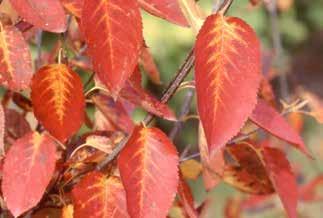
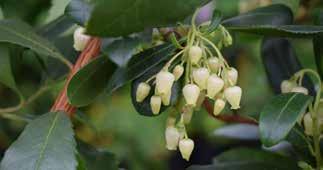
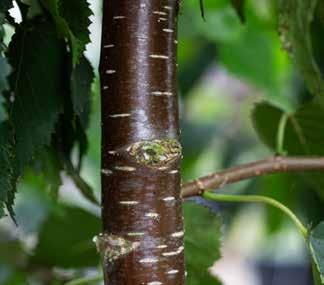
Betula ermanii ‘Mount Zao Purple’
Tree Shape: Standard
An unusual tree with dark purple and orange, peeling bark and prominent horizontal lenticels creating an almost striped appearance The mid-green leaves turn yellow-orange in autumn Named after Mount Zao volcano in Japan
Betula ermanii ‘White Chocolate’® (WVO2F2)
Tree Shape: Upright
A narrow and upright fast growing birch which has a wonderful white bark from an early age Works well when paired with Betula ‘Cacao’. Good autumn colour of yellow and orange. (Netherlands)
Betula ‘Fetisowii’
Tree Shape: Standard
Peeling, creamy chalk-white bark extends up the trunk to the branches Oval-shaped glossy green leaves in spring, turning, rich yellow in autumn Suitable for smaller gardens, forming a narrowheaded tree (C Asia)
Betula nigra ‘Shiloh Splash’
Tree Shape: Standard
(Variegated River Birch) An attractive, bushy, deciduous tree with peeling tan and peach bark The glossy dark green variegated foliage is edged in cream with a pink tinge when young, later turning yellow in autumn Can revert
Betula pendula ‘Dalecarlica’
Tree Shape: Standard
(Swedish Birch) A tall, slender tree with delicately arched branches. Unique, feather-like, bright green leaves turn strong yellow in autumn The glistening white bark provides winter interest and fissures with age (Sweden, 1967)
Betula pendula ‘Golden Cloud’
Tree Shape: Conical
(Golden Birch) Sunny, yellow-lime green, serrated leaves with peeling creamy-cinnamon bark Golden Cloud has a neat narrow conical habit when mature
Betula pendula ‘Karaca’®
Tree Shape: Weeping
An attractive, naturally dwarf, weeping birch. Leaves are very fine, feathery and delicately cut, emerging yellowy green in spring Produces catkins in late winter and a white bark with age Perfect for small spaces, as a large shrub or even to grow in a pot
Betula pendula ‘Spider Alley’
Tree Shape: Standard
Twisted branches and a symmetrical narrow head Peeling bark is predominantly silver with patches of pink and brown on younger wood Heart shaped, serrated leaves in spring turn golden in autumn
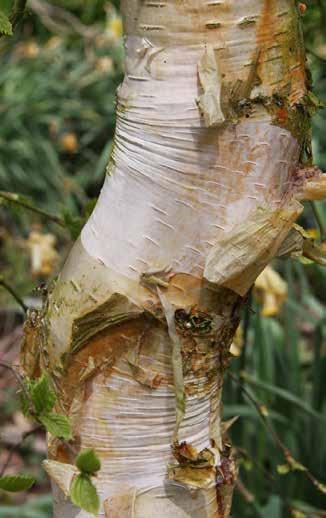
Betula papyrifera ‘Saint George’
Tree Shape: Standard
White and pale tan bark, contrasting with the dark brown of the branches Leaves are smooth and relatively small, on warty shoots and dark green in colour Turns stunning shades of yellow during the autumn (Canada)
Betula pendula ‘Fastigiata Joes’® (JOLEP 1)
Tree Shape: Upright
Very narrow and neat pyramidal growing habit Small, green leaves in spring alongside the yellow catkins Bark turns white after 4-5 years with twisting branches Autumn colours of yellow and orange (Netherlands)
Betula pendula ‘Golden Obelisk’
Tree Shape: Upright
A distinctive columnar variety with fresh yellow-green foliage The silver-white, exfoliating bark stands out year-round, particularly in winter when the bare structure and bark take centre stage
Betula pendula ‘Royal Frost’®
Tree Shape: Standard
The white stemmed bark is complimented with cinnamon hues Yellow, orange and red autumn colour provide a stunning, additional feature to this tree One of the best birch for variety of colour. (Wisconsin, USA, 2006)
Betula pendula ‘Youngii’
Tree Shape: Weeping
(Young’s Weeping Birch) Mushroom-headed, weeping tree with branches that reach the ground Rough white bark has black fissures with age Serrated, glossy green leaves in spring followed by golden yellow autumn colours
Betula utilis ‘Buddha’
Tree Shape: Standard
A fast growing medium sized tree, with attractive pinkish brown copper bark, thinly washed with white and heavily-veined Dark green, large, glossy leaves appear in spring, turning buttery yellow in autumn (Nepal, 1976)
Betula utilis ‘Cinnamon’
Tree Shape: Standard
Stunning rich cinnamon brown bark, smooth to the touch with attractive horizontal golden lenticel markings. The bark starts to peel at an early age Catkins are produced in spring Resistant to birch rust. Selected by Frank P Matthews. (2022)
Betula utilis ‘Dark-Ness’
Tree Shape: Standard
An attractive, medium sized birch with dark shiny bark and conspicuous white lenticels A good, upright growth habit Dark green foliage appears in spring, turning to a buttery yellow in the autumn (Bhutan, 1984)
Betula utilis ‘Edinburgh’
Tree Shape: Standard
Noted for its vigour and upright habit, eventually developing a striking white bark Glossy green leaves in spring alongside the dark brown catkins The yellow autumn colour contrasts well with the white bark (Edinburgh, Scotland)

Betula utilis subsp albosinensis ‘Hergest’
Tree Shape: Standard
A rare selection that produces matt green, sharply toothed leaves on warty and downy shoots The light copper-brown shiny bark has white lenticels on the branches shading to pinkish-white at the base. (Herefordshire, UK)
Betula utilis subsp� albosinensis
‘Pink Champagne’
Tree Shape: Standard
(Chinese Red Barked Birch) A deciduous tree with a spreading crown and pale pink bark, which peels in sheets in the winter months The delicate, pale green foliage turns lovely shades of yellow in the autumn (China)
Betula utilis subsp albosinensis
‘Red Panda’
Tree Shape: Standard
A strong growing, upright form Copper-pink early peeling bark exposes grey and purple shades beneath Oval, tapering dark green leaves turn buttery yellow in autumn followed by yellowish brown catkins in spring (1980)
Betula utilis var� jacquemontii
Tree Shape: Standard
(Himalayan White Birch) A popular form with ascending branches forming a spreading head Coppery-brown bark on young wood peels to leave white bark Dark green serrated leaves turn goldenyellow in autumn (India/Nepal, 1880)
Betula utilis ‘Melony Sanders’
Tree Shape: Standard
A strong growing birch with a gorgeous dark mahogany, peeling bark, similar to ‘Dark-Ness' Collected from China by Maurice Foster
Betula utilis ‘Moonbeam’
Tree Shape: Standard
A fine birch, considerably smaller than other forms, perfect for the small garden The bright white, peeling bark takes centre stage throughout the year. The green leaves turn a buttery-yellow in the autumn. (Wakehurst Place, Sussex, UK)
Betula utilis ‘Snow Queen’
Tree Shape: Standard
(Syn: B. jacquemontii ‘Doorenbos’) Produces showy, exfoliating, white bark within three years Ovate, mid-green foliage and yellowish-brown catkins in spring. Strong, attractive yellowishgolden tints in autumn (1933)
Betula utilis ‘Wakehurst Place Chocolate’
Tree Shape: Standard
One of the darkest birch available with true, chocolate bark in the early years changing to shades of brown as it ages An upright growth habit The dark green foliage covers the tree in spring turning golden during the autumn
Betula utilis subsp albosinensis ‘Cacao’® (C1)
Tree Shape: Upright
A narrow and upright, fast growing birch which has a wonderful dark, chocolate coloured stem from an early age Good autumn colour of yellow and orange (Netherlands)
Betula utilis subsp albosinensis ‘Kansu’
Tree Shape: Standard
(Chinese Red Barked Birch) Two-layered bark with multi-coloured copper and pink colours, flaking off to reveal the underlayers. Shiny, dark green leaves turn buttery yellow in autumn. Yellowishbrown catkins in spring
Betula utilis subsp� albosinensis ‘Red Lady’
Tree Shape: Conical
One of the best example of the attractive red/brown peeling bark of the species The tree is neat, upright with a fine display of catkins followed by glossy green leaves that turn golden yellow in the autumn 3
Betula utilis subsp. albosinensis
‘Ruby Chocolate’®
Tree Shape: Upright
Wonderful, light pink bark peels attractively with age. A narrow, neat, upright habit, great for small spaces Small, green leaves appear in spring, alongside the yellow catkins Great autumn colours of yellow and orange (Harrogate)
Betula utilis var� jacquemontii ‘Jermyns’
Tree Shape: Standard
A vigorous, healthy white barked form with a broadly conical habit Large catkins and glossy green leaves in spring The whiteness in the trunk takes a little more time to develop but is well worth the wait (1960)
Betula utilis var� jacquemontii ‘McBeath’
Tree Shape: Standard
A slow growing form with an upright habit One of the whitest of all birch with glossy green leaves and buttery yellow autumn foliage. Yellowish-brown catkins appear in spring with the fresh leaves (India)
Betula utilis var jacquemontii
‘Silver Shadow’
Tree Shape: Standard
Peeling white bark is highlighted with silvery-grey hue The long, yellow catkins in spring appear alongside the fresh, drooping, dark green foliage. A hardy variety bringing year round interest. (UK)
Betula utilis var jacquemontii
‘Trinity College’
Tree Shape: Upright
White, exfoliating bark develops from an early age Retains its green foliage well into the autumn before turning golden yellow
An upright form, graceful and light in stature, an excellent choice for small spaces (1881)
Calycanthus ‘Aphrodite’
Tree Shape: Bushy
Large shrub or small tree, covered in fragrant red-purple
Magnolia-like flowers, for up to two months! Glossy green leaves turn buttery-yellow in autumn. All parts are fragrant including the leaves, flower and bark 4
Carpinus betulus
Tree Shape: Standard
(Common Hornbeam) Grey fluted trunk with ovate and serrated, ribbed leaves turning yellow in autumn and later brown Green catkins in late spring followed by clusters of winged nuts in autumn (Europe/Asia)
Carpinus betulus ‘Chartreuse’® (Carpsim EU27 PBR)
Tree Shape: Standard
A unique slightly less vigorous hornbeam In spring and early summer the foliage is golden-lime green, slowly turning chartreuse yellow-green from mid-summer onwards Suitable for specimen and hedging use (2022)
Carpinus betulus ‘Lucas’
Tree Shape: Standard
A good upright form with an erect pyramidal habit, narrow as a young tree, broadening with age Perfect for screening or planted along a drive or avenue The dark green leaves turn golden-yellow during autumn



Carpinus betulus ‘Frans Fontaine’
Tree Shape: Upright
Medium tree of pyramidal habit, narrow when young, broadening as it matures Bright green spring foliage, oval in shape, extremely ribbed and serrated around the edges, turning mellow yellow in autumn (Netherlands, 1980s)
Carpinus betulus ‘Rockhampton Red’®
Tree Shape: Standard
Deeply ribbed green foliage turns bright red and orange, normally persisting until mid-late November when the leaves turn brown
A high proportion of the brown leaves remain on the tree until the following spring. (UK, 2016)
Castanea sativa
Tree Shape: Standard
(Spanish or Sweet Chestnut) Large, fast growing tree with twisting bark once mature. Yellow catkins appear in July. Rich brown ‘conkers’ encased in a prickly shell develop in the autumn. (Europe and Asia)
Catalpa bignonioides ‘Aurea’
Tree Shape: Spreading
Low spreading habit with a domed crown Large, heart-shaped, golden velvety leaves fade to green in summer, yellow in autumn
Occasional panicles of white flowers in June/July (1870s)
Catalpa erubescens ‘Purpurea’
Tree Shape: Spreading
Slightly spreading form producing large, heart-shaped leaves, deep glossy purple, turning dark-green, then chocolatey-purple
Creamy white flowers with purple and orange markings, followed by long seed pods
Ceanothus arboreus ‘Trewithen Blue’
Tree Shape: Bushy
An evergreen tree with profuse, slightly scented, dark-blue flowers, in clusters from April to June Very popular with bees and other pollinating insects, due to the masses of flowers that cover them
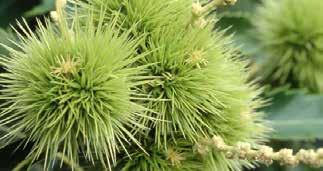

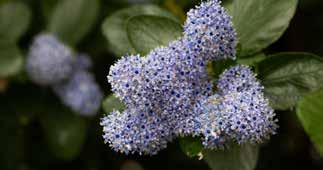

Cedrus atlantica ‘Glauca’
Tree Shape: Standard
(Blue Atlantic Cedar) Conical young plant, broadening with age Dark grey fissured bark and silvery blue needle like, evergreen foliage on arching branches Greenish brown cones in late summer to early autumn
Cedrus atlantica ‘Glauca Pendula’
Tree Shape: Weeping
(Weeping Blue Cedar) A hardy, small to medium weeping, evergreen tree with twisted branches Covered with small cones in spring, and silvery bluish green needles which provide all year round interest (France)
Cedrus deodara
Tree Shape: Conical
(Himalayan Cedar) A beautiful evergreen tree with a graceful, pendant habit Glaucous blue/green needle like foliage Will do well in most soils (Himalayas, 1830s)
Cedrus deodara ‘Klondyke’
Tree Shape: Weeping
(Himalayan Cedar) This interesting cedar really stands out having bright chartreuse green needles in summer and bronze gold winter colour Makes a small, upright spreading tree with a tidy habit (Canada)
Cedrus libani
Tree Shape: Spreading
(Cedar of Lebanon) Large, wide spreading tree, conical when young, flat topped and tiered when mature The leaves are green or greyish green Barrel shaped cones are purple-green then brown (1645)
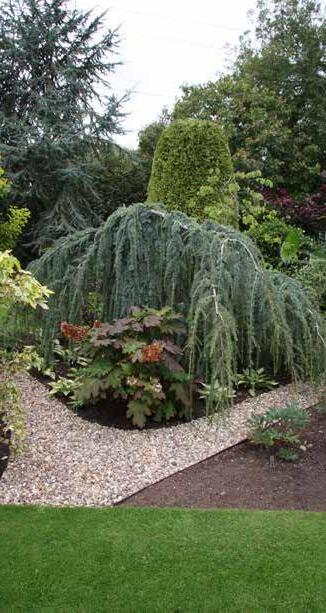
Celtis australis
Tree Shape: Standard
Commonly known as the European Nettle Tree or Mediterranean Hackberry is prized for its graceful form and drought tolerance
Yellow-green flowers in spring are followed by small, dark purpleblack fruits, hanging in clusters

Cercidiphyllum japonicum
Tree Shape: Standard
Broadly heart-shaped leaves, bronze-tinted when young, yellow, orange and pink in autumn, smelling of burnt sugar as they fall Tiny red flowers on naked branches in spring (Japan/China, 1881)
Cercidiphyllum japonicum ‘Peach’
Tree Shape: Standard
Very attractive, Japanese deciduous tree. Bronze leaves when young, turn rich green, then pink, oranges, and reds in the autumn, especially when planted on acid soil. Gives off a lovely, sweet peach like scent during the autumn months
Cercidiphyllum japonicum ‘Pendulum’
Tree Shape: Weeping
(Weeping Katsura Tree) Very pendulous branches, creating a broad, weeping shape Bark is grey, peeling in strips when mature Light bronze-green emerging leaves, blue-green in summer, orange, red and purple in autumn
Cercidiphyllum japonicum ‘Raspberry’
Tree Shape: Standard
Very attractive, Japanese deciduous tree. Bronze leaves when young, turn rich green, then pink, oranges, and reds in the autumn with deeper raspberry pink autumn colour, especially when planted on acid soil. Gives off a lovely, sweet scent during the autumn months
Cercis canadensis ‘Ace of Spades’®
Tree Shape: Bushy
Extremely deep purple colouration almost to the point the leaves appear black Glossy leaves keep their intense colour well through summer Bright lavender flowers appear in spring before the foliage
Cercis canadensis ‘Alley Cat’
Tree Shape: Bushy
Deciduous tree with a shapely oval form and variegated foliage
Dark pink, pea-shaped flowers in April Leaves emerge copper pink and soft green, maturing to white, making a lovely contrast to the green. (USA, 2016)
Cercis canadensis ‘Carolina Sweetheart’®
Tree Shape: Bushy
Umbrella-like habit, often multi-trunked with a rounded crown. Rich maroon, heart shaped leaves in early spring, becoming green with a white margin Pretty pink-purple flowers in spring (North America)
Cercis canadensis ‘Cascading Hearts’
Tree Shape: Weeping
A beautiful weeping form of Cercis canadensis. Smaller green leaves during the summer turning golden in autumn Small lavender sweet-pea like flowers erupting from bare stems in the spring.

Cercidiphyllum japonicum ‘Strawberry’
Tree Shape: Standard
Bred for its outstanding, reliable, strawberry pink and creamy yellow autumn colours The small heart shaped foliage emerges dark red in spring turning green in summer The fallen leaves give off a burnt sugar or candy floss scent.
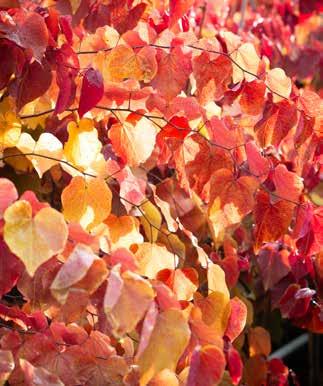
Cercis canadensis ‘Eternal Flame’®
Tree Shape: Bushy
(Syn: Flame Thrower®) Glossy foliage emerges fiery red, turning burnt orange-yellow as they age The colour display persists through the season, showing different shades on one branch. Small pink flowers in spring
Cercis canadensis ‘Forest Pansy’
Tree Shape: Bushy
5
In spring, crimson, purple or pink flowers appear on the bare stems Heart-shaped leaves emerge a glossy, vibrant ruby red, darkening to rich purple-plum in summer, turning orange, red, yellow and purple in autumn
Cercis canadensis ‘Hearts of Gold’®
Tree Shape: Bushy
5
A rounded, slightly spreading shape boasting purple-red, pealike flowers in spring Heart shaped foliage emerges orange-red, turning translucent yellow to yellow-green in summer, then golden yellow in autumn. (USA)
Cercis canadensis ‘Pink Pom Poms’®
Tree Shape: Bushy
Cercis canadensis ‘Golden Falls’®
Tree Shape: Weeping
4
Very steep pendulous shape and multi-branching nature, with heart-shaped golden yellow/green leaves. Covered in pretty pink pea-like flowers in May Eventual shape is a natural very tight columnar form. (USA)
Cercis canadensis ‘Merlot’®
Tree Shape: Bushy
5
(Weeping Redbud) A deciduous tree producing fully double, reddish-pink flowers in spring Coppery-bronze heart shaped, new leaves mature to a glossy green, turning yellow in autumn. (USA)
Cercis canadensis ‘Ruby Falls’®
Tree Shape: Weeping
(Weeping Redbud) A graceful tree of weeping habit with heartshaped leaves emerging a rich purple Clusters of bright pink pealike flowers in spring followed by flattened, deep purple pods. Perfect for small gardens
Cercis canadensis ‘Vanilla Twist’®
Tree Shape: Weeping
5
The glossy, deep purple-red, cordate or heart-shaped leaves turn to a rich green colour by mid-summer, then turning orange and gold in autumn Strong bright pink flowers are produced on mature plants in spring. (USA)
Cercis canadensis ‘Rising Sun’™
Tree Shape: Bushy
Heart-shaped foliage emerges apricot, maturing to yellow then bright green in summer, turning yellow and orange in autumn Abundant pea like, lavender flowers in spring on the bare branches. (USA, 2006) 4
Cercis canadensis ‘White Pom Poms’®
Tree Shape: Bushy
Stunning fully double white flowers in spring, followed by copperbronze heart shaped, new leaves that mature to a glossy green, and turn yellow in autumn A deciduous, rounded small tree 5 5
Cercis canadensis ‘Zig Zag’®
4
(Weeping Redbud) Small tree with pronounced weeping habit Cascading bare branches are covered in white pea-shaped blossom in early spring Heart-shaped leaves remain light green throughout the season
Cercis chinensis ‘Avondale’
Tree Shape: Bushy
4
Produces rich purple-pink flowers on bare stems in late AprilMay Rich green, glossy heart shaped foliage emerges tinted red-purple when they unfurl. The foliage turns shades of buttery yellow in the autumn
Cercis reniformis ‘Oklahoma’
Tree Shape: Bushy
5
(Oklahoma Redbud) Wine-red flowers smother the branches in early spring Heart-shaped foliage emerges with a soft pink tinge, maturing to rich green. Yellow autumn colour but can turn orange and purple as well (Oklahoma, 1964)
Chitalpa tashkentensis ‘Summer Bells’
Tree Shape: Standard
6
(Desert Willow Tree) Small tree covered in dark green, narrow, lance-shaped leaves Prized for the mass of pink, orchid-like blooms which appear on the tree throughout the summer Starts flowering in late spring and flowers until late autumn (Uzbekistan, 1960s)
Tree Shape: Bushy
5
Produces unique zig-zag shaped branches which create a striking shape, especially in winter Pea-like pink flowers appear in spring followed by heart shaped foliage The leaves transform to shades of orange in autumn before falling
Cercis chinensis ‘Diane’
Tree Shape: Bushy
4
Rich purple-pink flowers in spring Green, glossy heart shaped foliage emerges tinted red-purple, turning shades of buttery yellow in the autumn for added interest A more tidy habit than Avondale. (Kent)
Cercis reniformis ‘Texan White’
Tree Shape: Bushy
5
Particularly large, milky-white flowers borne in clusters in spring, followed by long dangling reddish seed pods Waxy, heart shaped, glossy, green leaves emerge after flowering, turning yellow in autumn. (Texas, USA, 1960s)

Cladrastis kentuckea
Tree Shape: Bushy
(The Yellowwood) A low branching tree with a wide, round crown. Large, light green leaves in spring, turn clear yellow in autumn Pendant panicles of fragrant, wisteria like white flowers in late spring and early summer. (SE USA)
Clerodendrum trichotomum var. fargesii
Tree Shape: Bushy
(Glory Tree) A vigorous deciduous shrub developing into a small tree Produces masses of fragrant, white starry flowers in summer, followed by bright blue berries in autumn, each surrounded by rich maroon star-shaped calyces (W China 1898)
Cornus alternifolia ‘Argentea’
Tree Shape: Bushy
(Silver Pagoda Dogwood) Variegated dark green leaves, with white margins and a tiered habit after several years In autumn, the leaves turn reddish-purple before dropping Clusters of white flowers in summer
Cornus controversa ‘Variegata’
Tree Shape: Spreading
(Wedding Cake Tree) Distinctive, horizontal, tiered habit Bright green leaves with bold, creamy-white margins, turn red-purple in autumn Cream clusters of flowers in May-June followed by blue/ black fruit. (Exeter, UK, 1880)
Cornus ‘Eddies White Wonder’
Tree Shape: Bushy
A broad, deciduous tree or multi-stemmed shrub Large glossy, dark green leaves turn deep red to purplish red in autumn Each white flower head is surrounded by four to six bracts, and project nearly horizontally from the flower stalk in late spring
Cornus kousa ‘Beni Fuji’
Tree Shape: Bushy
(Szechuan Strawberry) A large shrub or small tree with green, ribbed leaves, turning red and purple in autumn Profusion of light pink bracts going a deeper pink as they age, followed by red fruits in autumn
Cornus kousa ‘Cappuccino’
Tree Shape: Bushy
An elegant, small tree which produces a profusion of pure white bracts alongside its bronze, tinted green foliage Beautiful, rich, mahogany-bronze, autumn colours Can produce small ornamental red fruits after the flowers
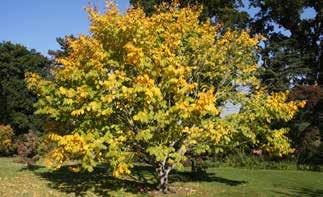


Cornus florida
Tree Shape: Spreading
(North American Flowering Dogwood) Small, bushy tree with dark green, oval foliage, turning rich red and purple in autumn Clusters of small, green flowers surrounded by white or pink bracts, followed by rounded, orange-red fruit
Cornus kousa ‘Big Apple’
Tree Shape: Bushy
A vigorous small tree with large, heavily textured, dark green leaves Large, white petal-like bracts appear in June followed by red edible fruits in autumn
Cornus kousa ‘Mandarin Jewel’®
Tree Shape: Bushy
Gorgeous dark-green leaves that cover this small dogwood, beautifully adorned in spring with masses of white flowers which then develop into interesting mandarin-orange coloured fruits in May-June A real gem for the small garden
Cornus kousa ‘Milky Way’
Tree Shape: Bushy
Small, upright tree, with star shaped, creamy white flowers in early June, followed by raspberry like fruits Leaves are dark green on top and blue-green on the underside, with purple-red autumn colour. (Ohio, USA, 1960s)
Cornus kousa ‘Schmetterling’
Tree Shape: Bushy
A deciduous tree with brightly coloured young stems and clusters of tiny green flowers Large, white bracts surround the flowers followed by edible, pink strawberry-like fruits It's dark green leaves turn red, orange and yellow in the autumn
Cornus kousa ‘White Fountain’
Tree Shape: Bushy
(Weisse Fontaine) Masses of pure white flower bracts in June followed by small red/pink edible fruitlets, like small raspberries Pointy, oval shaped, green foliage turns a rich, brick red with tones of pink and gold in autumn 6
Cornus kousa ‘Wolf Eyes’
Tree Shape: Bushy
6
An elegant tree, variegated cream and green leaves have wavy edges giving them a frilly appearance Spectacular white bracts fading pink over a considerable period from June into early July, followed by strawberry like fruits in the autumn The leaves turn pretty tints of pink in the autumn.
Cornus kousa var chinensis
Tree Shape: Bushy
Spectacular white bracts, fade pink from June into early July, followed by strawberry like fruits Leaves are dark green and slightly curved, with blue-green underside, turning yellow and scarlet red hues in autumn
Cornus kousa var� chinensis
‘China Girl’
Tree Shape: Bushy
A large deciduous shrub with a broad, vase-shaped crown Oval, dark green foliage turns orange and red in autumn Flowers consist of four petal-like bracts with a central round boss followed by strawberry-like fruits in autumn (1978)
Cornus mas
Tree Shape: Bushy
(Cornelian Cherry) Deciduous tree with a spreading, open habit, producing oval, dark green leaves, turning reddish purple in autumn Tiny yellow flowers appear in February, followed by glossy red, cherry like fruits (Europe, 1890s)
Cornus x ‘Norman Haddon’
Tree Shape: Bushy
Large, spreading, semi-evergreen tree Dark green leaves turn warm red in autumn remaining on the branches in mild climates
Four petalled flower bracts are creamy white in June, turning pink as they mature. (Somerset, UK)
Cornus sanguinea ‘Midwinter Fire’
Tree Shape: Bushy
Ovate, mid-green leaves and small, cream/white flowers in May and June Leaves turn orange-yellow in autumn Shoots begin yellow-orange, with the tips turning a brilliant red as the season goes on
Cornus kousa ‘Satomi’
Tree Shape: Bushy
A spreading medium-sized deciduous shrub with ovate leaves turning purple and deep red in autumn Produces a blanket of large, rich pink flower bracts in June, followed by rosy-pink ornamental fruits (1986)
Cornus kousa ‘Teutonia’
Tree Shape: Bushy
A stunning variety that produces masses of large white bracts in June, which become speckled in light pink with age Vibrant midgreen foliage turns to purple-red during autumn and flowers will be followed by red fruits


Corylus avellana
Tree Shape: Standard
Smooth grey-brown bark peels with age Fresh green, heart shaped foliage has a downy underside, turning brownish yellow in autumn Long yellow male catkins and the small red female flowers on the same plant The edible nuts which follow the flowers ripen in autumn
Corylus avellana ‘Contorta’
Tree Shape: Contorted
(Harry Lauder’s Walking Stick/Corkscrew Hazel) Heart shaped, yellow foliage in spring, green in summer, then buttery-yellow in autumn The contorted branches twist and corkscrew in spirals
Long yellow catkins from winter to spring. (UK, 1863)
Corylus avellana ‘Red Ghost’®
Tree Shape: Contorted
A fine selection of the Purple-leaved Filbert where the leaves retain their dark purple/red colour all the way through the summer and into the autumn With the added benefit of producing edible nuts and pink catkins in spring A productive cropper (Holland)
Corylus colurna
Tree Shape: Conical
(Turkish Hazel) Rough, corky bark, along with heart shaped, bright green leaves In early spring long, yellow catkins are produced, followed by clusters of nuts, contained in frilly looking husks in autumn (South East Europe and West Asia)
Cotoneaster frigidus ‘Cornubia’
Tree Shape: Bushy
Vigorous, arching, semi-evergreen tree with long, pointed, mid/ dark green leaves. Fluffy, fragrant, white corymbs of flowers in June-July, followed by brilliant red berries, born in clusters in autumn. (Hampshire, UK, 1930)
Cotoneaster ‘Hybridus Pendulus’
Tree Shape: Bushy
Small evergreen garden tree, with long weeping branches that arch down to create a dome effect. Foliage is rich mid-green and makes a fantastic foil for the white summer flowers and red autumn berries
Cotoneaster salicifolius ‘Exburiensis’
Tree Shape: Bushy
Dense, bushy evergreen with arching branches bearing long, lance shaped leaves, flushed blue/green Large clusters of white flowers in May-June, followed in autumn by yellow, apricot berries that develop a pink tinge. (UK, 1930)
Cotoneaster x suecicus ‘Coral Beauty’
Tree Shape: Bushy
Dwarf, evergreen, low growing shrub, great for covering over an awkward area Dense, dark green foliage is speckled with creamy white flowers in spring which form berries of an orange/red hue by the autumn

Corylus avellana ‘Red Majestic’®
Tree Shape: Contorted
Deep plum-purple foliage in early summer, green tinted as the leaves mature, then bright purple in autumn, before falling to reveal a jumble of curiously twisted stems Pink/purple catkins in late winter and early spring
Corylus maximus ‘Purpurea'
Tree Shape: Bushy
(Purple Leaf Filbert) Heart shaped foliage is rich chocolate purple in spring, fading to a dark green/purple in late summer. Yellow tinged, reddish purple, male catkins in late winter, followed by edible nuts

Cotoneaster salicifolius ‘Repens’
Tree Shape: Bushy
Dense, prostrate, semi-evergreen shrub Small, glossy green leaves in early summer, turn a plum purple in autumn Masses of small, white flowers are produced in summer, followed by red berries (Netherlands, 1948)
Cotoneaster x suecicus ‘Juliette’
Tree Shape: Bushy
A semi-evergreen, low-growing shrub The variegated leaves are small and dark green with pretty, cream margins. White flowers, tinged with pink, in summer, followed by a mass of orange/red berries in autumn
Crataegus x dippeliana
Tree Shape: Standard
5
Small, round-headed tree, great for attracting wildlife to the garden. Dark green, shallow lobed leaves in spring, followed by white flowers with colourful stamens Bears plentiful sweet, juicy red fruits in early autumn. Formally Crataegus arnoldiana. (NE USA)
Crataegus x lavalleei ‘Carrierei’
Tree Shape: Spreading
5
Sparingly thorny, with glossy, dark-green, foliage, turning crimson and bronze in autumn White flowers from pink buds in spring, followed by orange-red haws in autumn Smooth silvery grey bark cracks as it matures
Crataegus x media ‘Pauls Scarlet’
Tree Shape: Standard
5
(Syn: C. laevigata ‘Coccinea Plena’) Small, rounded, thorny tree with lobed, glossy green leaves, turning yellow-bronze in autumn
Deep scarlet-pink, double flowers in May and small red haws in autumn (Hertfordshire, 1858)
Crataegus x media ‘Punicea' Fuchsia Pink
Tree Shape: Standard
Spreading tree with glossy green foliage Lightly scented, small single, fuchsia pink flowers appear in May, later developing into tiny red berries in autumn Flowers from an early age
Crataegus monogyna
Tree Shape: Standard
Fragrant white flowers are produced in spring along with deeply lobed, dark green, glossy foliage Leaves turn bronze and yellow in autumn Glossy dark red haws follow the flowers in autumn The thorny stems make this an ideal barrier
Crataegus x media ‘Crimson Cloud’
Tree Shape: Bushy
Dense, spreading tree with glossy, dark green foliage Profuse, lightly scented, small single, crimson flowers with creamy centres appear in May, later developing into tiny red berries in autumn Flowers from an early age. (USA)
Crataegus x media ‘Punicea Flore Pleno’
Tree Shape: Standard
Small thorny, deciduous tree with shallow, lobed, mid-green leaves, turning yellow and bronze in autumn A mass of double pink flowers in May, often likened to tiny pink roses, followed by red haws (1830s)
Crataegus pinnatifida var� major ‘Big Golden Star’
Tree Shape: Standard
Almost thorn-free, with large, dark green leaves which turn shades of crimson red in autumn Clusters of white flowers in late spring followed by ornamental, edible, red fruit which are nearly as large as some crab apples 5
Crataegus monogyna ‘Stricta’
Tree Shape: Upright
5
A tough and upright, columnar shaped hawthorn White flowers are borne in clusters in May followed by red berries Deeply lobed green leaves turn yellow in autumn Great where space is limited
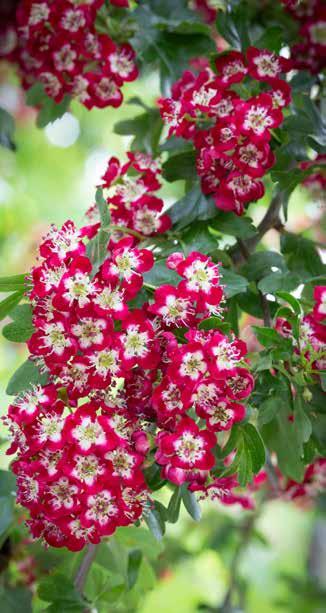
Crataegus x media ‘Plena’
Tree Shape: Standard
Small, shrubby, deciduous tree forms a spreading canopy of shallowly lobed rich green leaves White, double flowers in spring, develop a faint pink flush Sterile, so produces no fruit Branches are protected by short thorns
Crataegus persimilis ‘Prunifolia Splendens’
Tree Shape: Bushy
(Frosted Thorn) Dark-green, broadly oval foliage turns yellow, orange and copper in autumn Single white flowers appear amongst the spiny branches in May, followed by red fruits in autumn, which hang well into the winter
Crataegus schraderiana
Tree Shape: Standard
A striking small tree with silvery blue cut foliage Creamy flowers appear in May which are then followed by an abundance of large purple fruits Extremely hardy and ideal for the smaller garden 5
Crataegus succulenta ‘Jubilee’
Tree Shape: Standard
Medium-sized, fast-growing, thorny deciduous tree Mid-green leaves are ovoid with a toothed edge, turning orange-red in autumn White flowers in late spring and early summer followed by spherical, fleshy, edible, red fruit
Cryptomeria japonica ‘Elegans’
Tree Shape: Bushy
A bushy habit with soft, tactile foliage blue/green in spring, turning fresh green through summer, before burgundy-purple and rustyred in autumn and winter The colour changes throughout the year, making for unique year-round interest (Japan, mid-1800s)
Cryptomeria japonica ‘Gracilis’
Tree Shape: Conical
(Japanese Cedar) Strong-growing, conical tree with open, outspread branches and relatively few thin side branches Needles are shorter than those typical of the species Colour is a nice bright green year round (Japan)
Cryptomeria japonica ‘Sekkan-sugi’
Tree Shape: Conical
Small, conical evergreen conifer Herringbone shaped, soft foliage is creamy yellow in spring, green in summer, then bronze and purple in winter Brown cones on the ends of the pendulous branches in autumn
Cupressus arizonica var� glabra ‘Blue Ice’
Tree Shape: Upright
Moderate growing evergreen conifer forming a dense, pyramidal shaped column Feathery, silvery bluish grey foliage holds its colour throughout the year Reddish purple branches and peeling red bark (New Zealand)
Cupressus macrocarpa ‘Wilma’
Tree Shape: Conical
(Monterey Cypress) An attractive small evergreen conifer with a neat, columnar habit Foliage is bright yellow-green and has a lemon scent which is particularly fragrant when the leaves are cut or crushed (Netherlands, 1987)
Davidia involucrata
Tree Shape: Spreading
(Pocket Handkerchief/Dove Tree) Conical at first becoming tall with an upright branching habit, and orange-brown peeling bark, producing large, white flower bracts in May Heart shaped green foliage turns orange and yellow in winter
Davidia involucrata ‘Sonoma’
Tree Shape: Standard
(Pocket Handkerchief Tree) An early flowering cultivar of Dove tree with heart-shaped, dark green leaves Produces beautiful, large, white flower bracts in May from year one (California, 1952)
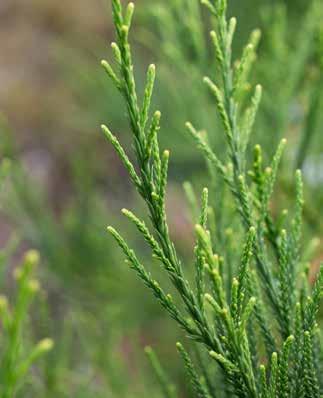

Cupressus sempervirens ‘Totem’
Tree Shape: Upright
The mid-dark green foliage is densely packed on the tree to form a neat and columnar shape and the foliage has a wonderfully fresh fragrance to it A typical Mediterranean tree which grows well in the UK.

Elaeagnus ebbingei
Tree Shape: Bushy
A fast growing, evergreen shrub with large, leathery, dark greygreen leaves with silver speckles and silver undersides Produces highly scented flowers in the autumn and orange berries in the spring A good all-rounder for hedging
Eucalyptus gunnii
Tree Shape: Upright
(Cider Gum) Large, hardy, evergreen with peeling cream and brown bark. Young plants bear silvery blue foliage, then more linear green leaves as it ages White flowers appear amongst the silvery leaves in summer (Tasmania)
Euonymus europaeus
Tree Shape: Bushy
(Spindle Tree) Upright, spreading, deciduous shrub, with narrowly ovate, dark green leaves, turning reddish-purple in autumn
Nectar rich, yellow-green flowers in May/June, followed by scarlet fruits which split to reveal orange seeds in autumn (Native to Asia and Europe)
Euonymus europaeus ‘Brilliant’
Tree Shape: Spreading
(Common Spindle Tree) A large shrub or small tree with a narrow upright habit Mid-green oval leaves turn pink-red in autumn Cream flowers in spring, followed by red pods opening to orange seeds
Euonymus europaeus ‘Red Cascade’
Tree Shape: Bushy
Large, vigorous, deciduous shrub, with oval leaves turning scarlet in autumn Small yellow-green flowers in summer, followed by pinky-orange winged fruits, remaining long after the last leaf has fallen (Native to Asia and Europe)
Euonymus hamiltonianus ‘Indian Summer’
Tree Shape: Bushy
A large deciduous shrub with light green, oval leaves, turning ruby red in autumn Small, pale green flowers are followed in autumn by four-lobed, dusky pink fruit that split to reveal orange seeds (Native to Asia)
Euonymus hamiltonianus ‘Koi Boy’
Tree Shape: Bushy
A small tree or large shrub with an arching habit The white fruits produced in September to November split to reveal striking bright red seeds Mid-green leaves turn a pure lemon yellow in the autumn (Native to Asia)

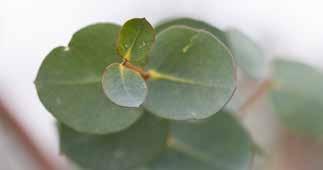

Euonymus phellomanus
Tree Shape: Spreading
A large shrub with corky winged branches and dark green ovate leaves, turning bright yellow and sometimes reddish purple in autumn Long lasting, abundant pink fruits split to reveal bright orange seeds (N and W China)
Exochorda x macrantha ‘The Bride’
Tree Shape: Spreading
A fast growing medium-sized, shrub with a trailing habit From late spring, racemes of pristine white flowers cover the light green foliage After flowering, the leaves take on shades of yellow and orange
Exochorda x Snow Day® ‘Blizzard’
Tree Shape: Bushy
Large shrub or small tree Produces large white flowers twice the size of ‘The Bride’ in spring. Abundant flowering and low maintenance hardy and compact variety
Fagus sylvatica
Tree Shape: Standard
(Common or European Beech) A versatile tree, good for hedging, with smooth silver-grey bark Toothed, dark green leaves turn copper in autumn Small yellow-green flowers are followed by bristly fruits (Europe)
Fagus sylvatica ‘Black Swan’
Tree Shape: Weeping
A good weeping purple beech more compact and with dark purple, almost black, foliage, when in full sun The deciduous, broadly ovate, very glossy leaves turn coppery orange in autumn
Fagus sylvatica ‘Dawyck Gold’
Tree Shape: Upright
A dense, fastigiate, small tree with smooth grey bark Throughout the summer the startling, bright leaves turn slowly to mid-green and then bronze and yellow in autumn (Netherlands 1969)
Fagus sylvatica ‘Dawyck Purple’
Tree Shape: Upright
Leaves emerge burgundy-red in spring, eventually becoming a deep, dark purple, then amber tones before dropping to reveal the smooth, grey, muscly bark. Upright form. (Netherlands. 1969)
Fagus sylvatica ‘Midnight Feather’®
Tree Shape: Standard
(Syn: Black Rianne) A strong grower, with an upright trunk that thickens quickly. Young leaves appear red in spring, turning purple/black, then brown in autumn, hanging onto the tree until the following years growth
Fagus sylvatica ‘Purple Fountain’
Tree Shape: Weeping
Weeping purple beech with a narrow growth habit developing a good dominant central leader Serrated, glossy burgundy leaves, turn an outstanding coppery-bronze in autumn (Netherlands, 1960s)


Fagus sylvatica ‘Pendula’
Tree Shape: Weeping
(The Weeping Beech) A large parkland tree taking on informal weeping shapes with the primary limbs draped with hanging branchlets Foliage is a deep green in summer, turning golden bronze in autumn. (UK, 1836)
Fagus sylvatica ‘Purpurea’
Tree Shape: Standard
A large deciduous tree with a densely pyramidal to rounded spreading crown Red foliage appears in spring, deep purple/ green in summer, then bronze for autumn Small fruits in autumn are popular with deer and squirrels
Fagus sylvatica ‘Purpurea Pendula’
Tree Shape: Weeping
Classic, weeping, purple-leaved form with a mushroom shape Its flexible branches adapt well to training If left to grow naturally, the weeping branches arch and sprawl to create an impressive, purple-black mound (Germany, 1865)
Fagus sylvatica ‘Riversii’
Tree Shape: Standard
A deciduous tree with a dense broad crown and smooth silver bark The serrated, purple leaves turn coppery-bronze in autumn Small yellow-green flowers in spring, followed by bristly fruits ripening in autumn (1880)
Forsythia x intermedia ‘Lynwood’
Tree Shape: Bushy
A vigorous, deciduous shrub, with narrowly ovate, sometimes trifoliate dark green leaves, that turn yellow with purple tinges in autumn Bright yellow flowers cover the tree in spring (N Ireland, 1935)
Ginkgo biloba
Tree Shape: Standard
A large, deciduous tree with a narrow habit and grey bark, ridged and fissured Fan shaped foliage is light-green, turning bright, clear yellow in autumn Small yellow flowers mature to drupelike, light yellow fruits
Ginkgo biloba ‘Blagon’®
Tree Shape: Upright
A deciduous, columnar tree maintaining a narrow crown when mature
A male form, so it will not produce any fruits Leaves are apple green in summer, turning butter yellow in autumn. (France, 1999)
Ginkgo biloba ‘Menhir’
Tree Shape: Upright
A more compact and slender version of Ginkgo biloba with a columnar shape when mature The fan-shaped foliage is bluegreen in summer, deeply cut through the middle, turning buttery yellow in autumn (Netherlands, 1996)
Gleditsia triacanthos ‘Sunburst'
Tree Shape: Standard
An attractive honey locust with delicate fern like golden yellow leaves in spring Older leaves eventually turn green giving a two tone colour to the tree by mid-summer, returning to golden yellow in autumn. (USA, 1954)
Fagus sylvatica ‘Purpurea Tricolor’
Tree Shape: Standard
(Syn: ‘Roseomarginata’) Very attractive form with irregular pink margins to the purple leaves Develops a lighter canopy than most beech Small yellow-green flowers in spring are followed by spiny, capsule-like fruit in autumn
Fagus sylvatica var� heterophylla ‘Asplenifolia’
Tree Shape: Standard
(Fern Leaf Beech) Attractive, narrow, lance-shaped dark green leaves turn copper-gold in autumn Small yellow green flowers in spring, followed by bristly fruits which ripen in autumn. (Loddiges’ Nursery, UK, 1804)



Halesia monticola
Tree Shape: Bushy
A large shrub or small tree producing clusters of small, snowdrop-like, pure white flowers in late spring The flowers are followed by brown winged fruits in the autumn along with stunning autumn foliage
Hamamelis x intermedia ‘Arnold Promise’
Tree Shape: Bushy
An upright, strong growing, compact form Spidery, fragrant, yellow flowers in mid to late winter have good frost resistance The large green leaves turn vibrant shades of yellow and orange in autumn. (USA, 1928)
Hamamelis x intermedia ‘Diane’
Tree Shape: Spreading
A broad-crowned, large deciduous shrub of open habit Large, spidery, brick-red flowers are produced between December and March Green foliage turns fiery shades of red, orange and yellow in autumn (Belgium, 1969)
Hamamelis x intermedia ‘Jelena’
Tree Shape: Spreading
(Syn: H. x intermedia ‘Copper Beauty’) Green foliage in summer, turns spectacular shades of yellow, orange and red in autumn Clusters of flowers in shades of yellow, orange and red from November to January (Belgium, 1930s)
Hamamelis x intermedia ‘Pallida’
Tree Shape: Spreading
A large deciduous shrub with a spreading crown and broad oval, green leaves turning yellow in autumn Pale yellow, spidery flowers with a delicate fragrance appear on the bare branches throughout the winter
Heptacodium miconioides
Tree Shape: Spreading
(Seven Sons Plant) Clusters of jasmine scented, creamy-white flowers from late summer, and bright red calyces in autumn In winter, the tan-coloured outer bark peels back to reveal darker brown underneath (China)



Hoheria sexstylosa ‘Snow White’
Tree Shape: Upright
An evergreen tree with a pyramidal shape, and deeply serrated leaves Masses of stunning white flowers during summer, similar to cherry blossoms An ideal choice to create an evergreen hedge 6
Ilex x altaclerensis ‘Golden King’
Tree Shape: Bushy
A female holly making a compact, conical, evergreen shrub, bearing broad, ovate, slightly spiny leaves, dark green, margined yellow Produces small white flowers followed by red berries in autumn/winter (Scotland, 1870s)
Ilex aquifolium
Tree Shape: Bushy
5
(Common Holly) A slow growing shrub or small tree White flowers appear in May and berries emerge on female plants around November, ripening red and providing a good source of food for birds
Ilex aquifolium ‘Alaska’
Tree Shape: Conical
5
A female, self-pollinating tree producing red berries in autumn/ winter, but will produce even more if sited near a male A more traditional looking holly with spiny green leaves, and an upright habit (Wuppertal, Germany, 1960)
Ilex aquifolium ‘J.C. van Tol’
Tree Shape: Bushy
Hardy, native holly with glossy, dark green, almost spineless leaves Bright red berries appear on dark purple stems in autumn, persisting through the winter One of the most reliable self-fertile fruiting female forms (Netherlands)
Juglans nigra
Tree Shape: Standard
(Black Walnut) Deep furrowed bark and large, oblong purplegreen foliage when young, turning green in summer, yellowbronze in autumn, fragrant when crushed. Yellow-green catkins, and edible nuts. (USA)
Juglans regia
Tree Shape: Standard
(Common/Persian Walnut) Aromatic leaves, bronze when young, later fresh green. Yellow-green male and female catkins in late spring Smooth husks enclose edible creamy-white nuts (Europe/China)


Tree Shape: Conical
5
A stunning variety producing glossy green, prickly foliage with creamy edges, tinged pink Bright red berries, on pollinated female plants, provide food for birds through winter Can be trimmed into a formal decorative hedge
Ilex aquifolium ‘Nellie R Stevens’
Tree Shape: Conical
Glossy green leaves with spines Reliable, long lasting heavy crop of red to orange berries Tiny white flowers in spring A robust, relatively fast growing variety, with a neat pyramidal shape Easy to grow. (Maryland, USA, 1954)
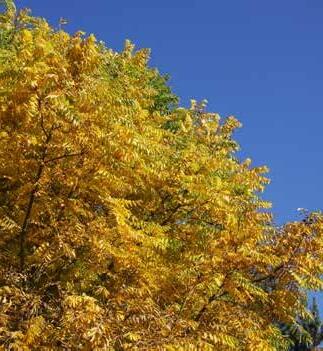
Juniperus scopulorum ‘Blue Arrow’
Tree Shape: Upright
(Rocky Mountain Juniper) An upright narrow form with vivid blue, evergreen foliage An ideal choice for a small garden The blue foliage gives lovely contrast against more common green garden colours. (USA, 1949)
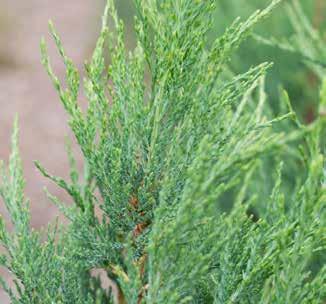
Laburnum anagyroides ‘Yellow Rocket’®
Tree Shape: Upright
A columnar tree with a very narrow upright habit Bright yellow pendant flowers in May The deciduous foliage is green and pinnate, creating a pleasing backdrop for the yellow flowers Seeds can be harmful if eaten
Laburnum x waterii ‘Vossii’
Tree Shape: Standard
Long racemes of fragrant, bright yellow flowers hang from the branches in May and June Light green circular leaves Seeds can be harmful if eaten (Netherlands, 19th Century)
Lagerstroemia indica ‘Eveline'
Tree Shape: Bushy
(Crepe Myrtle) A compact variety Long summer flowering tree with large, beautiful, clusters of pastel pink flowers, enhanced by dark green foliage Hardy down to -18°C
Lagerstroemia indica ‘Rhapsody in Pink'
Tree Shape: Bushy
(Crepe Myrtle) Showy pink blooms are borne in profusion from June right through to September With a delicate, crimped appearance, the flowers create a fabulous pink cloud effect from a distance Peeling bark and golden-orange autumn foliage
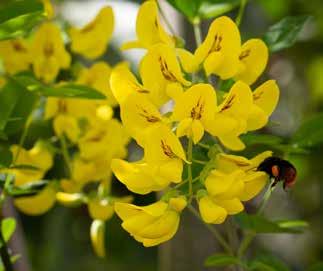

Liquidambar styraciflua
Tree Shape: Standard
The glossy, maple-like leaves of the species can have superb autumn colour, ranging from fiery red, orange and yellow through to sumptuous purple, often staying on the tree into December The older stems have attractive corky bark. (USA)
Liquidambar styraciflua ‘Lane Roberts’
Tree Shape: Standard
Medium sized tree with a broad, pyramidal, fairly open crown Shining maple-like green leaves turning rich, blackish crimson red in autumn One of the best forms with more reliable, intense autumn colours (1971)
Liquidambar styraciflua ‘Palo Alto’
Tree Shape: Standard
Maple like foliage is bright green in summer, turning orange-red to deep purple in autumn Small yellow flowers in summer, followed by round, spiky fruits that make an intriguing feature
Liquidambar styraciflua ‘Stared’
Tree Shape: Standard
Large tree with a narrow pyramidal crown Deeply cut, starshaped leaves are glossy green in summer, transforming to vivid red and scarlet in autumn Small purple-red flowers are followed by spiky fruit capsules
Liriodendron tulipifera
Tree Shape: Standard
A stately tree, conical at first becoming tall and domed. Unusual, angular, bright green leaves turn butter-yellow in autumn. Tulip shaped, yellow-green flowers, banded with orange in June and July on mature plants. (USA) 6
Magnolia ‘Aphrodite’
Tree Shape: Standard
(Red) An upright spreading, small tree, producing goblet shaped magenta red flowers on the bare branches in spring Flowering freely from a young age 4
Magnolia ‘Black Tulip’®
Tree Shape: Conical
4
(Dark Purple) Deep burgundy-purple, tulip-like flowers crowd the slender stems before the green, ovate leaves emerge each spring With cool temperatures and ample moisture it can re-bloom in midsummer (New Zealand, 1998)

Liquidambar styraciflua ‘Slender Silhouette’
Tree Shape: Upright
One of the first Liquidambars with a very fastigiate, columnar habit making it ideal for small spaces The handsome glossy, dark green, maple-like leaves turn in autumn to yellow and red tones
Liquidambar styraciflua ‘Worplesdon’
Tree Shape: Standard
A beautiful tree with long narrow lobed leaves, turning orange and yellow in autumn One of the best forms, with reliable and intense autumn colours Corky, fissured bark creates yet more interest in winter (Surrey, 1968)


Magnolia ‘Blue Opal’
Tree Shape: Standard
(Yellow) A medium to large deciduous shrub with large and rich green leaves Striking, large, blue-green buds appear in spring These unusual blue buds mature to dark yellow flowers with bluegreen outer petals 5
Magnolia campbellii ‘Charles Raffill’
Tree Shape: Standard
(Pink/Purple) Vigorous, upright, later spreading tree with oblong pointed mid-green leaves The early large flowers are deep rosepink in bud, opening rose-purple with a cup and saucer shape
Magnolia ‘Coral Lake’
Tree Shape: Bushy
(Orange Pink) A medium sized tree with a spreading habit, produces upright, tulip shaped, peachy pink flowers with vertical yellow stripes, with a pleasant fragrance
Magnolia ‘Daybreak’
Tree Shape: Standard
(Rose Pink) A superb, small to medium tree of a broad pyramidal outline, with distinctive fissured bark Emerging buds with a slight green cast open to large, scented, coral pink blooms in April-May, even on young plants 4
Magnolia ‘Elisa Odenwald’
Tree Shape: Bushy
(White) A small shrub like tree with an upright habit Large, fragrant, cup-shaped flowers are creamy white with a hint of purple-pink at the base, and pure white within One of the latest flowering and best of the white magnolias
Magnolia ‘Galaxy’
Tree Shape: Conical
(Rich Pink) Flowering when quite young this vigorous yet small conical tree has striking, purple-pink to red tulip shaped flowers, opening from deep red-purple buds in mid to late spring (USA, 1963) 4
Magnolia ‘Golden Pond’
Tree Shape: Bushy
(Deep Yellow) A hardy, deciduous, large shrub or small, bushy tree, flowering fairly late but still before leaf-burst so not obscured by them Narrow, upright, tulip-shaped, mid-yellow flowers (1997)
Magnolia grandiflora ‘Ferruginea'
Tree Shape: Conical
(White) An erect form of compact habit, with ovate, deep glossy green leaves all year round with a coppery red colouring on the leathery under leaf Large, creamy white, lotus-like flowers are citrus scented
Magnolia ‘Heaven Scent’
Tree Shape: Standard
(Pink) A small to medium tree with dark green foliage Tulip shaped, heavily flushed dark pink or rose-purple flowers with a magenta stripe at the base Richly scented, one of the finest of the ‘Gresham Hybrids’.
Magnolia x brooklynensis ‘Yellow Bird’
Tree Shape: Conical
(Yellow) A compact, small to medium, upright tree with very erect daffodil yellow flowers appearing in mid-May for three weeks. The dark green foliage contrast well with the flowers, turning yellowy brown in autumn (1967)
Magnolia ‘Cleopatra’
Tree Shape: Conical
(Reddish Purple) An upright small tree with a columnar to pyramidal habit, ideal for gardens with limited space. Attractive red-purple flowers displaying a metallic sheen are produced in abundance in spring (New Zealand, 1998) 4
Magnolia ‘Daphne’
Tree Shape: Standard
(Deep Yellow) Large compact shrub or small tree with an upright habit, and elliptic, green foliage Long lasting, deep yellow, cup shaped flowers born upright at the tips of each branch, from April to May (Belgium)
Magnolia ‘Elizabeth’
Tree Shape: Conical
(Yellow) A small conical tree. Fragrant, pale primrose yellow blooms are upward facing with long tapering buds, opening to reveal red stamens Large glossy oval leaves mature to dark green, turning golden yellow in autumn
Magnolia ‘Eskimo’
Tree Shape: Standard (White) A large, upright, rounded shrub with a spreading habit Large, cup shaped, white flowers with a hint of lilac appear on the bare stems in early spring Valued for its frost hardiness down to -6C. (USA)
Magnolia ‘Genie’®
Tree Shape: Bushy
(Deep Red) The fragrant, tulip shaped flowers start blackish red and open to rich maroon Flowering lasts for several weeks in spring, often followed by a second flowering period in midsummer A compact growth habit (New Zealand)
Magnolia grandiflora ‘Exmouth'
Tree Shape: Conical
(White) An upright, vigorous tree with evergreen, elliptical leaves that are waxy green above with a reddish brown indumentum beneath that disappears with age Large fragrant flowers appear from an early age
Magnolia grandiflora ‘Kay Parris’
Tree Shape: Bushy
(White) Compact, evergreen, upright shrub like tree when mature Highly fragrant, large cup shaped creamy white flowers from summer to autumn Glossy deep green leaves, are rich rusty brown beneath
Magnolia ‘Honey Tulip’®
Tree Shape: Conical
(Yellow) A small, upright deciduous tree perfect for the smaller garden, flowering from a young age The goblet-shaped, goldenyellow flowers bloom on bare branches before the dark green foliage emerges (New Zealand) 3
Magnolia ‘Joli Pompom’
Tree Shape: Standard
(White) A handsome, compact, deciduous shrub, blooming in early spring One of the purest white Magnolias, cup-shaped with soft rose pink stamens and pale green anthers (Belgium)
Magnolia ‘Lois’
Tree Shape: Bushy
(Cream Yellow) A large, deciduous shrub or tree of conical habit which flowers profusely as it matures Sulphur yellow, upright, goblet shaped flowers appear mid-April and have a slight fragrance. (USA)
Magnolia ‘Peachy’
Tree Shape: Standard
(Orange Pink) A fast growing medium-sized tree, initially upright in habit but spreading with age The fragrant orange-pink flowers, creamy white on the inside, are quite large, unfurling in late April or early May
Magnolia salicifolia ‘Mount Hakkoda'
Tree Shape: Bushy
(White) A special selection of the willow leaved magnolia Floppy white star shaped petalled flowers similar to 'Wada's Memory' Attractive glaucous green foliage that when crushed offers the scent of aniseed and verbena A deciduous tree, conical when young, later broad-crowned 4
Magnolia ‘Spectrum’
Tree Shape: Conical
4
(Purple Pink) A small to medium sized tree, developing a broad, pyramidal outline as it matures Flowers are deep reddish-pink on the outside, creamy white within and have an erect poise (USA, 1963)
Magnolia ‘Sunsation’
Tree Shape: Standard
Magnolia ‘Judy Zuk’
Tree Shape: Bushy
(Peach/Yellow) Spectacular peach, tulip shaped flowers. The flowers are scented and are fairly late flowering so avoids most frosts A small tree of upright vase shape and of compact habit
Magnolia ‘Livingstone’
Tree Shape: Standard
(Dark Purple) A small upright tree becoming more rounded as it matures Large numbers of vibrant, dark purple-red flowers are produced in spring once established (New Zealand) 4
‘Rebeccas Perfume’
Tree Shape: Standard
(Light Pink) Named for its attractive, scented blooms appearing in April Goblet shaped creamy white flowers with pink-purple bases to the petals flowering over a long period (New Zealand) 4
Magnolia ‘Shirazz’
Tree Shape: Bushy
4
(Burgundy) An attractive small, deciduous tree at maturity, with deep green foliage throughout summer Spectacular, large, rich burgundy/red, tulip shaped blooms, open out flat revealing a pale interior (New Zealand)
Magnolia stellata ‘Royal Star’
Tree Shape: Spreading
3
(White) A superior form of Magnolia stellata with pale silverypink buds opening to a clear white, touched with pink each with up to twenty five tepals Flowers larger and later than other stellata types
Magnolia ‘Susan’
4 4
(Yellow) Deep yellow, goblet shaped flowers, with a rosy-purple blush at the base appear before the large, glossy green foliage emerges. Hardy in most places throughout the UK even in severe winters. (Carolina, USA)
Tree Shape: Bushy
(Purple) A dense growing small tree or large shrub The blooms are deep purple in bud, opening white stained purple, with a delicate musky scent and flower over a long period through April and May. (USA)

Malus ‘Admiration’
Tree Shape: Upright
(Adirondack) A dwarf, upright growing, shrubby, small tree ideal for restricted spaces Dense clusters of waxy white flowers follow dark carmine buds in April, followed by persistent red-bronze fruits. (Washington, USA, 1985)
Malus ‘Aros’®
Tree Shape: Upright
A dwarf, upright tree Shiny leaves emerge dark burgundy-black turning green with age Bright purple/pink flowers with white centre, turn to small dark red/maroon crab apples in autumn Ideal for patios (Denmark)
Malus baccata
Tree Shape: Standard
(Siberian Crab Apple) Making a rounded crown with oval, finely toothed dark green leaves A profusion of white fragrant cup shaped flowers in spring are followed by small egg shaped red fruits (NE Asia)
Malus ‘Bunbury White’
Tree Shape: Bushy
A compact crab apple that produces a profusion of white blossoms in spring, followed by small, red fruits that persist into winter. Ideal for small gardens or as part of a mixed border.
Malus ‘Candied Apple’
Tree Shape: Bushy
Striking pink blossoms in spring and bright red, candy-like apples in the autumn The crab apples look like mini eating apples hanging gracefully over the tree
Malus ‘Cardinal’
Tree Shape: Standard
(Syn: Princeton Cardinal) A beautiful foliage and flowering tree with large, intense pink, flowers and dark almost black spring leaves, changing to glossy red in summer Deep red, small fruit in autumn. (USA)
Malus ‘Comtesse de Paris’
Tree Shape: Standard
A small, rounded tree with delicate, white blossom in spring amongst mid-green foliage The smallish, elliptic, yellow fruits usually persist well after Christmas One of the best persistent yellow crabs (France)
Malus ‘Donald Wyman’
Tree Shape: Standard
A strong growing round-headed tree with dark green leaves The pink buds open to white, single flowers in spring, followed by abundant, small, glossy, bright red fruits persisting well into February in most years
Malus floribunda
Tree Shape: Bushy
(Japanese Crab Apple) A very pretty tree in flower, displaying crimson buds opening to white and pale blush petals which come earlier than most varieties Small, red-yellow fruit in autumn (Japan, 1862) 4
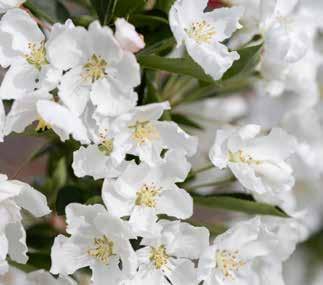
Malus brevipes ‘Wedding Bouquet’
Tree Shape: Upright
An upright small tree when young, widening with age Long tapered dark green healthy leaves, and single shell-shaped, ivory white flowers The tiny berry-like fruits are dark red, and persist well into December
Malus ‘Butterball’
Tree Shape: Standard
A medium spreading tree with slightly drooping branches and pink budded flowers that open to pure white The marble sized fruits are yellow with an orange flush, ideal for crab apple jelly. (USA, 1961)
Malus ‘Candymint’
Tree Shape: Spreading
(Syn: ‘Candymint Sargent’) A dainty tree with horizontally-tiered branches covered with pink and lighter shell pink flowers edged with purple tones Persistent small, dark purple fruit and yellow autumnal leaves. (Indiana, USA, 1987)
Malus ‘Celebration’
Tree Shape: Upright
Neat and upright when young, producing winter persistent and attractive scarlet red fruit. Both the white blossom and fruit are similar but superior to the well-known and deservedly popular M ‘Red Sentinel’. Healthy with consistently heavy crops year on year.
Malus coronaria ‘Elk River’
Tree Shape: Bushy
An unusual form related to Malus ‘Charlottae’. Single, large, soft pink flowers are followed by bright, rich green, mini Granny Smith type crab apples Excellent autumn tints to the large and handsome leaves
Malus ‘Evereste’
Tree Shape: Conical
A conical tree with dark green lobed leaves and large soft pink to white flowers Small red and yellow fruits, like mini apples appear in late summer, holding well into winter An excellent pollinator for apples (1980)
Malus ‘Gardeners Gold’
Tree Shape: Standard
A rare, small tree with a rounded crown White flowers open from pink buds in spring, followed by abundant, large, golden yellow fruit in the autumn
Malus ‘Golden Gem’
Tree Shape: Standard
4
Clouds of large bunches of fragrantly scented, blush white flowers in spring, followed by abundant dainty yellow fruit in autumn An excellent pollinator for apples due to the timeliness and compatibility of its pollen
Malus ‘Gorgeous’
Tree Shape: Standard
4
A small, compact tree with scented apple blossom flowers The crimson or orange-red fruits resemble the perfect miniature apples persisting well into November Ideal for tangy pink crab apple jelly (New Zealand, 1925)
Malus ‘Harry Baker’
Tree Shape: Standard
4
A special variety with exceptionally large, rich, flamboyant pink flowers and dark green-maroon leaves Large, ruby red fruit with a deep pink flesh last into mid-October Makes a superb, deep red jelly. (Suffolk, 1995)
Malus ‘Indian Magic’
Tree Shape: Spreading
Small, rounded, spreading tree, bearing magenta pink flowers which emerge from dark red buds Purple flushed foliage with small, glossy red fruit change to orange and persist into January (USA, 2010) 4
Malus ioenis purpurea ‘Evelyn’
Tree Shape: Standard
4
(Syn: M. ‘Rubra’) A spectacular purple leaved form with large lobed leaves, turning a stunning orange-red in autumn Buds open to single rose-red flowers The fruitlets are of variable colours - green, yellow, red. (USA)
Malus ‘John Downie’
Tree Shape: Standard
4
A vigorous, upright tree when young with bright green leaves White ‘apple blossom’ flowers, open from pink buds in spring. Large bright orange-red, pear-shaped fruits in autumn Popular for crab apple jelly (1875)
Malus ‘Golden Hornet’
Tree Shape: Conical
Small compact tree with an upright habit in its early years Dark green, broadly oval leaves turn yellow in autumn Large white flowers flushed pink followed by bright yellow fruits maturing early in the autumn 4
Malus ‘Halloween’™
Tree Shape: Standard
Yellow-orange crab apples are ribbed in appearance looking like mini pumpkins Perfect for the Halloween season Spring flowers are white and semi double Crops heavily and is perfect for birds and pollinating insects. (Kent, UK) 4
Malus hupehensis
Tree Shape: Standard
A small, spreading, vase shaped tree with stiff ascending branches The fragrant flowers are soft pink in bud opening to white, produced in abundance May to June Small, deep red fruits in autumn (China/Japan, 1900s) 4
Malus ioenis ‘Fimbriata’
Tree Shape: Bushy (Fringed Prairie Crab Apple) An upright, broad headed tree with expanding buds, opening to very fragrant, shell pink, double flowers in late spring Small, dark red fruits are produced before the yellow autumn leaves fall
Malus ‘Jelly King’
Tree Shape: Standard (‘Mattfru’) Strong white blossom covers this vigorous but compact tree in spring Spectacular large orange-pink fruit that persist much longer than most large fruited crab apples Makes excellent pink jelly (New Zealand, 2007) 4
Malus ‘Laura’®
Tree Shape: Upright
A naturally dwarf tree with an upright habit Dark purple-green leaves and stunning pink and white flowers in April Persistent large, round, maroon fruit in autumn, perfect for crab apple jelly (Kent, UK, 1990s) 4

Malus ‘Louisa’
Tree Shape: Weeping
A graceful tree, forming an umbrella shape, one of the best weeping Malus Dark green, glossy leaves, and rose coloured buds open to true pink flowers in spring Small lemon-gold, ripening to golden-orange fruit in autumn
Malus ‘Mary Potter’
Tree Shape: Bushy
A cross between M sargentii Rosea and atrosanguinea Pink in bud with white, spring fragrant flowers which are followed in autumn by glossy red small crab apples which hang on the tree throughout the winter becoming a natural bird feeder. (USA)
Malus ‘Pink Glow’
Tree Shape: Standard
(Syn: Malus baccata ‘Dolgo’, Malus x robusta ‘Dolgo') A roundheaded tree with strong single white flowers followed by bright pink fruit that look like plums One of the best early season fruiting crab apples for making jelly
Malus ‘Prairie Fire’®
Tree Shape: Standard
A superb small tree, upright in habit, with dark purple to green narrow leaves Vibrant deep pink, single flowers in spring are followed by attractive, small, spheroid, purple fruit in the autumn. (Illinois, USA, 1982)
Malus x purpurea ‘Crimson Cascade’
Tree Shape: Weeping
A beautiful compact weeping crab apple Bright pink flowers in spring are followed by red/purple crab apples in autumn The foliage is purple turning bronze and green throughout the year (Yorkshire, UK, 1980s)
Malus ‘Red Obelisk’®
Tree Shape: Conical
A compact upright tree when young, with light pink flowers followed by attractive, conical, red fruits. Foliage is purplishbrown at first, later becoming dark green Good for crab apple jelly (Belgium) 4
Malus x robusta ‘Red Sentinel’
Tree Shape: Standard
A small rounded tree, with dark green leaves turning bronzed yellow in autumn White blushed, fragrant flowers emerge from pink buds in April, followed by large, bright red fruits, which often last all through winter
Malus ‘Royalty’
Tree Shape: Bushy
A small, round tree with attractive, taper-pointed, glossy, dark purple leaves, turning red in autumn Large purplish-crimson flowers, amongst the foliage are followed by dark red fruits (Canada, 1953)
Malus ‘Rudolph’
Tree Shape: Conical
A medium tree of upright habit with glossy, bronze-red, later dark bronze-green leaves on red young shoots Rose red flowers, deeper in bud, are followed by long persistent, orange-yellow oblong fruits (Canada, 1954)
Malus ‘Madonna’ (Mazam)
Tree Shape: Upright
Stunning large double white flowers resembling pure white roses Flowering over several weeks with fragrance of jasmine and gardenia Small brown fruit Tree of compact neat habit, particularly upright when young. (USA, 1979)
Malus x moerlandsii ‘Profusion Improved’
Tree Shape: Standard
(Syn: M. ‘Directeur Moorlands’) Coppery red foliage when young, turning dark forest green, then yellow/bronze in autumn Reddishpurple flowers in April followed by persistent, deep purple fruits in autumn
Malus ‘Pink Perfection’
Tree Shape: Standard
A small upright to spreading tree, perfect for the smaller garden Deep rose coloured buds open to pale pink and white flowers just as the new leaves appear The blooms are followed in autumn by small red fruits
Malus ‘Professor Sprenger’
Tree Shape: Standard
A superb small tree, upright in habit, with dark purple to green narrow leaves Vibrant deep pink, single flowers in spring are followed by attractive, small, spheroid, purple fruit in the autumn. (Illinois, USA, 1982)
Malus ‘R J Fulcher’
Tree Shape: Spreading
A small tree with arching branches Deeply lobed purple leaves turn yellow and orange in the autumn Bright pink flowers in spring followed by tiny red crab apples
Malus ‘Roberts Red'
Tree Shape: Standard
(Syn: ‘Dr Campbells') Abundant pink flowers in spring contrast against the slightly bronzed new leaves Dark red fruits ripen in late summer, exceptionally large, about the size of a small apple Great for juicing, jams and jellies
Malus ‘Rosehip’
Tree Shape: Standard
An interesting medium vigour tree, with white flowers in the spring. The fruit have attractive pronounced calyces, like giant rosehips, with bright red skin and pale cream flesh Makes amber crab apple jelly. (UK)

Malus ‘Scarlett’®
Tree Shape: Standard
Rich pink blossom contrasts with the emerging purple, deeply lobed leaves, turning glossy dark green in summer, then rich scarlet with purple tints in autumn The persistent small purple fruits remain long after leaf fall (Denmark, 2000)
Malus ‘Sun Rival’
Tree Shape: Weeping
A charming semi weeping, umbrella-shaped tree with arching branches The profuse blossom opens from pink buds to fragrant white flowers, followed by stunning bright red fruits in autumn (Bristol, UK, 1975)
Malus toringo subsp� sargentii ‘Tina’
Tree Shape: Spreading
A small, almost dwarf variety smothered in gold anthered pure white flowers followed by small, red, cherry-like fruits in autumn Ovate, lobed, dark green leaves turn golden shades in autumn Ideal as a patio tree
Malus ‘Van Eseltine’
Tree Shape: Upright
An upright tree with a narrow crown becoming broad and vase shaped with age. Dark green leaves and pretty double, pink flowers opening from red buds, followed by small yellow fruits
Metasequoia glyptostroboides
Tree Shape: Conical
A large tree of conical habit with soft flaky cinnamon bark Bright larch green leaves during summer becoming tawny pink and golden in autumn Small green cones turn brown when ripe (China)
Metasequoia glyptostroboides ‘Goldrush’
Tree Shape: Upright
Delicate filigree leaves remain gold throughout the summer ending in an autumn display of orange and golden tints Slower growing than the normal ‘Dawn Redwood’ with soft, shaggy, cinnamon bark (Japan)
Nyssa sylvatica
Tree Shape: Standard
A handsome tree with columnar habit and oval, glossy green leaves, dark green above and blue green underneath, turning rich scarlet, orange and yellow colours in autumn (Netherlands, 1740s)
Nyssa sylvatica ‘Red Rage'® (Haymanred)
Tree Shape: Standard
A broadly pyramidal tree with dark green exceptionally glossy, shiny leaves that turn a fiery bright red colour in autumn Resistant to leaf spot and very tolerant of dry, wet and poor soils
Malus ‘Scarlet Brandywine’®
Tree Shape: Standard
Round shaped tree with oval green leaves, tinged with maroon Pink buds open in spring to fragrant, deep, densely double, rose-pink flowers Small, pumpkin orange crab apples mature in autumn, providing showy winter interest
Malus ‘Super’
Tree Shape: Bushy
Large, golden, oval to pear shaped fruit with pronounced sepals and long red stalks The tree is heavily laden in autumn, with the fruit persisting well into December The attractive white flowers and long finely pointed rich green leaves add to the year round appeal
Malus transitoria ‘Golden Raindrops'
Tree Shape: Bushy
A wide spreading tree with small, delicate, narrowly lobed leaves that turn yellow-gold in autumn The white star-shaped flowers appear as a white cloud, followed by small, abundant yellow fruits (China, 1911)
Malus yunnanensis ‘Golden Glory’
Tree Shape: Standard
Small tree with large bold leaves emerging bronze in spring, white ivory flowers, and stunning autumnal colours followed by persistent orange/bronze fruit with pronounced calyces (Hergest Croft Gardens, UK, 2020)
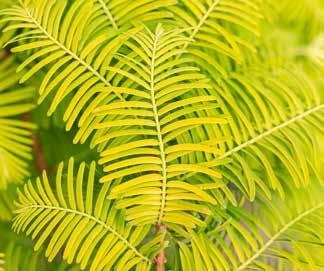
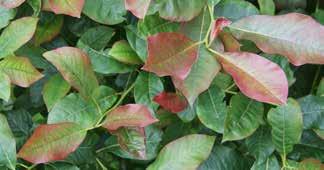
Nyssa sylvatica ‘Wildfire’
Tree Shape: Conical
Medium sized, conical tree with narrow oval leaves, dark green in summer, red in spring and turning brilliant shades of orange, red and purple in the autumn Dark purple-black fruits are sometimes produced
Parrotia persica
Tree Shape: Bushy
Wide spreading tree with attractive, grey, flaking bark. Large, deep green, oval leaves turn crimson/gold in autumn Small delicate crimson flowers in late winter/early spring, followed by spiky brown fruits
Parrotia persica ‘Bella’
Tree Shape: Bushy
Oval, serrated, leaves are deep purple when young, maturing to rich green, then dark red and violet-red in autumn Mature bark begins to peel and flake adding winter interest after leaf fall (Netherlands, 2004)
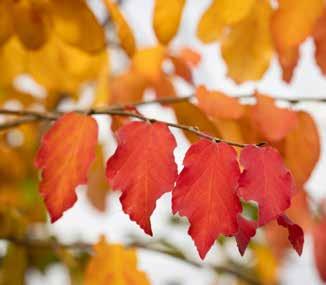
Parrotia persica ‘Cherry Tips'
Tree Shape: Bushy
A beautiful upright Persian Ironwood which has beautiful cherry red autumn foliage Small red flowers in spring and flaking bark as it matures Low maintanence and will thrive in well drained soil in full sun to partial shade
Parrotia persica ‘Persian Spire’
Tree Shape: Upright
A narrow upright shape, perfect for smaller spaces Stunning leaves are purple in spring, green with purple edges in summer, and shades of yellow, orange and red in autumn Small red flowers in winter
Paulownia tomentosa
Tree Shape: Bushy
A rounded tree producing fragrant, light lilac-purple flowers in large panicles in spring The large leaves emerge coated in fine hairs, starting light green, turning mid green and then golden brown in autumn Flowers more profusely in the south (China/ Japan)
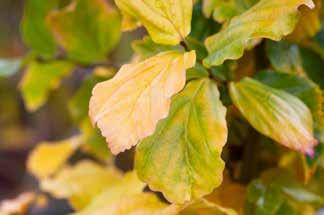
Parrotia persica ‘Vanessa’
Tree Shape: Upright
A small, upright tree with attractive, flaking bark and small red flowers on bare stems in late winter and early spring. Young foliage is red and bronze, turning green in summer, then red, orange and purple in autumn

Photinia x fraseri ‘Red Robin’
Tree Shape: Bushy
A dense medium-sized evergreen shrub of erect habit, with glossy, elliptic leaves The new red, foliage and crimson stems contrast with the mature green foliage Ideal for standards, topiary, hedges and trees (New Zealand)

Physocarpus opulifolius ‘Diablo'
Tree Shape: Bushy
A stylish shrub or small tree with wonderful exfoliating bark once mature. Rich purple foliage, and pretty pink flushed white flowers on arching branches in early summer, followed by glossy red seed heads in autumn
Physocarpus opulifolius ‘Lady in Red' (‘Tuilad') PBR
Tree Shape: Bushy
A medium sized deciduous shrub with large, attractive, lobed, ruby red leaves toning to a brown-bronze as the season progresses Produces clusters of pink-white flowers in summer, followed by red autumn berries (2000)
Picea pungens ‘Erich Frahm’
Tree Shape: Conical
One of the best blue spruce Forms a regular pyramidal shape with deep blue leaves throughout the year Cylindrical, female cones are borne during the year, green at first, later fading to a pale brown (Germany)
Pinus flexilis ‘Vanderwolf’s Pyramid’
Tree Shape: Conical
(Arolla Pine) An upright, slow growing, attractive, pyramidal tree with closely spaced, twisted, silvery blue green needles, reaching 6m x 2.5m when mature. (New Jersey, USA, 1972)
Pinus radiata ‘Aurea’
Tree Shape: Conical
Conical shape when young, eventually forming a large, broad topped tree, with striking golden yellow foliage especially in the winter Brown cones are produced in clusters on mature trees (New Zealand, 1910)
Pinus sylvestris
Tree Shape: Conical
(Scots Pine) A large evergreen tree and one of only three native conifers The orange scaly bark develops fissures and plates with age Twisted grey green needle like foliage and mature grey brown cones
Pinus wallichiana
Tree Shape: Conical
(Bhutan Pine) An elegant large tree with graceful blue-green foliage forming a broad head with age The trunk is smooth and dark grey at first, later flaking off in plates. Small cones are produced in November (1823)
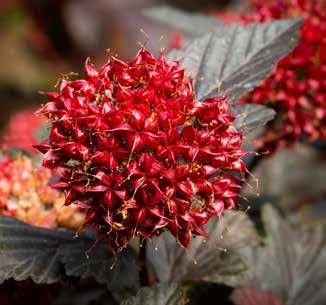

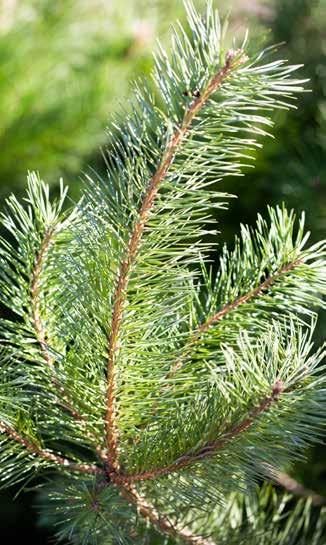
Prunus ‘Accolade’
Tree Shape: Spreading
A graceful tree of spreading habit bearing masses of pendulous, semi-double, light pink flowers in April The mid green leaves turn orange-red in autumn, an outstanding tree for all gardens (UK, 1952)
Prunus ‘Amanogawa’
Tree Shape: Upright
(The Flagpole Cherry) A distinctive columnar tree with erect branches The oval leaves are green-bronze when young, later dark green, then red-gold in autumn Fragrant, semi-double, light pink flowers in late April
Prunus ‘Asano’
Tree Shape: Conical
4
Graceful, upright, columnar tree with small abundant deep pink blossoms, packed with up to 100 petals in mid to late spring Leaves are bronze when they emerge, maturing to dark green in summer (1929)
Prunus avium ‘Plena’
Tree Shape: Standard
(Syn: ‘Multiplex/double ‘Gean’) An upright, spreading tree with big, double white flowers drooping in clusters in April-May Leaves are bronze when young, turning dark green then yellow and crimson in autumn (18th Century)
Prunus ‘Blushing Bride’
Tree Shape: Bushy
(Syn: P. ‘Shogetsu/Longipes’) A graceful tree with a spreading habit producing large semi double flowers, pink tinted in bud opening to pure white The mid-green summer foliage turns orange to red in the autumn 5
Prunus ‘Candy Floss’
Tree Shape: Bushy
(Syn: P. ‘Matsumae-beni murasaki’) The very large, double, deep pink flowers in May have fringed petals which age to the texture of crushed velvet Coppery bronze young leaves make a lovely contrast to the flowers
Prunus cerasifera ‘Nigra’
Tree Shape: Standard
A neat round-headed tree producing myriads of small pale pink flowers in late February and early March The leaves are small and very dark purple, turning a brighter red in the autumn before falling (1916)
Prunus ‘Collingwood Ingram’
Tree Shape: Standard
A dainty, upright, erect tree with an elegant habit and bronzetinted young leaves, green in summer, red orange and yellow in autumn before falling. Produces pretty, deep pink single flowers in mid-spring (1979)
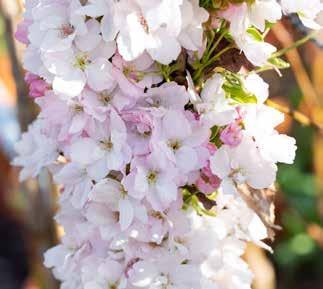
Prunus avium
Tree Shape: Standard (Wild Cherry, ‘Gean’ or ‘Mazzard’) A medium-large tree with smooth, grey bark, turning mahogany-red, peeling and deeply fissured with age Single white, cup shaped flowers in late April and good autumn colour (Europe/ Asia)
Prunus ‘Beni-yutaka’
Tree Shape: Standard
An umbrella-shaped, tree producing semi-double, disc-shaped flowers in a sugar pink colour with a distinctive dark central eye in mid-late April The green foliage turns rich red-crimson in autumn
Prunus x blireana
4
Tree Shape: Upright (Yoshino Cherry/Somei-yoshino) Graceful tree with upright, spreading branches bearing single, almond scented, blush white flowers in late March, followed by small fruits Green foliage turns yellow in autumn (Japan)
Prunus cerasifera ‘Crimson Pointe’®
Tree Shape: Upright
A neat slim line version of Prunus cerasifera ‘Nigra’. A narrow columnar tree, making it ideal for smaller gardens The vibrant purple leaves contrast beautifully with the white flowers in early spring. (USA, 1980s)
Prunus ‘Chocolate Ice’
Tree Shape: Bushy
(Syn: ‘Matsumae-fuki') Stunning tree with an upright habit when young, spreading as it ages Large, flowers open blush white against the fresh, red tinted, chocolate brown foliage Leaves turn dark green as summer progresses
Prunus ‘Crystal Falls'®
Tree Shape: Weeping
An outstanding, hardy, winter flowering cherry with unique densely double, dainty, pure white flowers and a very neat weeping habit Flowering can be up to 2 months from midDecember through to February. (UK, 2024)
Prunus ‘Daikoku’
Tree Shape: Standard
4
A small tree with strong ascending branches Large, double, lilac-pink flowers with small green carpels Pale yellowish-green leaves with a bronze flush, mature to dark green then orange and red tints in autumn (1899)
Prunus ‘Frilly Frock’™
Tree Shape: Weeping
A magical little weeping tree with outstanding features. Profuse early spring flowering, attractive sharp variegation to the summer leaves and striking multi-toned autumn tints Ideal for small gardens (Worcestershire, 2011)
Prunus ‘Gyoiko’
Tree Shape: Bushy
A strong growing tree with ascending branches Creamy white semi double flowers with green and pink shades emerging in late April
Young leaves are reddish brown, turning deep green then orange and scarlet in autumn (1914)
Prunus ‘Hokusai’
Tree Shape: Bushy
A vigorous, wide spreading tree with young bronze foliage, maturing to bright green, flame orange-red in autumn The branches are hidden in spring by the large clusters of semidouble, pale pink, very fragrant flowers 4
Prunus ‘Ichiyo’ Pink Champagne
Tree Shape: Spreading
4
(Syn: ‘Pink Champagne') A vigorous, upright spreading tree with ascending branches and double shell pink flowers with a frilled appearance on long flower stalks Light bronze green young foliage turns orange-red in autumn
Prunus incisa ‘Mikinori’
Tree Shape: Bushy
3
A small tree or large shrub which displays a beautiful show of delicate pink buds opening to pure white flowers in March Finely toothed leaves develop from mid-green to orange and red in the autumn
Prunus incisa ‘Pendula’
Tree Shape: Weeping
4
(Weeping Fuji Cherry) A very graceful, small weeping tree The delicate, single, white flowers densely festoon the branches Midgreen foliage in summer and a vivid display of autumn foliage colour
Prunus ‘Fragrant Cloud’
Tree Shape: Spreading
(Syn: ‘Shizuka’) A vigorous grower with a spreading, slightly ascending habit White, semi-double, fragrant flowers in May turning pinkish as they age Foliage develops from bronze, turning mid-green, then orange in autumn (1960s)
Prunus ‘Fugenzo’
Tree Shape: Spreading
(Syn: Shirofugen) A majestic wide spreading tree producing large, double, white, fragrant flowers and contrasting copper coloured leaves The flowers fade to a subtle shade of pink The latest of all the cherries to flower
Prunus ‘Hally Jolivette’
Tree Shape: Standard
A small graceful tree Its light branch structure is covered with unique semi-double blush white flowers in early spring Dark green pointed foliage emerges coppery-bronze in spring, then orange and red in the autumn. (USA)
Prunus ‘Horinji’
Tree Shape: Bushy
A small tree with stiffly ascending branches bearing long, narrow, green leaves turning yellow in autumn Flowers are semi-double, mauve-pink in bud opening soft pink, contrasting with the purplish-brown calyces (1935) 4
Prunus incisa ‘Kojo-no-mai’
Tree Shape: Contorted
4
A small, slow growing shrub with attractive ‘zig-zag’ shoots and pendulous, blush white flowers in April The serrated foliage has bronze tints when young, turning vivid orange in the autumn An ideal patio plant
Prunus incisa ‘Oshidori’ Princesse
Tree Shape: Bushy
3
One of the best dwarf Fuji cherries displaying profuse double blushwhite flowers with a delicate pink centre in March The leaves are narrow with serrated edges that display rich autumn colours
Prunus incisa ‘Praecox’
Tree Shape: Bushy
2
A small tree or large shrub A fine winter flowering form with white flowers which are pale pink in bud The green, strongly toothed, ovate leaves turn red and orange in autumn. (Winchester, UK)
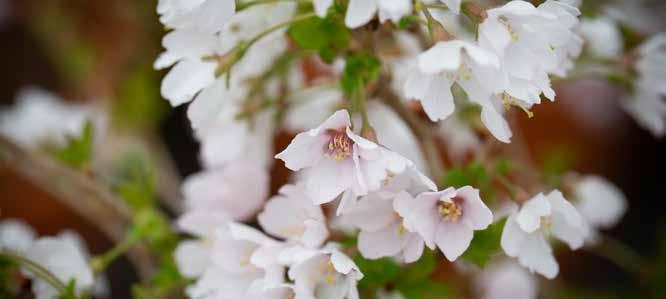
Prunus incisa ‘Yamadei’
Tree Shape: Spreading
Small, umbrella shaped tree with single white, bell-shaped flowers opening from green buds Green leaves are deeply serrated turning orange-yellow in autumn Small, deep red fruits sometimes appear (Japan, 1916) 4
Prunus ‘Kanzan’
Tree Shape: Bushy
A showy variety, with densely double, glowing purple/pink flowers in late April The spring foliage is coppery red turning green and then orange in autumn A strong growing tree, with an upright, spreading habit (1913)
Prunus ‘Kofugen' (Fugenzo)
Tree Shape: Standard
Similar to Prunus Kanzan but smaller with a broader, flatter head. Large drooping double pink flowers Leaves are coppery when young (1880)
Prunus litigiosa
Tree Shape: Upright
(The Tassel Cherry) A most unusual upright tree producing clusters of small white or pink tinged flowers in April Flowers have conspicuous protruding anthers, hence the reference to tassels (China)
Prunus ‘Mikurama-gaeshi’
Tree Shape: Standard
4
A small tree with long ascending, short spurred branches densely packed with single blush pink flowers. Young leaves are bronze green, deep green in the summer, then reddish copper with yellow markings in the autumn. (UK)
Prunus ‘Okame’
Tree Shape: Bushy
A round-headed small tree with ovate leaves turning orange and red in autumn Small, deep shell pink flowers in mid-March, often followed by small dark cherries - not palatable for humans, but useful for birds. (UK, 1947) 3
Prunus pendula ‘Ascendens Rosea’
Tree Shape: Upright
A lovely slender, semi erect, vase shaped tree Small, shell pink, single flowers open in mid-spring from red buds, before the leaves emerge A long lived ornamental Cherry
Prunus pendula ‘Stellata'
Tree Shape: Bushy
Prunus ‘Jacqueline’
Tree Shape: Standard
An elegant small tree that produces abundant, large, vibrant, soft pink, single flowers The leaves are dark green in summer with vivid red or orange autumn colours before falling (Belgium)
Prunus ‘Kiku-shidare-zakura’
Tree Shape: Weeping
A very popular small weeping tree with arching branches bearing densely clustered, double pink flowers in spring Lance-shaped leaves are pale green and slightly bronzed at first (19th Century)
Prunus ‘Kursar’
Tree Shape: Standard
A beautiful small tree of spreading habit Masses of deep pink single flowers in early March, very popular with bees The ovate leaves are coppery when young, followed by rich autumn colours of red and gold. (UK)
Prunus ‘Little Pink Perfection’
Tree Shape: Bushy
5
A bushy, very small tree producing deep pink-red buds in late spring, opening to double pink blooms hanging in large clusters Leaves turn a polished mid-green, before developing shades of red and orange in the autumn (Bristol, 1990s)
Prunus mume ‘Beni-chidori’
Tree Shape: Bushy
(Japanese Apricot) A small tree producing deep pink, highlyscented flowers in February fading to paler pink with age, occasionally followed by edible but bitter, yellow fruits. Midgreen, glossy foliage boasts apricot-orange tints in autumn 2
Prunus ‘Pandora’
Tree Shape: Standard
A good, small, all season tree for any garden Compact in habit with ascending branches clothed in pale, shell pink flowers in late March Bronze-red leaves in the spring with tints of purple-red in the autumn. (UK, 1939) 3
Prunus pendula ‘Pendula Rubra’
Tree Shape: Weeping
4
A beautiful, little tree with clear pink, star shaped flowers produced in crowded clusters on graceful branches The leaves are midgreen in colour with yellow and orange autumn tints (1955)
Prunus ‘Pink Parasol’
Tree Shape: Spreading
4
(Syn: P. ‘Matsumae-hanagasa’) Heavy clusters of large pale pink flowers with densely packed petals Leaves are initially dark copper bronze, becoming green over the summer, then yellow in autumn
3
A small, deciduous tree with a weeping habit Mid-green ovate foliage turns fiery shades of orange and red in the autumn before falling The single flowers are a deep, rose pink emerging from darker pink buds
Prunus x persicoides ‘Spring Glow'
Tree Shape: Spreading
3
An upright, deciduous tree with lance-shaped, tapered, persistent bronze leaves Long lasting saucer-shaped, pink flowers appear on bare, dark purple branches in spring (Australia, 20th Century)
Prunus ‘Pink Perfection’
Tree Shape: Standard
5
A small vase shaped tree with oval leaves, bronze when young, turning orange-red in autumn Exotic, long lasting, double, rose pink flowers persist for several weeks from early May. (UK, 1935)
Prunus ‘Royal Burgundy’
Tree Shape: Standard
4
A vase shaped garden tree, impressive for its contrasting rich burgundy leaves and deep rose pink double flowers The leaves also turn a spectacular scarlet red in autumn. (USA)
Prunus ‘Royal Flame’® (Mieke)
Tree Shape: Conical
4
An upright tree with a pyramidal, uniformly branched crown, completely covered in small, fragrant, pure white flowers in spring Foliage emerges bronze, green in summer, then fiery orange, reds and yellows in autumn
Prunus ‘Rosy Veil’
Tree Shape: Spreading
A beautiful, graceful, small tree with a light spreading canopy Light pink, shell shaped flowers with attractive ruby calyxes appear in late to mid March (Belgium)
Prunus rufa
Tree Shape: Bushy
(The Himalayan Cherry) A small, round-headed tree with peeling red-brown, amber bark, and rusty hairy young shoots Clusters of pale pink flowers with the green leaves in late spring, followed by dark red, oval fruit 4
Prunus sargentii
Tree Shape: Spreading
3
(Sargent Cherry) A round-headed, broad spreading habit, with bronze oval leaves when young, brilliant red and maroon in the autumn Contrasting with the young foliage, large, single pink flowers appear in late March
Prunus ‘Shirotae’
Tree Shape: Spreading
4
(Syn: Mount Fuji) A classic Japanese cherry, with horizontal to slightly pendulous branches Very large single or semi-double, fragrant, white flowers contrast with the dark almost black bark (Japan)
Prunus ‘Snow Goose’
Tree Shape: Upright
A narrow, upright small tree of considerable merit Lovely, large, soft, single, white flowers with long tassel stamens in early April In autumn, the green leaves turn rich shades of marmalade and crimson amber
Prunus ‘Spire’
Tree Shape: Upright
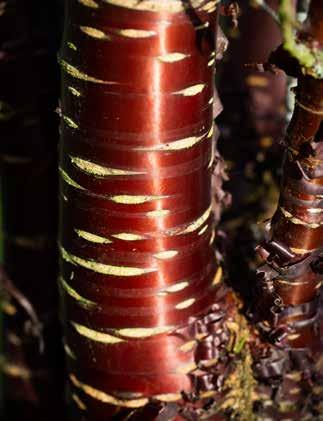
Prunus serrula
Tree Shape: Standard
4
(Tibetan Cherry) Small, vigorous and upright in its early years, spreading with age, with glistening mahogany peeling bark
Narrow, willow like green leaves, turn yellow in autumn Small, dainty white flowers in April (W China)
Prunus ‘Shosar’
Tree Shape: Upright
3
A strong growing, upright, fastigiate tree with bright green leaves turning red and orange in autumn Clear pink, single flowers with a dark eye, bloom in mid-spring. Bred by Collingwood ‘Cherry’ Ingram.
Prunus ‘Snow Showers’
Tree Shape: Weeping
4
(Syn: Prunus ‘Hillings Weeping’) A small, neat, steeply weeping tree with mid-green foliage, turning shades of orange, yellow and red in autumn Dense single white flowers cover the branches in late March
Prunus ‘Spring Snow’
4 4
5
A small deciduous tree with a compact, upright habit. Young bronze leaves, later green, then autumn colours of red and gold Single, light pink flowers open from dark pink buds from early April. (UK, 1920s)
Prunus ‘Starlight’®
Tree Shape: Bushy
RHS Plant of the Year 2024. Recognised for its exceptional beauty, unusual pure white, star shaped flowers and profuse flowering habit in late March and often to the end of April Occasionally winter flowering following mild weather The tree has a graceful upright spreading habit. (UK 2023) 3/4

Tree Shape: Spreading
(Syn: P Beni-tamanishiki) A compact, deciduous tree, with ovate to elliptic leaves opening bronze tinted green, turning orange and red in autumn Clusters of blush white, double flowers in early spring (Japan, 1963)

Prunus x subhirtella ‘Autumnalis Rosea’
Tree Shape: Bushy
11
(Pink Autumn Cherry) Semi-double blush flowers appear late autumn, flowering for most of winter Ovate leaves turn yellow and orange in autumn One of the best winter flowering trees
Prunus Sumaura Fugenzo Japanese Lantern™
Tree Shape: Spreading
A very impressive Japanese flowering cherry Stunning, densely double frilled flowers with white, pink and green petals that darken as they age A medium size, spreading tree Bronze young leaves turn green with age, good autumn colour
Absolutely stunning in flower!
Prunus ‘Tai-haku’
Tree Shape: Spreading
(Great White Cherry) A medium tree with a broad spreading crown, mid-green leaves in summer, then yellow and orange in autumn Large, single, ice white flowers contrast well with the young copper foliage (1932)
Prunus ‘The Bride’
Tree Shape: Bushy
4
A large shrub or small tree displaying very large single white flowers with distinctive, red anthers New foliage emerges bronzegreen, turns fresh green in summer, then orange, red and purple in autumn (Belgium)
Prunus ‘Tiltstone Wildfire’
Tree Shape: Upright
An upright, columnar growth habit This ornamental cherry is absolutely covered in light pink blossoms in early spring Ideal for narrow spaces, it remains slender, making it perfect for urban gardens or as a striking vertical element in any landscape One of the first to flower in spring.
Prunus ‘Ukon’
Tree Shape: Standard
A vigorous, rounded medium size tree with a rather spreading crown, bronze young foliage, green in summer, then red-brown autumn colour Very unusual semi-double, pale yellow or sulphur flowers in spring (1905)
Prunus ‘Weeping Yoshino’
Tree Shape: Weeping
(Syn: P. x yedoensis ‘Shidare Yoshino’) A small tree with steeply pendent branches weeping to the ground Covered with dense clouds of single white flowers in early spring before the dark green leaves emerge (1916)
Prunus x yedoensis
Tree Shape: Spreading
(Yoshino Cherry/Somei-yoshino) Graceful tree with upright, spreading branches bearing single, almond scented, blush white flowers in late March, followed by small fruits Green foliage turns yellow in autumn (Japan)
Prunus ‘Sunset Boulevard’
Tree Shape: Standard
A narrow, conical tree with coppery young foliage becoming green, then yellow-orange in autumn The single flowers are blush white, containing a distinctive pink centre, opening in midspring (Belgium, 1980s) 5

Prunus ‘Taoyame’
Tree Shape: Spreading
4
A beautiful, floriferous, small tree with an elegant spreading habit ideal for small gardens Semi-double, honey scented, shell pink flowers have contrasting purple calyces, opening from pink buds in mid-spring
Prunus ‘Tiltstone Rocketfire’
Tree Shape: Upright
A stunning ornamental cherry tree, distinguished by its upright, columnar growth habit and vibrant pink blossoms in early spring Ideal for narrow spaces, it remains slender, making it perfect for urban gardens or as a striking vertical element in any landscape
Prunus ‘Trailblazer’
Tree Shape: Standard
A compact, rounded to spreading, tree with purple-bronze leaves Pink buds open to white flowers in spring usually followed by large, purple skinned cherry plums Leave fruit to ripen well on the tree before eating. (USA)

Pyrus communis
Tree Shape: Standard
An attractive columnar occasionally thorny tree. Plentiful, white blossom emerges in spring, followed by small, edible fruit which are popular with wildlife The oval, glossy green leaves turn gold and orange in autumn before falling
Pyrus calleryana ‘Chanticleer’
Tree Shape: Upright
A classic street tree with narrow pyramidal habit White flowers and glossy leaves turning purple and claret in autumn The leaves stay on late and the flower is early so a good value tree for all seasons. (Ohio, USA, 1950s) 4
Tree Shape: Standard
An upright to spreading tree with long, cupped, felted, silverygreen leaves White flowers with red anthers in March, followed by small, glossy, yellow-green, fruit in autumn (Europe)
Pyrus salicifolia ‘Pendula’
Tree Shape: Weeping
(Weeping Willow Leaved Pear) Elegant, small tree of weeping habit Silver willow-like leaves turn bronzed green in autumn
Small creamy-white flowers in April, followed by small brown/ green ornamental fruits
Pterostyrax psilophyllus
Tree Shape: Bushy
Small epaulette tree. A rare tree with bristle toothed, downy long leaves which have good autumn colour White, scented flowers in panicles up to 15cm long in late spring/early summer and followed by bristly, ribbed fruits to 2 5cm long
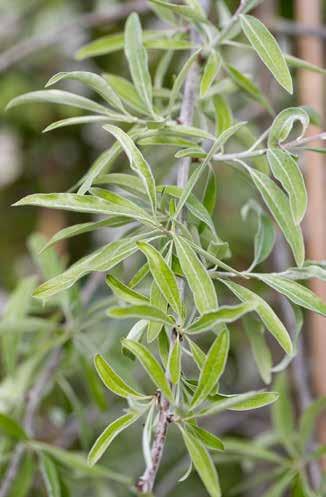


Quercus ilex
Tree Shape: Standard
(Evergreen/Holm Oak) A versatile evergreen eventually becoming dome-shaped Dark grey bark and narrow oval leaves, dark green above, silver grey and hairy underneath. Yellow catkins in June followed by acorns
Quercus palustris
Tree Shape: Standard
(Pin Oak) A fast growing, large, dense-headed tree with slender drooping branches The smooth bark is grey-brown, and the green deeply lobed leaves turn reddish-brown or rich scarlet in autumn
Quercus palustris ‘Green Pillar' (‘Pringreen')
Tree Shape: Upright
A deciduous, narrowly columnar tree, with dense, upright branches Deeply lobed, glossy green leaves in summer, turn deep red to bronze in autumn The slim shapes makes this ideal for smaller gardens. (USA, 1990s)
Quercus rubra
Tree Shape: Standard
(Red Oak) A fast-growing large deciduous tree with an open, spreading crown and smooth silver-grey bark The large, deep green leaves turn orange and stunning crimson-brown before dropping in the winter. (USA)
Quercus texana ‘New Madrid’
Tree Shape: Standard
New leaves emerge deep burgundy-red in spring, turning dark green, then red and orange in autumn Small male and female catkins appear in March, followed by acorns in late summer to early autumn. (USA)
Robinia x margaretta ‘Pink Cascade’
Tree Shape: Bushy
(Syn: R. x margaretta ‘Casque Rouge’) A very profuse, rich pink flowering form of the false acacia tree The fragrant flowers hang in racemes in June Dark green pinnate leaves turn yellow in autumn. (USA)
Robinia pseudoacacia ‘Frisia’
Tree Shape: Bushy
Renowned for its bright golden pinnate leaves throughout summer. Young twigs are bright brown with wine-red thorns, later turning brown Pendent clusters of small fragrant pea-like white flowers in mid-summer (Netherlands, 1935)
Robinia pseudoacacia ‘Lace Lady’®
Twisty Babe
Tree Shape: Contorted
A dwarf Robinia ideal for patio pots. Attractive twisted branches hold the delicately curled leaves. Young foliage emerges limegreen becoming darker with age, then yellow in autumn
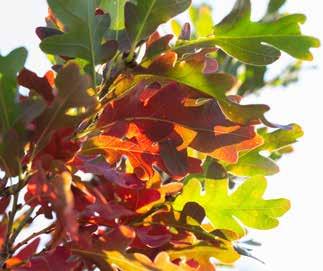
Quercus robur
Tree Shape: Standard
(English/Pedunculate Oak) Long lived, broad, dome-headed tree The lobed leaves are dark green above, paler underneath, turning orange or rusty brown in autumn Acorns are produced in abundance
Quercus rubra ‘Boltes Gold’
Tree Shape: Standard
A rare red oak, with a branching rounded crown Golden-yellow leaves in spring, darkening to lime green and turning shades of red and orange in autumn
Quercus x warei ‘Regal Prince’
Tree Shape: Upright
(Syn: ‘Long’) A strong and fast growing narrow headed hybrid with glossy green foliage, turning amber-yellow in autumn The mature grey-green bark forms small rectangular grooves Very hardy and impressive
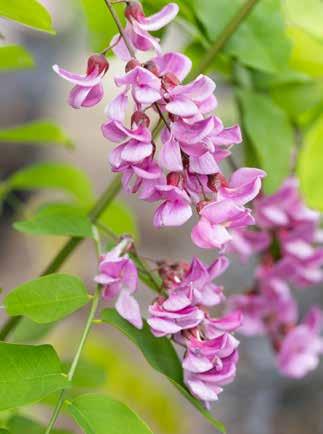
Salix alba ‘Golden Ness’
Tree Shape: Bushy
A deciduous tree, often grown as a shrub, with rich bronze-red stem colour making this form particularly rewarding during winter months Narrow mid-green leaves are joined by fairly small catkins in late spring
Salix alba ‘Hutchinsons Yellow’
Tree Shape: Bushy
A selected clone with bright ‘egg yolk’ yellow stems, making this perfect for winter interest in any garden Prune back hard each April to encourage the best stem colour
Salix alba ‘Tristis’
Tree Shape: Weeping
(Salix x sepulcratis var chrysocoma/Golden Weeping Willow) Fast growing with weeping, golden yellow shoots Small yellow catkins appear in the spring with the narrow, lance shaped leaves
Salix alba vitellina ‘Britzensis’
Tree Shape: Bushy
(Syn: Salix alba ‘Chermesina’/Scarlet Willow) A vigorous, medium-sized, deciduous tree of compact habit with scarletorange winter stems Small, yellow catkins in spring alongside new mid-green, narrow foliage
Salix caprea ‘Pendula’
Tree Shape: Weeping
(Kilmarnock Weeping Willow) A small, steeply weeping, umbrella-like tree with heavily pendulous branches Large grey catkins with yellow anthers open before the mid-green ovate leaves in spring (Scotland, 1850s)
Sambucus nigra porphyrophylla
‘Black Beauty’® (Gerda)
Tree Shape: Bushy
5
An upright, deciduous shrub or small tree with dark burgundy, pinnate leaves Sweet, lemon scented blooms carried in dense panicles in early summer, followed by glossy black elderberries. (Kent, UK)
Sambucus nigra porphyrophylla
‘Black Lace’® (Eva)
Tree Shape: Bushy
A hardy, deciduous shrub with finely cut, dark burgundy, almost black leaves turning red in autumn. Pretty clusters of tiny pink, scented flowers form at the start of summer, followed by very deep red elderberries. (Kent, UK)
Sambucus nigra porphyrophylla
‘Black Tower’® (Eiffel)
Tree Shape: Upright
An upright, columnar shrub or small tree Toothed foliage opens green, turning dark purple in a sunny position Scented, pale pink flowers with large red anthers in late spring, followed by purple-black berries

Tree Shape: Bushy
A deciduous tree, often grown as a shrub, with rich bronze-red stem colour making this form particularly rewarding during winter months Narrow mid-green leaves are joined by fairly small catkins in late spring
Salix integra ‘Hakuro-nishiki’
Tree Shape: Bushy
Dwarf, weeping Japanese Willow with narrow, lance shaped, creamy-pink and green, variegated foliage. Yellow catkins are borne in spring and the stems turn orange-red in autumn (Japan, 1979)

Sequoiadendron giganteum ‘Glaucum’
Tree Shape: Conical
A large, evergreen conifer with a narrow pyramidal form, becoming rounder with age Blue green to silver blue leaves and small male and female flowers on the same tree, later followed by reddish-brown ovoid cones
Sophora japonica ‘Gold Standard’
Tree Shape: Bushy
Golden yellow stems contrast against the dark green main stem giving winter interest Foliage emerges rich butter yellow before tuning yellow-green Creamy-white pea like flowers on mature trees
Sorbaronia ‘Likjormaja’ Liquorice
Tree Shape: Standard
A hybrid between Sorbus aucuparia and Aronia Forms a small slender tree with lobed leaves turning wonderful autumn colours Pinkish white flowers emerge in spring followed by red berries in autumn
Sorbus alnifolia ‘Red Bird’
Tree Shape: Standard
An upright, columnar, deciduous tree with a full crown of attractive, green oval leaves which turn a rich scarlet in autumn Dense clusters of white flowers in May are followed by small, red berries
Sorbus ‘Amber Light’
Tree Shape: Standard
An upright to spreading, deciduous tree with bluish green leaves turning orange and red in autumn Clusters of white flowers in mid-late spring followed by orange/golden fruit, keeping their colour deep into winter
Sorbus aria ‘Lutescens’
Tree Shape: Spreading
(Whitebeam) Young silvery leaves appear as candles turning grey-green in summer, then russet and gold in autumn Clusters of creamy white flowers in spring, followed by bright orange-red fruit in autumn

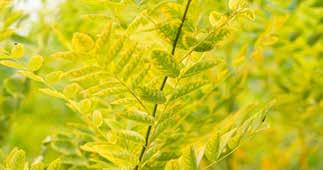


Sorbus arranensis
Tree Shape: Standard
A very rare, large shrub or small upright tree Ovate leaves are deeply lobed, green above, grey and downy beneath White, delicate flowers in spring followed by round-long berries in the autumn (Arran, Scotland)
Sorbus aucuparia ‘Aspleniifolia’
Tree Shape: Standard
5
A medium sized tree forming a broadly pyramidal shaped crown
Attractive feathered foliage is mid-green, turning orange and red in autumn Creamy white flowers in spring, followed by clusters of red berries
Sorbus aucuparia ‘Cardinal Royal'
Tree Shape: Standard
5
(‘Michred') A robust, healthy, upright tree Summer foliage is midgreen, with a slight silver underside turning yellow and orange in autumn Clusters of white flowers in spring give rise to bunches of small red berries. (USA)
Sorbus aucuparia ‘Fingerprint’®
Tree Shape: Upright
5
A highly compact, narrow tree with finely toothed leaves that turn shades of orange and yellow in autumn Clusters of white flowers in spring followed by spherical, orange-red fruit Disease resistant (Belgium, 1990s)
Sorbus carmesina ‘Emberglow’
Tree Shape: Bushy
5
The fruits of this distinctive tree remain red, deep into the winter instead of turning whitish as in most forms of this species Handsome bluish-green leaves turn shades of red, orange and bronze in autumn. (Liverpool, UK)
Sorbus ‘Chinese Lace’
Tree Shape: Standard
5
A very healthy, round-headed small tree with unusual deeply cut foliage The lace like dark green leaves turn stunning shade of red and purple in autumn Dark red fruits are abundant in large bunches
Sorbus ‘Eastern Promise’
Tree Shape: Standard
5
A small, upright, oval-headed, spreading tree with pinnate leaves that turn purple and orange-red in autumn White flowers in spring, followed by dense clusters of deep rose-pink berries in autumn. (Hampshire, UK, 1967)
Sorbus ‘Glendoick Spire’™
Tree Shape: Upright
5
A lovely upright tree with fern-like, dark green leaves, turning orange and red in autumn Produces creamy white flowers in spring followed by bright pink berries that are great for the birds
Sorbus ‘Glendoick White Baby’™
Tree Shape: Bushy
5
Forms a bushy, small, deciduous tree with fine narrow pinnate leaves, turning rich burgundy in autumn Heads of creamy white flowers in spring, followed by persistent large white almost translucent berries (Scotland)
Sorbus aucuparia
Tree Shape: Standard
(Mountain Ash) Lance-shaped leaves, dark green above, bluegreen beneath turning yellow through to orange in autumn Flat clusters of white flowers in late spring, followed by large bunches of bright red fruit
Sorbus aucuparia ‘Beissneri’
Tree Shape: Upright
5
Compact, upright, deciduous tree with reddish brown bark Orange-copper stems bear green, fern like leaves turning yellow in autumn Frothy, creamy white flowers are followed by heavy clusters of red berries
Sorbus aucuparia ‘Croft Coral’
Tree Shape: Bushy
5
Rounded, neat tree with delicate, dark green leaves, turning yellow in autumn Clusters of flowers in late spring followed by coral-orange fruits arriving at the end of summer A good choice where space is limited
Sorbus Autumn Spire® (‘Flanrock’)
Tree Shape: Upright
5
A small, deciduous tree, upright when young, columnar in maturity Pinnate, bright green leaves turn purple, red and yellow in autumn. Yellow berries with reddish centres contrast well with the autumn leaves
Sorbus cashmiriana
Tree Shape: Bushy
4
An excellent small tree of open and spreading habit Leaves are dark green above, grey green beneath, turning orange and yellow in autumn Pink tinted, creamy white flowers in spring, followed by large white berries. (Kashmir)
Sorbus commixta ‘Ravensbill’
Tree Shape: Bushy
4
Fern-like leaves turn yellow-orange in autumn Clusters of white flowers in spring followed by vivid orange berries in autumn
The most distinguishing feature are the long curved, blue-black winter buds. (Korea)
Sorbus folgneri ‘Emiel’
Tree Shape: Spreading
4
An attractive spreading tree, with narrow light green leaves, white beneath, turning amber, orange and red in autumn Clouds of small white flowers turn into dense clusters of tiny orange to red berries (Belgium, 2000s)
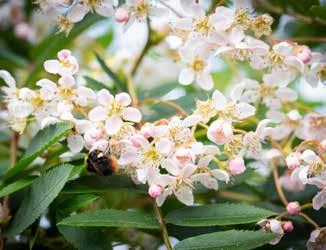


Sorbus hupehensis ‘Pink Pagoda’
Tree Shape: Spreading
An outstanding form with blue-green, large, pinnate compound leaves, red twigs and petioles, and white flower clusters in spring The persistent fruit is vivid pink slowly turning white by mid-winter
Sorbus ‘Joseph Rock’
Tree Shape: Standard
An outstanding tree with an upright compact shape renowned for its clusters of persistent, round, creamy yellow fruit, becoming orange-yellow as they ripen Leaves turn red, orange and purple in the autumn (China, 1932) 4
Sorbus ‘Leonard Messel’
Tree Shape: Bushy
5
A small, oval-shaped tree with upright branches Red winter buds and large leaves turn orange, gold and purple in autumn Clusters of pink hanging fruit follow the white flowers in late spring and early summer (1949)
Sorbus ‘Pink Pearl’
Tree Shape: Standard
A small upright growing tree with pinnate, sharply toothed leaves that turn purple/bronze in the autumn Clusters of heavily flushed and pink flecked white fruits in late summer-autumn. (UK, 1958) 5
Sorbus ‘Pink-Ness’
Tree Shape: Standard
A broadly conical, deciduous tree with pinnate matt green leaves, turning orange and red in autumn Clusters of white flowers in late spring are followed by unusual mauve pink fruits. (UK) 5
Sorbus pseudohupehensis
Tree Shape: Spreading
(Hupeh Rowan) A medium deciduous tree forming a compact crown, with blue-green, pinnate leaves turning vivid red and orange in autumn Large clusters of white berries start out pink before turning white (China) 4
Sorbus pseudovilmorinii
Tree Shape: Bushy
A small tree similar to Sorbus vilmorinii The leaves are pinnate and almost fern like, green at first, turning to orange and red in the autumn White blooms in late spring are followed by deep rose-red berries
Sorbus ‘Rose Queen’
Tree Shape: Standard
(S com Embley x S monbeigii) Small, upright tree with dark green, pinnate serrated leaves, turning orange and purple in autumn Large clusters of bright rose-red berries follow the white spring flowers. (Hilliers, UK, 1963)
Sorbus rosea ‘Rosiness’
Tree Shape: Bushy
4
A small tree of open habit with reddish bark and silvery markings
Dark green, pinnate leaves turn red in autumn Amongst the largest berries of any of the pink berry rowans, changing colour from pale to deeper pink
Sorbus sargentiana
Tree Shape: Standard
5
Large pinnate leaves and sticky winter buds The large red stalked leaves are downy underneath Creamy white flowers in May-June, followed by bunches of orangey red berries, popular with the birds (China)
Sorbus ‘Sunshine’
Tree Shape: Standard
5
A small, erect tree with dark, glossy green leaves turning red and orange in autumn Clusters of white flowers in late May, followed by dense fruitlets, turning from white to golden yellow through autumn. (Hillier, UK, 1968)
Sorbus vilmorinii
Tree Shape: Bushy
A small, spreading tree with dark green fern-like leaves turning orange and purple in autumn Small creamy-white flowers in spring are followed by rose pink berries, which slowly turn to white (W China, 1889) 5
Sorbus vilmorinii ‘Pink Charm’
Tree Shape: Bushy
5
A superior selection of S vilmorinii making a small, tree with arching branches, and feathery, compound, green leaves, gold in autumn Creamy-white flowers in late spring-summer followed by vibrant pink berries
Sorbus ‘Wisley Gold’
Tree Shape: Standard
A strong growing tree with pinnate, toothed, dark green leaves, turning reddish-purple to orange-red in autumn Clusters of white flowers in late spring followed by heavy bunches of golden fruit (UK) 5
Stewartia rostrata
Tree Shape: Upright
An upright to spreading, tree with dark green, oval leaves turning dark red-purple in autumn The flower buds are surrounded by deep maroon bracts followed by lovely white flowers, sometimes tinged with maroon, in late spring
Sorbus splendens
Tree Shape: Standard
The striking, young, red leaves emerge from large sticky leaf buds in the spring, fading to bronze-green, then flame colours in autumn Clusters of white flowers are followed by red berries in the autumn (China, 1995)
Sorbus ulleungensis ‘Olympic Flame’™
Tree Shape: Standard
Young copper green, highly feathered leaves become green in summer, then a fiery mix of bronze, orange and scarlet Creamywhite flowers in late spring develop into clusters of shiny orangered berries 5


Styrax japonicus ‘Fragrant Fountain’
Tree Shape: Weeping
A weeping form producing clusters of scented white flowers with gold stamens from June Glossy dark green leaves turn yellow and red in autumn On older branches the bark splits revealing orange inner bark. (Oregon, USA)
Styrax japonicus ‘Pink Chimes'
Tree Shape: Bushy
A weeping form producing clusters of scented white flowers with gold stamens from June Glossy dark green leaves turn yellow and red in autumn On older branches the bark splits revealing orange inner bark. (Oregon, USA)
Syringa meyeri ‘Palibin'
Tree Shape: Bushy
A bushy, slow-growing deciduous shrub with small, broadlyovate, dark green leaves. Produces a profusion of pretty lilacpink, sweetly fragrant flowers in May and June that emerge from darker pink buds
Syringa ‘Pink Perfume’
Tree Shape: Bushy
A compact, upright shrub with bright green, broadly ovate leaves Panicles of sweetly scented pink flowers are borne from spring to summer and again from summer into autumn Suited to pot growing
Syringa vulgaris ‘Carpe Diem'®
Tree Shape: Bushy
Conical clusters of beautiful, very fragrant, trumpet-shaped, light purple-blue, single flowers bloom in late spring and early summer
Syringa vulgaris ‘Madame Lemoine’
Tree Shape: Bushy
A bushy medium-sized deciduous shrub with light green, heartshaped leaves. Yellow spring buds open to reveal compact trusses of fragrant, double, white flowers in May-June
Syringa vulgaris ‘Primrose’
Tree Shape: Bushy
A bushy deciduous tree with heart-shaped leaves and small panicles of fragrant, single pale primrose yellow blooms The blooms intensify as the plant matures, with richer flowers each year (Netherlands, 1949)
Syringa vulgaris ‘Sensation’
Tree Shape: Bushy
A deciduous shrub with a relatively loose habit, producing large, single, purplish-red florets edged with distinctive white margins to each petal. The fragrant flowers appear in May-June attracting all sorts of wildlife
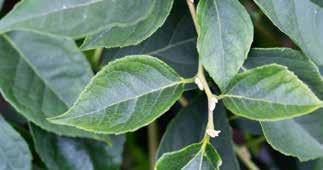
Styrax japonicus ‘Snow Cone’
Tree Shape: Standard
A uniform, symmetrical small tree producing clusters of nodding, bell-shaped, white flowers in summer Fine textured, dark green foliage turns yellow in autumn The new smooth, grey-brown bark matures to orange-brown with fissures
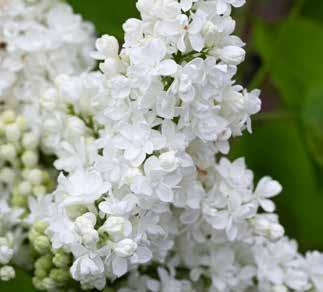
Syringa vulgaris ‘Katherine Havemeyer’
Tree Shape: Bushy
An upright medium-sized deciduous shrub, spreading with age, with mid-green, heart-shaped leaves Large, dense bunches of highly fragrant, double, purple-lavender flowers in May, fade to lilac-pink in mid-summer
Syringa vulgaris ‘Mrs Edward Harding’
Tree Shape: Bushy
A large, deciduous shrub with dark green, heart shaped leaves, perfect for the back of sunny borders Showy, dense panicles of highly fragrant, deep purple red, double flowers which fade to pink in May and June
Syringa vulgaris ‘Prince Wolkonsky’
Tree Shape: Bushy
An upright, bushy, deciduous shrub or small tree with heartshaped, mid-green leaves Dark magenta flower buds open to very fragrant, light pink/purple flowers (France, 1976)
Syringa vulgaris ‘Souvenir de Louis Spaeth’
Tree Shape: Bushy
A spreading medium-sized deciduous shrub with dark green, heart-shaped leaves Narrow panicles of fragrant, single, pure wine red flowers are borne on compact stems A reliable, troublefree variety (Germany, 1883)
Taxodium distichum
Tree Shape: Conical
(Swamp Cypress) A deciduous coniferous tree, with a conical crown, and fibrous red-brown bark The feathery foliage is bright green, needle-like turning bright orange in autumn Produces small, round seed cones, purple when young

Taxus baccata
Tree Shape: Bushy
(Common Yew) A slow growing, medium sized bushy evergreen tree with very small, needle like, dark green leaves Bright red, berry like fruits ripen in the autumn and are attractive to birds during the winter
Taxus baccata ‘Fastigiata Robusta’
Tree Shape: Upright
A coniferous tree that forms a slow growing, dense, broad column with multi-pointed crown Deep green, soft, needle like foliage and red cones in autumn, which are loved by birds (Switzerland, 1940s)
Thuja occidentalis ‘Smaragd’ (Emerald)
Tree Shape: Conical
A superb, columnar evergreen which can be planted as an elegant specimen or to create a hedge The foliage is emerald green with bronze tips and holds its colour all year round The foliage also has a sweet aromatic scent
Tilia cordata
Tree Shape: Standard
7
(Small Leaved Lime) A medium-sized deciduous tree with heart shaped leathery leaves, glossy green above and paler underneath Small, fragrant creamy-white flowers are borne in spreading clusters in summer
Tilia cordata ‘Winter Orange’
Tree Shape: Standard
7
(Orange Lime) Pronounced orange twigs and shoots in winter and red buds. Heart-shaped matt green leaves in summer, turn butter yellow in autumn. Ivory white scented flowers in July. (Netherlands, 1977)


Tilia platyphyllos
Tree Shape: Standard
(Silver Lime) A vigorous tree of rounded habit, with large pale to mid-green heart-shaped leaves with a course texture Creamyyellow flowers in June/July The dark grey bark becomes deeply fissured and marked with age
Ulmus x hollandica ‘Wredei’
Tree Shape: Upright
(Upright Golden Elm) Broad crinkled edged leaves are bright yellow where exposed to the sun and greener in the shaded parts giving a suffused appearance, adopting rich shades of gold in the autumn
Ulmus ‘Lutèce' (Naguen)
Tree Shape: Standard
Medium to large tree with an ascending vase-shaped crown
Broad ovate to broad obovate, serrated, green leaves are late to emerge in May and turn yellow in autumn A well proven Dutch Elm resistant hybrid (Netherlands)
Ulmus minor ‘Ademuz’
Tree Shape: Standard
Narrow leaved or Field Elm Found in Valencia, Spain and found to have a very high resistance to Dutch Elm Resistant cultivars
Ulmus ‘Vada'®
Tree Shape: Upright
A slender, upright tree, very resistant to Dutch elm disease The glossy, dark green foliage is coarsely toothed and heavily veined, turning brown-yellow in autumn
Ulmus x ‘Wingham' (FL493)
Tree Shape: Standard
A large stately tree, vigorous, fast growing with a fairly upright habit and green oval leaves High Dutch Elm Disease resistance and ideal as a host tree for the native rare White-letter Hairstreak butterfly. (IPP Florence)
Viburnum opulus
Tree Shape: Bushy
A vigorous native shrub, producing flat clusters of white flowers in late spring, followed by bright red fruits that are popular with birds The maple-like leaves are dark green in summer then tinted red in autumn before falling
Viburnum opulus ‘Roseum'
Tree Shape: Bushy
A deciduous shrub, great as a hedge or a specimen Clusters of sterile flowers emerge lime green, later turning pure white The soft green foliage is similar in shape to Acers, turning shades of red and purple in the autumn
Viburnum plicatum ‘Kilimanjaro'® (Jww1)
Tree Shape: Standard
An upright, small, conical tree or large shrub with deeply veined leaves turning red-purple in autumn White lacecup like flowers appear on tiered branches Pink-red summer berries turn black in autumn


Viburnum plicatum ‘Tennessee'
Tree Shape: Spreading
A spreading shrub with open to horizontal branches The serrated veined foliage is dark green turning red-purple in autumn Tiny, creamy white flowers in late spring, followed by ovoid, red fruit ripening to black in autumn
Wisteria brachybotrys
‘Kapiteyn Fugi’
Long pendants of large, white, pea-like, highly scented flowers in late spring-early summer, flowering from an early age A relatively compact growing Wisteria with bright green, slightly downy, pinnate foliage 5
Wisteria brachybotrys
‘Okayama’
5
A vigorous, deciduous twining shrub with long, pendulous racemes of beautiful, fragrant, pea-like, dark violet purple flowers The new bronze foliage turns a beautiful rich green in summer
Wisteria brachybotrys
‘Shiro Beni’
(Silky Wisteria) A vigorous climber producing long, pale pink racemes of scented, pea like flowers in early summer as the new grey green leaves are emerging The blooms are followed by bean like velvety pods in autumn 5
Wisteria floribunda
‘Caroline’
5
A vigorous, deciduous climber with deep violet-blue, pea-sized flowers contrasting well against the emerging copper leaves The feathery, pinnate leaves are soft green in summer turning bright yellow in autumn
Wisteria floribunda
‘Snow Shower’
5
(Syn: ‘Shiro-noda’) A large, twining, vigorous climber with midbright green pinnate leaves Very long racemes of fragrant, pealike, purple-flushed, white flowers, blooming as the new leaves emerge Contrasts well with other coloured forms
Xanthocyparis nootkatensis ‘Pendula’
Tree Shape: Weeping
Attractive, narrow, weeping conifer with a shaggy habit and elegant blue to grey-green foliage A lovely specimen tree which can reach 10 metres in the right conditions

Wisteria floribunda
‘Hon-beni’
5
(Rosea) A strong growing deciduous, twining climber with dark green, pinnate leaves, which turn golden yellow in autumn Long racemes of scented, pea-like, pale rose pink flowers tipped with purple are borne in May (Japan)
Wisteria x formosa
‘Black Dragon’
5
(‘Kokuryu’) A vigorous, climber with palmate, leaves, pale green when young, turning yellow in autumn Pea-like, fragrant, double lilac flowers, borne in usually pendent racemes in spring and summer



A two year tree Grown in the field to maiden stage followed by a final year as container grown A minimum of 3 branches and summer pruned (according to variety)
Forming an evenly balanced shape with a clear stem of 0 45m Minimum height: 1.10m.
Patio
Shaped to produce a compact bush proportional to the pot, variety, vigour and habit, minimum 3 branches Where possible, very dwarf rootstocks are used such as M27 (apple), Quince C (pear) and Gisela 5 (cherry) Minimum height 1m.
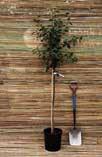

A two year tree Grown in the field to maiden stage followed by a final year as container grown A minimum of 3 branches and summer pruned (according to variety) Forming an evenly balanced shape with a clear stem of 0 8m Minimum height: 1.5m.
This section contains many forms of the more specialist fruit trees such as Hazels, Filberts and smaller sized options of Medlars, Mulberries, Peaches, Nectarines and Apricots In each case the balance and shape of the tree is proportionate to pot size and variety vigour and habit
For specification and more information on our trained fruit trees see page 96





Our ornamental trees in 12L containers are our most commonly grown form They have been grown at least one year in the field and at least one year in the pot Trees in this range are pruned several times during production This will produce a well formed balanced head of branches to suit the natural habit of the variety
The ornamental terracotta patio range includes top worked (TW) forms, shrubby trees and naturally low vigour varieties Including Malus on very dwarf M27 rootstocks
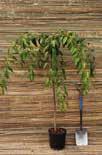


Top Worked (TW) trees are grafted at various heights from 0 45m-1 2m This is to suit the growth habit (weeping, shrubby or compact) of individual varieties and tree form created
Our 7L range includes the more unusual and slow growing varieties Sizes and shapes can vary We take every care to produce trees that are proportionate to the natural vigour and habit of the individual tree

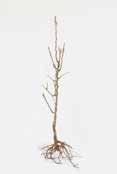
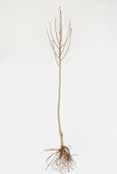
Topped at 75cm as maiden trees and grown on in the second year with a minimum of 3 branches and an evenly balanced shape on a clean stem of 0 5m
Approximate height 1.1m.
Two year trees with a trained central leader Spur pruned 3-4 times over 2 growing seasons to produce well developed fruit bearing spurs at 0 40m and above with a dominant central leader
Approximate height 1.2m.
Topped at 1 35-1 45m as a maiden tree and grown on in the second year This produces an evenly balanced shape on a clean stem of 0 80m and a minimum of 3 branches
Approximate height 1.6m.
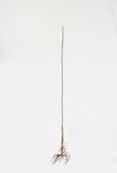

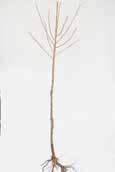
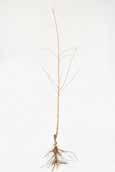
One year fruit trees from 1m – 2 5m depending on the type, variety and rootstock and feathered (branched) or un-feathered (whip) according to variety
Approximate height 1m.
A feathered two year tree ‘run on’ from a maiden in the second year This produces a straight stem and branched (according to the variety) above 0 90m Ideal for growing into a standard tree
Approximate height 1.8m.
(Note: a few low vigour heritage varieties may be shorter)
Well branched ‘commercial grade’ trees for orchard planting This includes apple and cherry trees on dwarf rootstocks M9 and Gisela 5/6 These trees are grown on the nursery in such a way so they produce wide angled branches at the optimum height for establishing cropping laterals in the first year of planting, including a strong central leader for training into the ‘A’ or ‘spindle’ shaped tree.
Trees are graded uniformly in all cases with special care taken to straightness and proportionate root/tree balance. They are offered in one minimum size only for each variety.
Supplied as one year maidens. Size will vary according to variety.
These specifications are for guidance only, as nature offers variation between varieties and within each tree form. Heights may differ depending on growing season and weather. References to ‘straightness, evenness, shape and balance’ are subjective and are used to convey a strong intention and commitment to only supply trees of a high standard
All of our trained fruit trees are available in 12L containers Forms that require more disciplined pruning, such as espaliers, cordons and step-overs, are produced with apples and pears that are more spur-bearing and respond well to hard pruning Stone fruit, such as plums, gages, apricots and peaches, prefer a lighter touch so these are only trained as fans

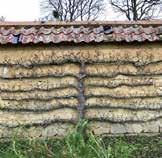


Step-over Apple

We grow our cordons on semi-dwarf rootstocks: M9 (Apples), Quince Eline® (Pears)
Specification
Grown in the field as a 2 year tree followed by a final year as container grown This growing cycle involves 4 – 6 pruning operations to develop short spur bearing branches from 0 4m upwards, with a dominant central leader Minimum height 1.4m.
We grow our espaliers on semi-vigorous rootstocks: MM106 (Apples), Quince A (Pears)
Specification
Pre trained in the field or container for two year’s followed by a third year as a container grown complete with an ‘A’ frame cane support. Reasonably symmetrical in shape, espalier a minimum of 2 tiers with a central leader Minimum height and width 1m x 1m.
We grow our fans on semi-vigorous rootstocks: MM106 (Apples), Quince A (Pears), Colt (Cherries), St Julien A and Wavit (Apricots, Damsons, Gages, Nectarines, Peaches, Plums)
Specification
Pre trained in the field or container for two years followed by a third year as a container grown complete with an ‘A’ frame cane support. Reasonably symmetrical in shape, fans will have a minimum of 5 shoots Minimum height and width 1m x 1m.
We grow our step-overs on dwarf rootstocks: M27 (Apples), Quince Eline® (Pears)
Specification
(Apples and Pears only) Horizontal supported cane framework and a single tier at 0 45m x 0 50m high x 0 9m wide
We are now growing 5-6 year old specimens including 4 tier espalier and candelabra forms for instant impact Please enquire
Our family trees are on semi-vigorous rootstocks: MM106 (Apples), Quince A (Pears) Three varieties are selected that cross pollinate well and offer a delicious choice of fruit.
Most suburban situations provide good pollen due to the close proximity of other gardens It's not always necessary to have pollinators if the bees and other pollinating insects are generous with their visits
Cherries:
Due to pollen incompatibilities pollination of non self fertile varieties is not obvious so for clarity we have specified a choice of partners�
Triploid:
Triploids are poor pollinators for any other variety They should be accompanied by two other non-triploid varieties that will also pollinate each other or one variety that is self fertile
Many varieties these days are self fertile – details are given in the fruit section
All varieties are self fertile
These are a very useful range of self fertile trees and many varieties will pollinate apples Of particular use are Golden Hornet, Evereste, Golden Gem, Red Sentinel, Jelly King and Professor Sprenger.
Fruit trees are grown on a range of rootstocks in order to control the rate of growth and the size of the mature tree� The charts below show approximate sizes of mature trees�
For more detailed information on rootstocks please visit our website.
We are often asked for native trees for gardens and woodland creation Native trees are usually defined as those which naturally arrived in Britain after the last ice age, which ended about 11,000 years ago� We grow many of these varieties as either bare root whips or as larger container grown trees, please check our stock list for availability Some native trees, such as Coryllus avellana (Common Hazel) are grown as bushes for hedging rather than as a tree For more information please get in touch
Minimum height 80cm
All stock offered is top quality transplanted heavy grade material. They’re all bare root except Ilex and Taxus which are container grown Please note all hedging orders must be multiples of 25
Hedging: 60-80cm

Native Trees & Hedging
Acer campestre (Field Maple)
Alnus cordata (Italian Alder)
Alnus glutinosa (Common Alder)
Alnus incana (Grey Alder)
Alnus rubra (Red Alder)
Betula alba pendula (Common Silver Birch)
Betula alba pubescens (Downy Birch)
Carpinus betulus (Hornbeam)
Cornus sanguinea (Common Dogwood)
Corylus avellana (Hazel)
Crataegus monogyna (Quick Thorn)
Euonymus europaeus (Spindle)
Fagus sylvatica (Common Beech)
Fagus sylvatica ‘Purpurea’ (Purple Beech)
Ilex aquifolium (Holly)
Ligustrum ovalifolium (Oval leaved Privet)
Ligustrum vulgare (Common Privet)
Pinus sylvestris (Scots Pine)
Prunus avium (Wild Cherry)
Prunus cerasifera (Myrobalan/Cherry Plum)
Prunus laurocerasus (Cherry Laurel)
Prunus spinosa (Blackthorn/Sloe)
Quercus petraea (Sessile Oak)
Quercus robur (Pedunculate or Common Oak)
Quercus rubra (American Red Oak)
Rosa canina (Dog Rose)
Rosa rugosa (Ramanas Rose)
Salix cinera (Grey Willow)
Salix caprea (Goat Willow)
Sambucus nigra (Elder)
Sorbus aucuparia (Rowan or Mountain Ash)
Taxus baccata (Yew)
Tilia cordata (Small-leaved Lime)
Tilia platyphyllos (Large-leaved Lime)
Viburnum lantana (Wayfaring Tree)
Viburnum opulus (Guelder Rose)

We can supply fruit trees for any type of orchard on any scale Our advice covers the most suitable rootstocks for the type of fruit you’d like to grow, help in selecting the very best varieties, guidance on planting distances, pollination and aftercare Alongside our own production, we work closely with several specialist nurseries to accommodate larger quantities of specific restricted varieties
Domestic orchards vary according to the size of the garden and an individual’s personal requirements. This can be a handful of carefully chosen trees or several larger trees in a paddock
Agroforestry is where trees are combined with agriculture to benefit nature and produce additional sources of income� Fruit, nut and trees for coppicing can be planted amongst other crops or with livestock to enhance the productivity of the land and provide valuable diversification
Commercial orchards can be thousands of trees, selected and managed to produce maximum yield These can focus on specific varieties for wholesale supply to retail outlets or for production such as juice or cider
An orchard will provide plenty of fruit for many years and will enhance any garden The trees also make great habitat for wildlife, so well worth planting
If you would like assistance with planting an orchard or improving an existing orchard, please email: enquiries@fpmatthews.co.uk
We offer high health status rootstocks either as one year layers or two year transplanted We specialise in clonal rootstocks for fruit but many can be used as rootstocks for ornamental trees such as Malus, Prunus and Pyrus�
Generally 9-11mm are suitable for bench grafting and 7-9mm for budding Rootstocks orders are subject to grading� Price lists are available on application�
Apple Rootstocks
M 25, MM 111 MM 106, M 116®, M 26, M 9, M 27
Pear Rootstocks
Pyrus communis, Pyrus Kirschensaller, Quince ‘A’, Quince ‘Eline’®, Quince ‘C’
Cherry, Plum and Prunus Rootstocks
St Julien A, Wavit, VVA-1, F 12 1, Colt, Gisela®
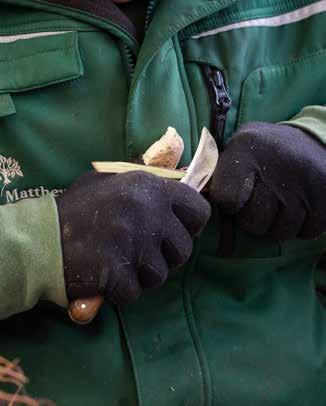
Please
enquiries@fpmatthews.co.uk
Budwood and graftwood is available subject to availability There are many more varieties available than are listed in this catalogue Varieties with PVR protection are only available to nurseries with propagation licenses� When supplying shoots, bud and yield will vary for each variety but there are approximately 6-12 buds and 2-5 grafts per shoot We will however select the most vigorous and healthy shoots at the time of collection�
Please note that we charge according to the number of buds or grafts that can be obtained from the scion wood collected, not by the number of shoots
Natural Tree Feed
Our Natural Tree Feed is a liquid concentrate containing seaweed extract and plant-derived amino acids The organic bio-stimulants encourage strong root growth and stimulate soil microbes that are essential for the efficient uptake of nutrients and trace elements� One or two regular capfuls in a full watering can will promote strong, healthy trees kept in containers Best applied in spring and summer
Endorsed by the Royal Horticultural Society, rootgrow™ mycorrhizal fungi is a completely natural planting partner which accelerates the development of highly efficient secondary root system and naturally increases the uptake of nutrients and water
A healthy abundant root system improves flowering and fruiting, reduces the need for chemical fertilisers and improves resistance to drought Simply sprinkle the sachet into the planting hole and place the tree on top of the granules ensuring the roots have direct contact As your tree begins to grow, its roots will push through the mycorrhizal fungi layer and join for life

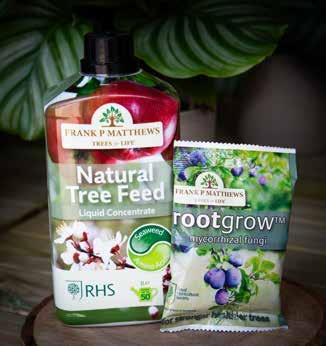
© The Royal Horticultural Society | www rhs org uk
Endorsed by the Royal Horticultural Society Registered Charity number 222879/SC038262
For our full terms and conditions please visit our website
The webpage will explain the following areas:
Standard Conditions, Delivery, General Limitations Of Sellers Liability, Payment, Force Majeure, Cancellation By Customer, Special Treatment, Contracts, Customer Commitments, Variety Clones & Product Performance, Health Status, Plant Breeders Rights, Pricing, VAT, Minimum Quantities and Special Propagation
